



In the second part of classic videogames that have inspired contemporary artists, we take a closer look at a game that the Cubists probably would have worshiped. Tetris was created in 1984 and then released officially in 1985 by the Russian programmer Alexey Pajitnov. In Tetris you have to move and rotate seven different combinations of blocks as they fall into a well. The blocks are called tetrominos and are made of four squares. The goal is to fit the different geometric shapes so that as little empty space as possible remains in the bottom of the well. Tetris is a puzzle game for people who like compact living, and who see it as a sport to pack economically to the holiday.
In contemporary art you can find three main approaches how artists have used Tetris. The Swedish artist Michael Johansson is a good example of the first approach. He has used the basic idea of Tetris to stack objects with different colors and shape. Johansson works with site-specific installations, in which he collects and stacks objects from the near surroundings in perfect symmetry with no spaces. The installations are called Tetris, which is fitting since they are strongly reminiscent of the game.

“For me creating works by stacking and organizing ordinary objects is very much about putting things we all recognize from a certain situation into a new context, and by this altering their meaning. And I think for me the most fascinating thing with the Tetris-effect is the fusion of two different worlds, that something you recognize from the world of the videogame merges into the real life as well, and makes you step out from your daily routine and look at things in a different way.” says Johansson in an interview at Gamescenes.org
Like many other classical videogames, Tetris has been used a lot in public spaces as in graffiti, mosaics and posters on facades and in subways etc. In Sydney, Australia, artists Ella Barclay, Adrianne Tasker, Ben Backhouse and Kelly Robson in 2008 at an exhibition at Gaffa Gallery created an installation where they placed giant illuminated Tetris Blocks in a narrow alley. It looked exactly as if the blocks had fallen from the sky, but the alley had been too narrow so the blocks were stuck halfway down.

The second approach is to move Tetris out from the exhibition room into public spaces and sometimes also create interactive and social art. The artist group Blinkenlights, who are known for transforming large skyscrapers into interactive screens, on various occasions making it possible for the passing public by to play Pong or Tetris on a skyscraper using a mobile phone. In 2002 they made the installation Arcade, which turned one of the skyscrapers in the Bibliotheque Nationale de France in Paris to a giant screen showing various animations, where a passersby could also play arcade games like Tetris.
The artist group Lummo (Carles Gutierrez, Javier Lloret, Mar Canet & JordiPuig) created in Madrid in early 2010, a Tetris game in which four people have to cooperate to play it. The first step for the participations was to create the Tetris blocks and after that they had to work together to place on right position in the well which was projected on a wall. In Both cases, Blinkenlights and Lummo are creating public meeting places with social interaction where the videogame is used as an interface.
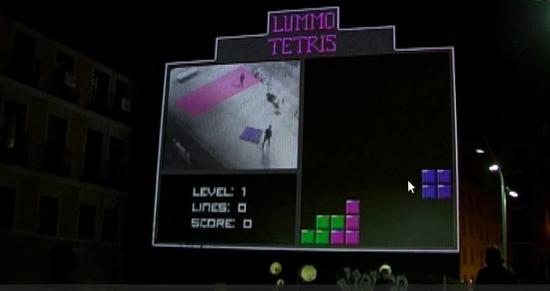
The third approach is changing the game itself and creates new versions of the game which discuss the game idea. The artist group version [url=http://www.tetris1d.org/]1d Tetris[/url], is a one-dimensional Tetris where the blocks consist of four vertical squares falling into a well that is just one block wide. Since the blocks always fill the well the players do not have to do anything to score points. The basic idea of the falling blocks still remains in the game, but in a one-dimensional world there is no longer any difficulty, the game is reduced to a very monotonous and predictable puzzle game.
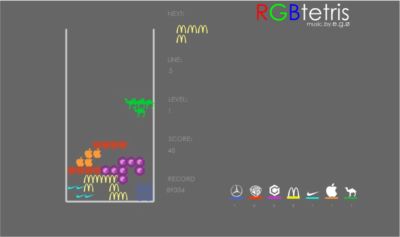
In First Person Tetris the artist David Kraftsow combines the perspective from the popular first person shooter genre (used in war and action games) with the ordinary puzzle game. In Kraftsows variant you see the game from a first person perspective so when you spin the blocks, it is not the individual blocks that are spinning around but instead the whole screen. Just by using a new perspective in the game has Kraftsow created a whole new experience of Tetris. Mauro Ceolin, who has spent many years focusing on the modern emblems on the Internet. In works such as RGBTetris and RGBInvaders he replaces the game’s graphics with contemporary icons and logos. In RGBTetris the blocks that fall down the well are exchanged with logos from Camel, McDonalds, Nike and Mercedes.
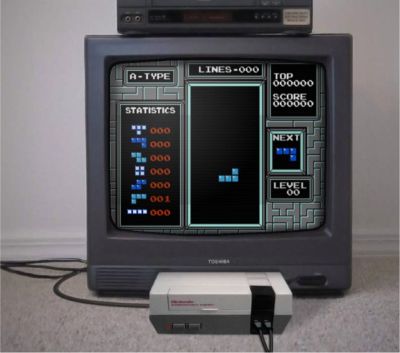
The most interesting and most independent among the playable Tetris versions that I have found are made by the Swedish artist Ida Roden. In Composition Grid she has combined her interest in drawing with Tetris. The player can play a game and in the same time create a unique drawing by rotating and changing one of the 216 different creatures that Roden has created, with the Tetris blocks as model. The player can then choose to print out their own game plan with the artist’s signature, and in that way have a unique work of art in there possession.
Tetris, this two-dimensional version of Rubik’s Cube, seems to create a lot of room for artistic experimentation. It just needs some simple changes, or new perspectives, to create a new and interesting interpretations of the game.
Videogame appropriation in contemporary art: Pong. Part 1 by Mathias Jansson.
Some of these new Tetris games can be found at these addresses:
www.rgbproject.com/RGBtetris/RGBtetris.swf
www.tetris1d.org
www.firstpersontetris.com
www.idaroden.com/composition.html
Classic video games such as Pong, Tetris, Space Invaders, Pac Man and Super Mario have in the past decade inspired many artists in their work. The common link between all of these games is that they are very easy to learn and play. There is no need for manuals, just a few simple instructions on the screen. The graphics are simple, the colours few, the characters and style are pixelated. These games have influenced a whole generation and have over time become a part of our cultural heritage. Even today, these games still amuse and fascinate players and have also inspired various artists to use them in their art. In a series of articles, we will look at some classic games and give examples of how they have been used in art and what impact they have made on the art scene. First out is PONG.
It was the American physicist William Higinbotham who in 1958 created what many consider to be the first computer game. The game was called “Tennis for Two” and was played on an oscilloscope with help of a simple analogue control.

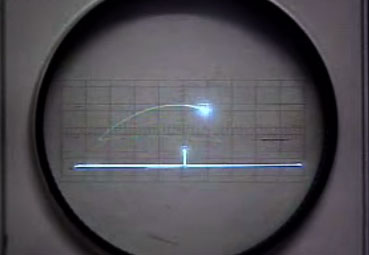
Click here to view video on Youtube…
It took, however, until 1972, when the Atari Company, founded by Allan Alcorn and Nolan Bushnell, picked up the idea and created a commercial version and called it PONG, before the game became one of the first real big sellers for the computer games industry. PONG is a simple, minimalistic game that consists of two rectangles and a square, which symbolize two tennis racquets and a ball. You can either play against another opponent or against the computer. In this simplified version of tennis, the goal is to hit the ball so the opponent misses it.
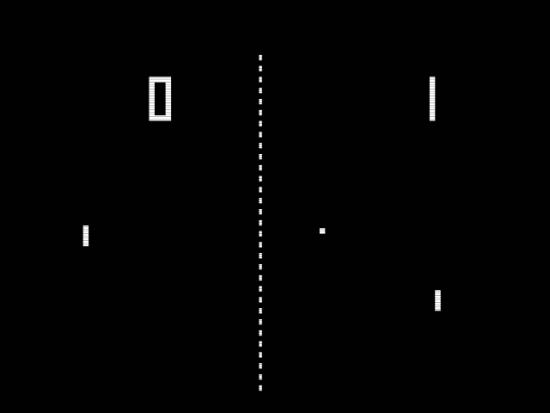
PONG is probably the videogame that has inspired most artists over the past decade. When the Computer Games Museum in Berlin in 2007 organized a major exhibition entitled “pong.mythos” over 30 artists attended with works of art inspired by PONG. The catalogue explains why PONG fascinated so many artists: “No other video game has been the origin of artistic production quite as often as the simple black-and-white tennis game. In addition to its popularity, it seems to be this minimalism that especially appeals to artists, since the playing pattern is a virtual prototype of the essence of each and every communication situation: the ball as the smallest possible unit of information, oscillating between sender and receiver” (from the catalogue “pong.mythos” 2006).
The artist group /////////fur//// showed their “Pain Station” (2001) in which the player who missed the ball were punished with physical pain, a blow on the hand, heat or an electric shock. “Pain Station” connects the physical world with the virtual and the virtual player’s mistakes turn actual real pain.
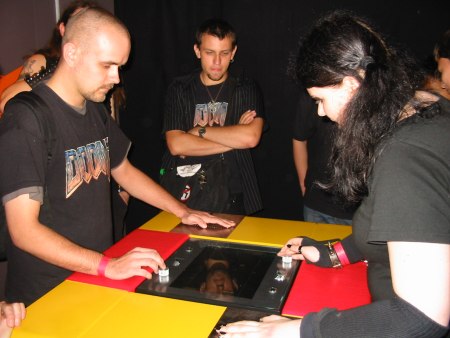
The artist group Blinkenlights working in the urban environment was represented with a project that transformed a large office building at Berlin Alexanderplatz to a digital screen where passersby could play PONG on the facade with the help of their mobile phones. In the artists S. Hanig and G. Savicic’s work “BioPong” (2005) the ball was replaced with a living cockroach where the players would try to push the insect over to the other side. And in the group Time’s Up version “Sonic Body Pong” (2006) the ball in the game was only a sound which the players could hear in their headphones and with help of large green rectangles on their heads they would try to hit the sound from the ball.
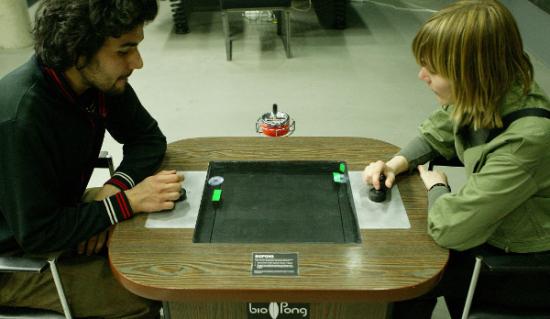
There are also many other examples that were not included in the exhibition “pong.mythos”. As early as 1999, the artist Natalie Bookchin made “The Intruder”, a work where PONG was one of 10 different videogames that she used to create an interactive artwork by Jorge Louis Borges short story “The Intruder”. The Danish artist Anders Visti mixed the game PONG with the art of Piet Mondrian in “PONGdrian v1.0” from 2007. The playing field in Vistis artwork reminiscent a painting by Mondrian but when the ball hits the fields it disturbs the lines and colour fields, and creating new opportunities and challenges for the player. Finally, I can mention the Swiss artist Guillaume Reymond, who has made a series of performances called “Game Over”. In a theatre auditorium, he creates animated sequences by using real people in colourful T-shirts, where each individual represents a square on a screen. By moving the people in the auditorium, he can create short video sequences, for example of PONG playing in the lounge.
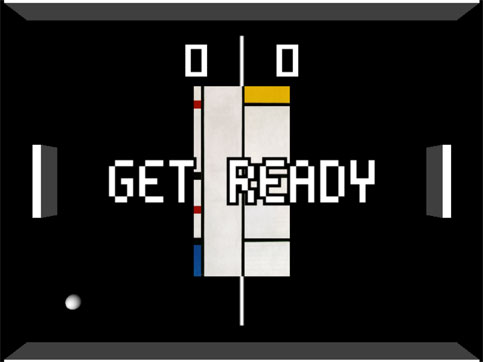
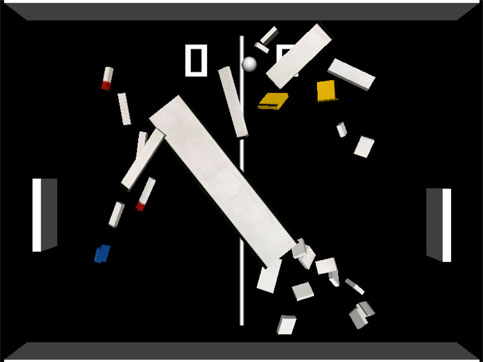
The reason that PONG is so popular among artists is that it is one of the very first video games, and therefore there is a large identification factor and a strong relationships between the game, the player and the artwork. PONG is also one of the easiest games in terms of both appearance and to learn to play, which paradoxically makes it so easy to transform and use in different contexts. The phrase “less is more” seems in this case a good explanation why PONG has inspired so many artists in recent years.
Pong Mythos – http://pong-mythos.net/index.php?lg=en
Natahalie Bookchin – The Intruder http://bookchin.net/intruder/
Guillaume Reymond – Game Over http://www.notsonoisy.com/gameover/
Anders Visti – PONGdrian v1.0 http://www.andersvisti.com/arkiv_grafik/pongdrian.html
On October 10th, 2010, the Upstage Festival of Performance Art (101010) curated by Helen Varley Jamieson, Vicki Smith, and Dan Untitled ran for approximately twenty hours, the fourth such iteration of themed dates (last year ran on 090909.) 101010 showcased thirteen new cyber performances from Canada, USA, UK, France, Germany, Italy, Sweden, Austria, Serbia, Australia, and New Zealand, most lasting for twenty minutes. UpStage was host to ten real world viewing nodes in Calgary, New York, Nantes, Eindhoven, Oslo, Ljubljana, Pancevo, Vietnam, Auckland, and Wellington. Individuals could also tune in from the comforts of their own homes.
UpStage’s audience derives from anywhere one is capable of accessing a web page, and participation does not require the installation of any new software except the ubiquitous Flash Player plug-in. The application sits on a central server, is free and open source, and programmers can add new code and share improvements and new features. Written in Python, UpStage works with third-party applications. It provides a set of tools for logged in players to work with a variety of media in real time; graphics (still images and animations), video (live web cam feeds or prerecorded video), audio (text2speech synthesized speech or prerecorded audio), text and illustrations that are collaboratively manipulated to create an improvised or rehearsed event.

Performers, euphemistically referred to as “players”, show up in the “stage” or screen area as avatars with access to a variety of pre-created backgrounds and props. When the avatars speak their words appear on-screen as a cartoon-like bubble, and their speech is simultaneously rendered in the odd robotic text2speech function. The thirteen performances were grouped into four themed categories. Temporal explored sound and movement across time and networks. Trajectory examined the path of a moving object through space, and the arc where that object intersected with the story. Tendrils wove subtle thoughts and concepts, and Transgress went beyond limits to question, challenge, and provoke.
MIT Professor Sherry Turkel in her 1995 groundbreaking book Life On The Screen first codified the anonymous audience interaction. UpStage’s appeal is its live-time interactivity that emulates the anonymity of sites like Second Life, but also employs scripted dramas that let the audience (either all of the time, or at selected moments) jump into the story. It raises the question of the difference between “stage” acting in a traditional theater, and acting in front of a virtual audience, an issue bridged by maintaining traditional chat function.
Before a scheduled performance begins, one can congregate in a virtual foyer and facilitators use a megaphone to speak in synthesized robotic text2speech voices. A second screen tab hosts the site of the virtual performance area. Depending on whom Upstage is trying to connect with, the dialogue and effects can flow swiftly, or be disrupted.

I was able to view four performances over the span of two hours. “Plaice or Sole” by Francesco Buonaiuto, Mario Ferrigno, and Simona Cipollaro (Naples) contained graphic sexual content that was presented in a purposely immature style. At first it was annoying and boring, but afterwards I was informed that was the point – to emulate and call attention to the inane comments and dialog that occur in many on-line cybersex chat rooms. A crash during the site’s interaction was a deliberate simulation of a technical failure. As one person put it, “it forced you to become engaged in the text shift.”

Active Layers, is a virtual collective includes Cherry Truluck (UK), Liz Bryce (NZ), James Cunningham and Suzon Fuks (Australia). They combine theatre, dance, video and visual arts both digitally and conceptually to redefine the meaning of location and site. Their animation piece “Aquifer Fountain” focused on drought, water, flooding, and devastation, with mothers dreaming of lost babies. During the performance the actors participated from London, Kawerau and Milwaukee.
“Make Shift” is a work in progress by Paula Crutchlow (UK) and Helen Varley Jamieson (NZ/Germany). They used the Upstage audio-visual conferencing tools in two deliberate domestic spaces to link their cyberformances, thus creating a third discursive space. The discussions focused on the political aspects of domesticity such as “nesting, feeding and mobility,” and how this relates to the experience of globalization.
“MASS-MESS ” by Katarina DJ. Urosevic & Jelena Lalic (Serbia) ran both virtually and at the physical node at Galerija Elektrika in Pancevo. It was a study of structures, mass media and independence in the context of a hierarchy of information without a center playing out like a post-Soviet Politburo manifesto. “MASS-MESS” made it onto Serbian TV, as evinced by a subsequent newscast posted onto YouTube.
What is an experiment? I get the sense that many of monochrom’s projects seek to interface with the world (ahh, but what world might that be?) In a sense, I am curious about how you imagine the field, what objects you see upon it, what things call themselves objects but are perhaps only specters? How can non-existent artists save non-existent countries?
Yes, we love experiments. And we approach them like committing a crime: very, very carefully. Still, we know that there’s no perfect crime and we are going to make some mistakes. The main problem with our artistic and activist work is, and that might sound strange: subversion.
Only thirty years ago Western societies were still governed along the principles of the “disciplinary society”. The institutions of a disciplinary society are founded mainly on two devices that keep its subordinates where they are: control and punishment. Both are certainly effective, yet they produce at least an inner resistance, as well as the possibility to avoid either. It’s hard to monitor in absolute terms, and there are always ways of avoiding, if not “hacking” and ridiculing these mechanisms of control. Loop-holes will be identified and used.
The disciplinary society was one that created refractoriness; it revealed hierarchies and blatantly opposing classes of rulers and the ruled. These small acts of individual resistance also instigate models of theoretic and actual resistance on a grander scale.

The society of control has however shifted this device and transplanted it into the subjects themselves. As soon as control is collectively internalized, when control is part of the psychological apparatus and of thought, then we can speak of control in absolute terms. Not much can be done anymore, as no one is independent from, or outside of, control any longer.
We have to be aware of this change and have to analyze and adjust our attacking strategies. Companies like Nike already use Graffiti as a standard variety in their marketing campaigns and the first people who read Naomi Klein’s No Logo were marketing gurus who wanted to know what they shouldn’t do. We certainly can change the political economics of a society. And you can quote me on that. But we have to be precise about it. Just playing around might only make our actions end up as a funny 15-seconds-clip on CNN, and that would be useless. We have to understand cognitive capitalism or we will just be going round and round in the same old circles, as the history of guerrilla communication clearly shows.
How can we subvert a system that actually wants you to subvert it? You can only experiment. And fail.
Well, since beginnings are first (except of course when they aren’t) it would be interesting to hear a bit about the inception of monochrom back in 1993.
I was always interested in obscure crap, even as a kid. I loved science fact (Carl Sagan is still my only media idol) and science fiction, especially John Brunner and William Gibson. And I was always interested in the political dimension of near-future sci-fi. It’s hard to imagine, but I became a punk and antifascist because I devoured cyberpunk novels and watched stuff like Max Headroom. It was great dreaming of a jack in the back of your head, but the corpocratic, doomed world was nothing that I wanted to really happen. I joined the FidoNet data network when I was thirteen or fourteen, around 1988 or 1989. It was a wonderful way to get in contact with weirdos from all over the planet, collecting info and interesting mailing list threads, and slowly but surely my wish to start a publication grew. So monochrom started in the early 1990s as a print fanzine about cyber-topics, politics, bizarre art and covert culture.
What were the circumstances or impetus for Monochrom’s formation? How do you find the world around monochrom has changed since you began?
There was some stuff in the US of A, like Mondo2000… but it was all too hippie-ish, too liberal, indulging in what Richard Barbrook and Andy Cameron later called the “Californian Ideology”. I wanted to share and propagate a leftist European perspective. As a member of several bulletin board systems I sent out mails to a couple of message boards, looking for collaborators, and Franky Ablinger replied in only two hours. And so the monochrom group, or better, “the monochrom culture,” was born. We published a couple of issues, low circulation, and – as the name suggests – we were barely able to finance the black and white xeroxes. But we kept working, creating our first internet site in early 1994.
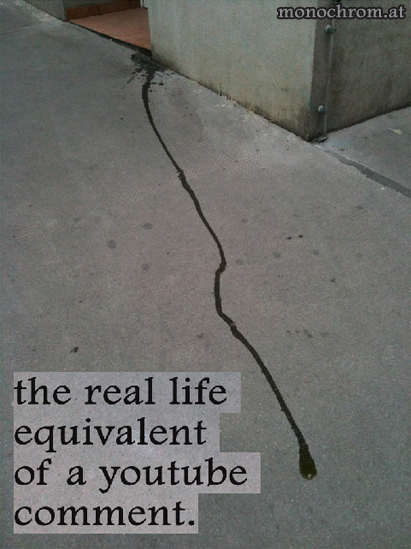
In 1995 we decided that we didn’t want to constrain ourselves to just one media format (the “fanzine”). We knew that we wanted to create statements, create viral information. So a quest for the best “Weapon of Mass Distribution” started, a search for the best transportation mode for a certain politics of philosophical ideas. This was the Cambrian Explosion of monochrom. We wanted to experiment, try stuff, find new forms of telling our stories. But, to be clear, it was (and still is) not about keeping the pace, of staying up-to-date, or (even worse) staying “fresh”. The emergence of new media (and therefore artistic) formats is certainly interesting. But etching information into copper plates is just as exciting. We think that the perpetual return of ‘the new’, to cite Walter Benjamin, is nothing to write home about – except perhaps for the slave-drivers in the fashion industry. We’ve never been interested in the new just in itself, but in the accidental occurrence. In the moment where things don’t tally, where productive confusion arises. That’s why in the final analysis, although we’ve laughed a lot with Stewart Home, we even reject the meta-criticism of innovation-fixation articulated in ‘neoism’. The new sorts itself out when it lands in the museum. Finito.
Some guy once called us ‘context hackers’ because we carefully choose the environment we want to work in and then try to short-circuit it. Some projects definitely work better as a short film or installation or puppet theatre or robot or performance, some should simply be presented as ASCII files … and some are the right stuff for a musical. It just depends.
What happened to the fanzine?
Well, it’s unbelievable, but we still publish it, but not on a regular basis. We decided to switch to a “phatzine format” or call it a “magazine object”. It’s huge. The last one was released in March 2010… it’s #26-34, an accumulation of 500 pages and 2 kilograms. It can break your toe if you drop it! It’s still a good mix of science, DIY, theory, cultural studies and the archeology of pop culture in everyday life. With a great deal of forced discontinuity, a cohesive potpourri of digital and analog covert culture is pressed between the covers. We try to offer an un-nostalgic amalgam of 125 years of Western counterculture – locked, aimed and ready to fire at the present. Like a Sears catalog of subjective and objective irreconcilability – the Godzilla version of the conventional coffee table book.

What are your thoughts on contemporary zoology?
I always loved the grand dichotomies of life. Dogs and cats. Cats and mice. Like Tom and Jerry. But as someone who grew up in Central Europe I never understood how a mouse can live inside a wall. Walls are made of bricks! They are not hollow. Way later I came to understand when I learned that US-American houses are just made of wood, and their walls are really hollow.
Have you ever been walking down the street, mobile phone in hand, and thought of throwing it on the cement, giving it a few good dancing stomps and darting off?
Yes. Even better. We did a workshop called “Experience the Experience of Catapulting Wireless Devices”. The catapult is one of the oldest machines in the history of technology. It is no coincidence that we instigated a creative return. The knife edge of technology hype is sharp, most of all on the West Coast of the United States. Thus we initiated a competition. We invited interested persons to design and build a catapult capable of hurling a cell phone or a PDA unit the greatest possible distance. In order to ensure that no participant had any unfair advantage, we provided a specifications list regarding materials (e.g. metal) that were not to be used and other limitations (e.g. size and weight). And we only tolerated WIRED Magazines as counterweights. That was fitting.
Were you in Berlin when the wall was taken down?
I was asleep, at home. But I always wonder what the official web site of the GDR would look like if they were still around in 2010. Would they use Flash? Or HTML5?
Fanta or Coke?
Fanta originated when a trading ban was placed on Nazi Germany by the Allies during World War II. Coca-Cola GmbH, therefore was not able to import the syrup needed to produce Coca-Cola in Germany. As a result the company decided to create a new product for the Nazi market, using only ingredients available in Germany at the time, including whey and (yummy) pomace. They called it Fanta. So I guess, what’s the difference?
Read part 1 of this interview:
http://www.furtherfield.org/interviews/interview-johannes-grenzfurthner-monochrom-part-1
Read part 2 of this interview:
http://www.furtherfield.org/features/interviews/interview-johannes-grenzfurthner-monochrom-part-2
The Zero Dollar Laptop Workshop programme has been developed and delivered through partnership between Furtherfield and Access Space and aims to change attitudes to technology. It does this by recycling hardware, deploying Free and Open Source Software (FOSS), sharing skills and working together to create rich media content.
This project has provided a useful basis for thinking about how art might be able to create change through learning and education that relates to technology.
This question becomes especially relevant in the context of current, global economic and ecological collapse.

So first let’s start by thinking about what art and technology and social change have got to do with each other?
It does depend on how you view art. At Furtherfield we don’t accept the mainstream view of art as a marginal interest. The expanded, connected and networked art forms that we choose to work with cannot be separated from life so easily.
They engage the people who encounter them with different kinds of aesthetic, ethical and philosophical experiences – often in places not easily recognisable as art-spaces, often in technologically enabled spaces because this is where life takes place for so many people.
For all kinds of reasons (to do with our education and class structures), in the UK the dominant view is that ‘great’ art is separate and distant from the rest of life and therefore of marginal relevance to society and most people, or to quote Heath Bunting ‘Most art means nothing to most people’.
It is regarded as: elite/intellectual, historical/heritage, commodity, the work of charlatans etc.
Sometimes art is regarded perhaps more positively, as a diversion or a hobby; more positive from our point of view because people make art their own, share it and incorporate it into their own lives on their own terms.

Don’t just Do It Yourself, Do It With Others (DIWO!)
Furtherfield got started in the context of the discourse-smothering London Brit Art gallery scene in the mid-90s, when access to established galleries was carefully guarded. Meanwhile the Internet, an open public space of unlimited dimensions, was relatively sparsely populated at two extremes by corporate marketing departments and pet owners. The Internet also offered a free playground for early net artists.
Since then Furtherfield has co-constructed platforms and processes (online and in physical spaces) with a network of other artists, hackers, gamers, programmers, thinkers and curators to support collaboration and engagement between artists, participants and audiences worldwide.

Informed by ‘open and free’ philosophies and practices of peer-to-peer cultural development and moving on from the DIY (Do It Yourself) approach of the 1990s artist-hackers that fed on the Modernist understanding of the individual artistic genius, we have moved towards more collaborative processes that we call DIWO (Do It With Others) and that explore different ways of creating shared visions.
For us taking a grassroots approach in art means that we pay attention to the everyday lives of the people we work with, to create and shape the platforms that we need. This is not a hippy dream. Rather, it provides a way to develop robust and healthy ways for diverse people and interests to interact and co-exist for mutual benefit.

Since 2008 Furtherfield and Access Space have worked in partnership on the Zero Dollar Laptop project, to support cooperation in creativity, technical learning and environmental awareness. One side-effect of techno-consumerism is that we dump tonnes of UK electronic waste in the developing world each year.[2]
This project, inspired by James Wallbank’s Zero Dollar Laptop Manifesto, aims to change the way we think about technology by a shift of emphasis: from high-status consumer technologies to customised tools-for-the-job and smart, connected users.
Our organisations have worked together with participants to develop resources and pilot workshops that aim to eventually bring back into use (or save from toxic waste dumps) millions of redundant laptops currently gathering dust on shelves in homes and offices across Britain; putting them in the hands of the people who are best placed to make use of them, to benefit from a collaborative approach to learning and to connect with new knowledge networks in the process.
This project has its basis in grassroots, critical practice at the intersection of art, technology and social change.

The first pilot of Zero Dollar Laptop workshops kicked off at the Bridge Resource Centre in West London in January 2010 with clients of St Mungo’s Charity for Homeless People. [3]
In our experience, a much more diverse group of people are able to enjoy and benefit from technical projects when the projects acknowledge and incorporate ethical, philosophical and aesthetic questions as part of the mix.
People who might not initially identify themselves as ‘techy’ stay engaged with complex technical learning processes by focusing on the learning that is meaningful for them and sharing it with others.
In the case of Zero Dollar Laptop workshops this can range from creating a profile image for Facebook to writing a blog post to lobby against government cuts in public services, or creating a desktop background or a new startup-sound to customise their own laptop.
The meaning and function of work is often conveyed by the construction of a context (a place, a set of tools, an aesthetic, a set of relationships) or a hack or remix of an existing context.
With participatory or collaborative artworks the context in which people engage with the work is a part of the work.
So the role of the artist today has to be to push back at existing infrastructures, claim agency and share the tools with others to reclaim, shape and hack these contexts in which culture is created.
We believe that through creative and critical engagement with practices in art and technology people become active co-creators of their cultures and societies.
And as James Wallbank notes, ‘the best artworks are those that create artists’.
Originally commissioned by Axisweb.
All Raise This Barn – a group-assembled public building and/or sculpture.
“Artists MTAA are conducting an old-fashioned barn-raising using high-tech techniques. The general public group-decides design, architectural, structural and aesthetic choices using a commercially-available barn-making kit as the starting point.” -MTAA
Eric Dymond: Could you give me a brief history of MTAA?
T.Whid: Mike Sarff (M.River of MTAA) and I met in college at the Columbus College of Art & Design in Columbus, OH. We both separately moved to NYC in 1992 and started collaborating as MTAA in 1996 first on paintings and then moving on to public happenings and web/net art. We’ve been collaborating since, showing our work via our websites at mteww.com and mtaa.net. We’ve earned grants and commissions from Creative Capital, Rhizome.org and SFMOMA and shown at the New Museum, 01SJ Biennial, the Whitney Museum and Postmasters Gallery.
ED: The All Raise This Barn project uses one community to design and another to construct. Barn raising is itself a communal activity, drawing out the best in people and providing a place of sustenance for the Barn owner. How did you come to use a Barn Raising as the central performance subject?
M.River: From the start, Tim and I have been interested in how groups and individuals communicate. How do we speak to each other? What rules do we use? How does communication fail or how can it be disrupted? What is the desire that engines (TW: controls?) all of this – and so on. This interest in exchange is what attracted us to the Internet as a site for art in the beginning.
Along with communication as text, speech or image, we like to use group-building as a method for working with non-verbal communication. We’ve built robot costumes, car models, aliens and snowmen with large and small groups. It’s a type of building that is intuitive and open to creative improvisation. This kind of intuitive building is heightened by placing a time constraint on the performance. In the end it’s not about the end object, which we always seem to like, but more about the group activity.
So, at some point we began to think how large can we do this? A barn-raising seemed like the next level. It’s bigger than human scale and contains a history of group-building. Barns also have a history of being social spaces. Your home is your world but the barn is your dance hall.
ED: Did you envision it as a community event from the beginning?
MR: Yes. An online community, a physical community and a community that overlaps the two.
ED: It’s a hybrid work that draws upon some important conceptual precedents. The instructional aspect takes Lewitt and turns the strict instructions he uses upside down by allowing online decisions to drive the design. Did you find the responses to the online polling surprising?
MR: Yes and no. Like the other vote works we have produced, Tim and I set up how the polls are worded and run. So, even though we try to keep the process as open as possible, the nature of how people interact is somewhat fenced in. Even with a fence, people will find a way to move in strange directions or break the fence. It’s not that we think of the surprising answers as the goal of the work, but it is an important part of the process.
ED: There is also the performance aspect which I find exciting. The performance from both events are well documented. Were there any concerns regarding the transfer of the polls instructions to physical space?
MR: We had the good fortune of doing the work in two sections. When Steve Dietz commissioned ARTBarn (West) for the 01SJ Out of the Garage exhibition, we spoke about the sculpture as a working prototype for how a large pile of lumber could be group-assembled in a day with direction from Internet polling. From this prototype we then had a model for how to go about ARTBarn (East) for EMPAC.
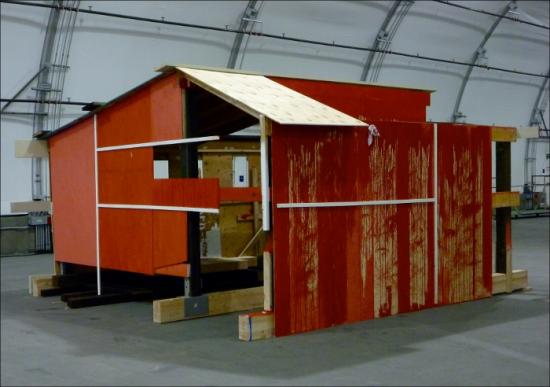
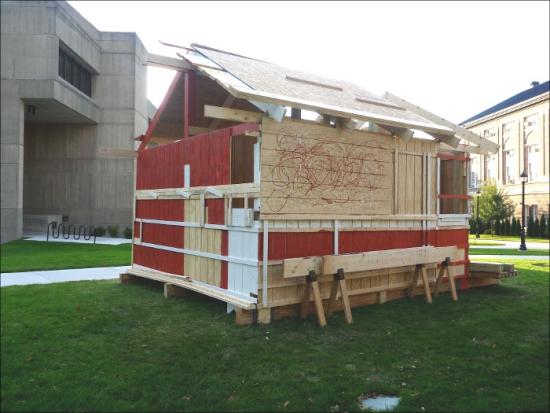
Tim and I had a few loose ground rules on how to approach the translation. One was that we would leave some things open to the interpretation of the crew. Another was that both Tim and I had our favorite poll questions that we tended to focus on. It was impossible to do everything as some polls conflicted with other but some details liked ghosts, dripped paint and open walls seemed to call out to us.
Kathleen Forde, who commissioned ARTBarn (East) for EMPAC, spoke about these details as where the work became more than the sculpture. The small details held the whole process – material, design polls, and performance together.
ED: I think this comment on the details is right. On first glance there is a fun, open appeal to the work. But when you look at the overall project and how the different phases are tied together it becomes really complicated in the mind of the spectator. There are also different definitions of spectator in this work. The spectator who answers the poll, the spectator on the net who is grazing through the documentation, the ones who engage in the physical construction and those who witness the completed barn. It’s not a simple piece when we perform a detailed overview. Did you think about the various types of spectator that would spin off the project? Were the possible roles for the spectator considered after the fact or were they part of the planned concept?
MR: The “ideal spectator” thought first came up for us in a project called Endnode (aka Printer Tree) in 2002. For this work, we built a large plywood Franken-tree with a set of printers in the branches and a computer in the trunk. We then built a list-serve for the tree as well as subscribed it to a few list-serves. When people communicated with the tree, the text was printed out in the exhibition space. At first we talked about the ideal viewer as one who communicated with it online and then saw that communication in the physical space or vice versa.

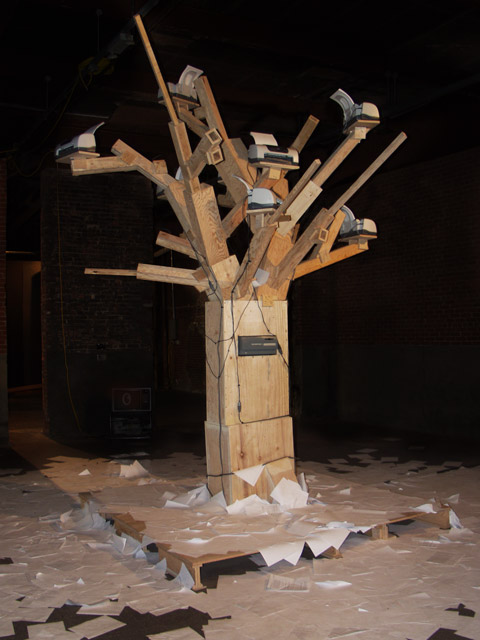
Now I feel that the ideal spectator hierarchy is not as important and possibly limiting. Each experience should be whole as well as point to the larger aspects of the work. People can come in and out of the work on different levels. You voted. You followed the performance documentation. Are you missing an experience if you did not build with us or see the results? Yes, an activity is missed. Can you experience that activity thorough documentation. Somewhat. Are you going to have a better understanding of the work. Probably not. Even for me, some aspect of the work will not be experienced. In Troy, they are programing it as a meeting place now that is it is built.. When they are done with it, they will dismantle it and rebuild it elsewhere as a work space.
I say all this even though it is interesting to me that a work can move in and out of levels of viewer experience. I’m not sure as to the draw of it yet but I do not feel it is about an cumulative effect.
TW: Since Endnode I’ve always liked the idea of an art work that exists in multiple (but overlapping) spaces with multiple (but overlapping) audiences. With our pieces Endnode, ARTBarn and Automatic For The People: () there are 3 distinct (but overlapping) audiences: the online audience, the audience in the physical space and the (select few member) audience that experiences the entire thing.
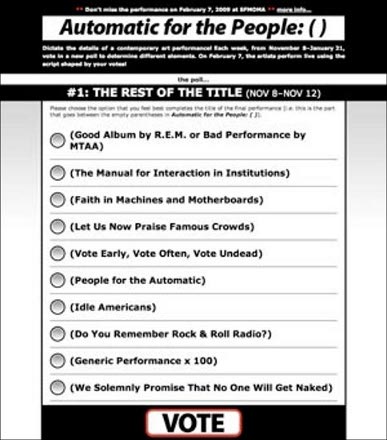
ED: It’s that opening of possibilities that makes this ultimately a networked piece on many different levels. I find the idea of two barns, a few thousand miles apart yet linked by common purpose really intriguing. I’m talking about the whole set of experiences, not just the physical space of the barn. There’s a collapse of Geographic distance for the community and a richer experience because of that. Was the project conceived as two distinct locations or was that a fortunate turn of events?
MR: Fortune. Kathleen Forde, commissioned ARTBarn (East) for EMPAC then Steve Dietz commissioned the beta version for the 01SJ “Out of the Garage ” exhibition. Everyone liked the idea of the work arching across time and location. We all also liked the idea that the materials would be reclaimed after it stopped being a sculpture. For me, the reclaimation of the materials to use for a functional structure is the final step of the work.
ED: As the final step, the reclamation removes the common space where the community currently shares the sculpture. Does this mean you are going to use the online documentation as the artifact, coming full circle to where the piece began? Is it important to you that the communal memory will share this role?
TW: Yes, the documentation is the artifact. The barn structure or sculpture itself had been conceived as being physically temporary from the beginning.
ED: Thanks to both of you for your time and for this work.
In 2002, when Monochrom was invited to act as the representative of Austria at the Sao Paulo Biennial, instead of going as yourselves, you sent Georg Paul Thomann, one of the country’s most prominent avant guard artists, and also a complete fabrication.
Yes, we were asked to represent the Republic of Austria at the Sao Paulo Art Biennial, Sao Paulo (Brazil) in 2002. However, the political climate in Austria (at that time, the center-right People’s Party had recently formed a coalition with Jorg Haider’s radical-right Austrian Freedom Party) gave us concerns about acting as wholehearted representatives of our bloody nation. We dealt with the conundrum by creating the persona of Georg P. Thomann, an irascible, controversial (and completely fictitious) artist of longstanding fame and renown. Through the implementation of this ironic mechanism – even the catalogue included the biography of the non-existent artist – we tried to solve with pure fiction the philosophical and bureaucratic dilemma attached to the system of representation.
It gave me something of a hearty guffaw to hear about how you and your fellows, manning the Austria country booth as the artist’s technical support staff – the lowliest of low in the art world hierarchy – went about revealing the fictitious nature of the artist.
Yes, we turned the tables. When members of the administration, journalists, or curators asked about the whereabouts of Thomann, our irritated answer was that he hadn’t cared to show up so far, and that he hadn’t helped with anything, because he was supposedly watching porn in his hotel room all day, while we – the members of his technical crew – didn’t care about that bullshit at all. But we informed other technical support teams about the basic idea of the project. They were also given detailed information about Thomann’s non-existence but we did not give them any hierarchic directives about what to do with their knowledge but left it up to them if they wanted to reveal the fake or keep spinning the story. Most people enjoyed doing the latter and they also kept telling different versions of the heard information until finally a bubbling geyser kept erupting in various ways and constantly led to new outbreaks of tittle-tattle.
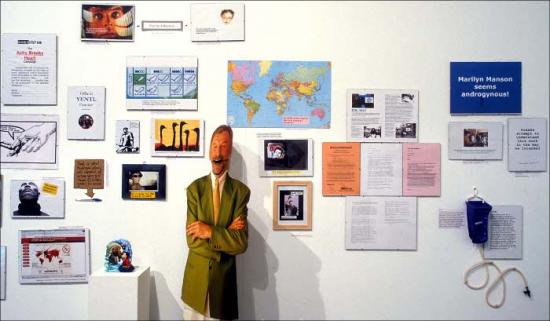
What happened next, as I heard you describe it, was that “bubbles and bubbles of rumors” began to form around the expansive floor of the biennial. I found this moment in the arc of the project to be particularly interesting and was hoping you could perhaps share some of your thoughts and recollections.
Let’s give you a brief summary of the background. The basic principles of an art-super-structure like a Biennial is simple: lots of little white boxes in which art was set up – and little artists, spreading business cards like prayers. There is a nice German term: “die Warenformigkeit des Kunstlers” (“the commodity value of the artist”). We hardly had any contact with other artists… and that was bad. They came from more than 80 different countries, but they were hiding in their white boxes. Everyone was busy building his or her own little world. Then, during the final setup phase we found out about an incident, which took place in our neighborhood through a copied note.
One year before the Biennial, Chien-Chi Chang had been invited to be the official representative of Taiwan at the Biennial. But then, three days before the opening, his caption – adhesive letters – had been removed from his cube virtually over night. ‘Taiwan’ was replaced with ‘Museum of Fine Arts Taipeh.’ But to Chien-Chi Chang the status as an official representative of Taiwan was very important, because his photography artwork dealt directly with the inhumane psychiatric system in Taiwan.

Chien-Chi was trying to get in contact with the Biennial administration and the chief curator (the German Alfons Hug), but didn’t succeed. Communication was refused. After that he decided to write an open letter, but the creative inhabitants of all the little white art-combs didn’t seem too interested in the artist’s chagrin, who by now wanted to leave the Biennial out of protest.
We were interested in the situation and did some research. We found out that the Chinese delegation had threatened to withdraw their contribution and to cause massive diplomatic problems. To them, Taiwan was clearly not an independent country (c/f ‘One China Policy’) and they put pressure on the Biennial management to get that message out. The management did not make this international scandal public and it was quite obvious why.
monochrom decided to show solidarity with Chien-Chi. We wanted to set an example and show that artists do not necessarily have to internalize the fragmentation and isolation that is being imposed upon them by the structure of the art market, the exhibition business, as well as the economy containing them. For us, though, this is not about taking a stand for either the westernized-economical imperialism represented by Taiwan or for China’s old-school Stalinist imperialism. This is about integrity and solidarity, values that we chose to express through a collaborative act. Together with other artists from various countries we launched a solidarity campaign: we took off some adhesive letters of each collaborating country’s signature and donated them to Chien-Chi Chang. monochrom sponsored the ‘t’ of Austria, while the Canadians donated one of their three as. The other participating artists were from Croatia, Singapore, Puerto Rico and Panama. A lot of artists and curators from other countries refused to support the campaign for fear of – as they would call it – “negative consequences.” WTF? But at least some of the artists were pulled out of their self-referential and insular national representation cubes which, in themselves, so rigorously symbolized the artists’ work and his or her persona as commodities.

After some time we managed to attach a trashy, yet legible ‘Taiwan’ to the outside wall of Chien-Chi Chan’s cube. Numerous journalists took notice of the campaign and Chien-Chi opened his exhibition in front of a cheering audience. Some days later, we found out that Chinese and Taiwanese newspapers massively covered the campaign. One Taiwanese paper used the headline “Austrian artist Georg Paul Thomann saves ‘Taiwan’.” In other words, a non-existing artist saved a country pressed into non-visibility. Who said that postmodernism can’t be radical?
What was it like – even from a kind of phenomenological sense – to be in the midst of this bubbling, to experience the formation of a scandal from its very embryonic moments? Is there something in the interiority of situations like this that you see as essential to the creation of new kinds of solidarity?
First we would have to define what “new kinds of solidarity” mean. What would be the ‘new’ part of it? Does it go beyond old and traditional forms of solidarity? And why should it? I think that classic forms of solidarity were carried out by political groups or other collective entities. They tried to express their (let’s label it as) “old-school solidarity” by pointing their collective fingers at someone who they thought were mistreated: “Look, look this human being is being oppressed!” And they always did it “in the name of something”. Old-school solidarity was one more frickin’ medium that people used to get a message across. Thus it was always part of the realm of representation. Your act of solidarity represents the one you show solidarity with, but your act is also advertisement for yourself, your cause and the (political) identity you wish to construct. Politics is always drama. Best example for this would be the “supporters of Palestine”. There are tons of ethnic groups on this rusty little planet who have to suffer under worse conditions. But nobody seems to be interested in showing solidarity with them. Where are Henning Mankell and Noam Chomsky when you really need them? Involved in some stupid fast-food anti-imperialism. We have to understand that the “object of solidarity” is something you pick for a reason… and most of the time it’s to feel good as a group and to impress your peers. But that has nothing to do with factual, non-reductionist political analysis. Collective entities define themselves through acts of representation and this representation is comparable to the construction of national pride or patriarchal family structures and values. Solidarity can be read as an act of defining identities. And that can be very dangerous, because old school solidarity always wants to be “right”. You are always “the good one” supporting the poor bastards. Smash dichotomies!
What we experienced at the Biennial of Sao Paulo back in the spring of 2002 was a very non-collective act. We were no real group, no leaflets, we had no common agenda, we were a psycho-geographic swarm. There was no basis for acting or speaking as a collective and there was no need to bundle our powers or form an identity. Yes, we tried to recruit other artists to join in our little act of solidarity. But it was no protest, we didn’t protest a certain political agenda because we didn’t want to end up in the old black and white world that, for example, all the apeshit Pro-Tibet supporters live in. Bah! Their ugly flags! Their patriarchal projections! Richard Gere! Yuck! So it was a kind of “free flowing solidarity”, not to be abused to form a political movement or statement. The only form of identity that was formed was the simple idea that even bourgeois artists can decide whether they want to be part of the Biennial and its stupid rules or whether they want to be part of action and fun.
To make it short: we are interested in micro-political solidarity, temporary solidarity that can’t fossilize. Solidarity is important if it can evolve and vanish within a short span of time and all that’s left is rumors and vague commemorations. Let’s call it a process of counteracting – that might be well-known in the field of the urban guerrilla but that so rarely pops up at art shows.
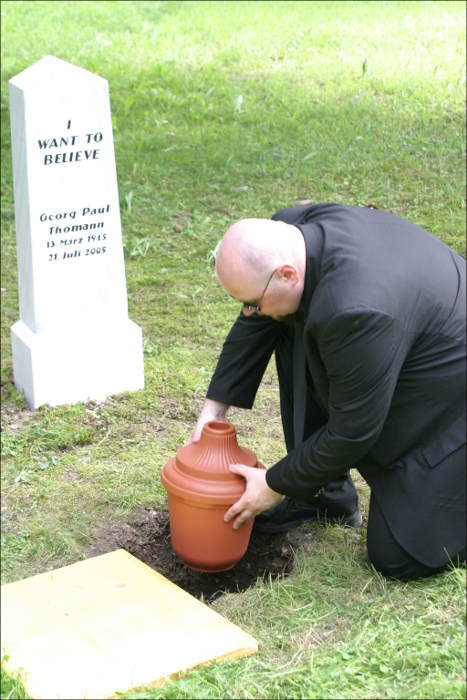
Read Part 1 of the Interview
http://www.furtherfield.org/interviews/interview-johannes-grenzfurthner-monochrom-part-1
Read Part 3 of the Interview
http://www.furtherfield.org/features/interviews/interview-johannes-grenzfurthner-monochrom-part-3
Between July 27th and August 29th, 2010, the eleventh edition of the FILE festival is taking place in Sao Paulo (Brazil), at several locations along the popular Paulista Avenue. After a decade of existence, this veteran festival, which spreads over several cities in Brazil (including Rio de Janeiro and Porto Alegre) as well as other international locations, has introduced for the first time its own award: the FILE PRIX LUX. With a total amount of approximately 120,000 euros, distributed in three categories, the prize is unprecedented in the continent and has received, on this first edition, 1,235 registrations from 44 countries.
Yet this award is not the only remarkable aspect of this year’s festival, which stands out for being particularly accessible to the general public. On the one hand, the exhibitions, performances and workshops as well as the symposium have no entrance fees, and therefore there have been many visitors, most of all young people who line up every day to experience the interactive installations at the FIESP-Ruth Cardoso Cultural Centre. On the other hand, the festival organizers, Ricardo Barreto and Paula Perissinotto, have developed this year a project that takes digital art to the Paulista Avenue by placing several interactive artworks at different locations in the public space. Finally, even the FILE PRIX LUX has been open to the interaction with the public by introducing a popular vote category and an online voting system which was accessible between May and June. This openness sets a good example of how media art festivals can engage the general public to approach this somewhat ignored form of art.
In general terms, the award categories at media art festivals have been subject to change as the creative uses of technology evolved during the last decades. The FILE PRIX LUX has the advantage of being created at a time in which it can be relatively safe to set up a few broad categories that cover most of the forms of combining art and technology. Only three categories have been established: Interactive Art (which usually refers to objects and installations that respond to inputs from the viewer/s), Digital Language (related to the festival’s title and which embraces any artwork that deals with language, narrative, code or text in a generative or interactive manner) and Electronic Sonority (the category assigned to any artwork in which the production or manipulation of sound is a key element). These three categories prove to be comprehensive, as shown by the diversity of the projects distinguished with a prize or an honorary mention: immersive interactive installations, musical performances, urban interventions, bioart pieces, a collectively created machinima movie and even an iPhone app are among this year’s FILE PRIX LUX awardees.
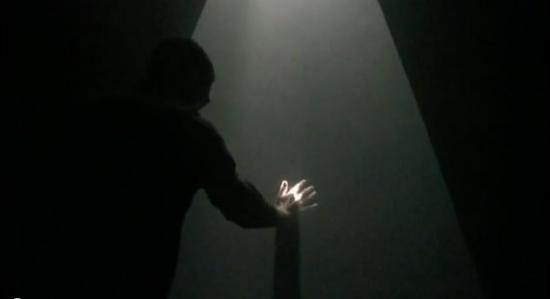
In the Interactive Art category, the winners are Ernesto Klar for Relational Lights (1st prize) and Kurt Henschläger for Zee (2nd prize). Both present immersive environments in which light and space are key elements, although the interaction is totally different. Klar’s work invites the viewer to interact with two projected geometric drawings inspired by the work of Lygia Clark. In a hazy dark room, the viewer sees two T-shaped projections of white light on the ground, which form a three-dimensional space which reacts to the visitor’s presence. The interaction is playful and really beautiful in its simplicity, whilst also limited in time: after a few minutes, the projections suddenly stop reacting to the user’s movements and reconfigure themselves in a new shape. This abrupt interruption is consciously introduced by the artist in order to remind the viewer that the artwork has a life of its own. In contrast, Henschläger’s Zee takes place mostly in the mind of an audience exposed to an overdose of audiovisual stimuli in a foggy room. Continuing the experience of his acclaimed performance FEED, this time the artist allows the viewer to walk around the space and have a more meditative sensory experience.
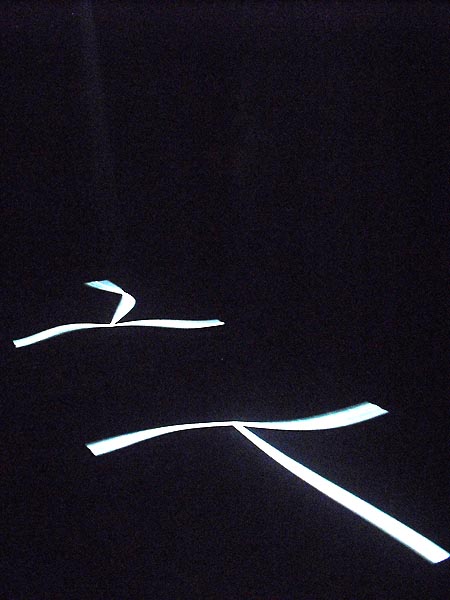
The Electronic Sonority category has brought together several outstanding works, among which Jaime E. Oliver’s Silent Percussion Project and TERMINALBEACH’s Heartchamber Orchestra have been distinguished with the 1st and 2nd prize, respectively. In both projects the human body is incorporated in a novel form in the creation of music, the sound being produced, moreover, not simply by direct inputs but by complex interactions in a constant flow of data. Oliver’s instruments convert the shapes created by the performer’s hands into streams of data that generate, in turn, different sounds. These sounds are not always the same, as could be the case in a traditional instrument, but are changed by the variables established in previous interactions. Thus, Oliver does not simply create a new form of interacting with an instrument but rather a new form of creating music. In a similar way, the [i]Heartchamber Orchestra[/i] project developed by TERMINALBEACH (Erich Berger and Peter Votava) explores a form of creating music based on a feedback loop in which the performers are writing and following the score at the same time. As the artists state, in their project “the music literally comes from the heart”: a network of 12 independent sensors record the heartbeats of the musicians in an orchestra and sends the data to a software that generates a musical score in real time. The musicians play the score as it is displayed on the laptops in front of them, while their heartbeats set the notes in a continuous cycle in which music and performer constantly influence each other.
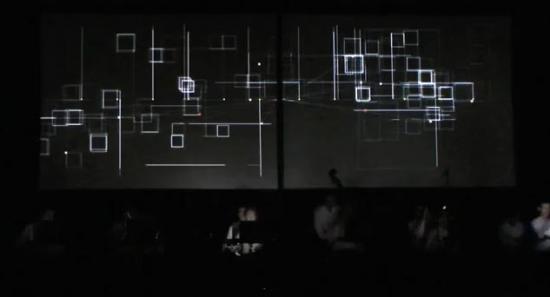
Digital Language is certainly the broadest category of this FILE PRIX LUX, its awardees being quite dissimilar in the formats they use and the objectives of their respective projects. The organizers define this category as including “all research and experiments in the ambit of the multiple disciplines that use digital media”, and the winners exemplify how diverse these disciplines can be. The 1st prize winner, Tardigotchi by the artists collective SWAMP (Douglas Easterly, Matt Kenyon and Tiago Rorke) is a bioart project that sets a critical comparison between artificial and real life. A nicely designed, steam punk-inspired device hosts, on the one hand, a tardigrade, a microorganism measuring half a millimeter in length, along with a robot arm that injects a substance that feeds the creature and a heating lamp that provides warmth. On the other hand, a digital display shows the virtual avatar of this tardigrade, with which the user can interact. Humorously referencing the popular Tamagotchi toy, the artists create a link between the avatar and the real creature: when the user presses the button to feed the avatar, the device inserts real food in the environment of the tardigrade; when an email is sent to the digital creature, a heating lamp gives warmth to the microorganism. Thus, interacting with the virtual pet has consequences in a real living being. This brings our attention into what we can consider alive and how we emotionally attach to artificial creatures while at the same time we undervalue the existence of other living beings. On a different approach, the 2nd prize winner, Hi! A Real Human Interface, by the collective Multitouch Barcelona (Dani Armengol, Roger Pujol, Xavier Vilar and Pol Pla), proposes a more human relationship with technology. A video presents the concept developed by this interaction design group of a different GUI in which a real person is displayed as impersonating the computer. Common interface elements are replaced by handmade physical objects which remind the aesthetics of a video by Michel Gondry. The result is a playful form of interaction in which simple operations such as checking email or upgrading the operating system are shown as actions carried on with real objects by a person inside a box. The proposal is engaging and certainly sets a departure from the old desktop concept, yet it remains unsure to what extend this type of interaction can be applied in a real operating system.
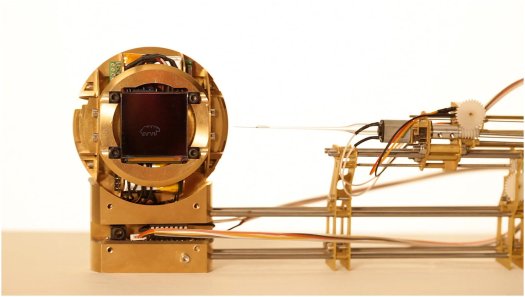
The works that obtained a Vesper statuette (symbol of the FILE PRIX LUX award) along with the also outstanding Honorary Mentions are exhibited at the FIESP-Ruth Cardoso Cultural Centre in a group show that also includes FILE Media Art, a selection of more than 70 works that can be accessed on several computers, as well as a selection of videogames and machinima films. The exhibition is thus richer in content than it would seem at first sight, as the space is divided in numerous sections that conceal several installations which demand (as usual) almost total obscurity. The artworks are well presented, although at times the sound from one installation invades the others, and there are no wall labels that inform the viewer about the concept of the piece or the way to interact with it. The latter, much-discussed issue is quite important, since the info-trainers cannot explain the artworks to every visitor, and quite often this entails that some people may not interact with the pieces or worse, start smashing buttons or interfering projections blindly in the hope of modifying them. Despite this fact, the exhibition has proven to be very successful during the first week of the festival, with a steady flow of visitors who showed a profound interest in the artworks.

A part of the exhibition is devoted to the FILE MACHINIMA section, curated by Fernanda Alburquerque, who selected over 40 works. Among these is the award winner in the Popular Vote category, War of Internet Addiction, by Corndog and the Oil Tiger Machinima Team from China, a 64-minute movie collectively created by players in the MMORPG War of Warcraft. More than mere entertainment, this film has been created as a form of protest against the Chinese authorities’ attempt to control the access and commercial benefits derived from the WoW game, which is extremely popular in the country. The film has had 10 million views since January 2010 and despite being available only in Chinese, it has been the favorite work of those who participated in the online voting system of the FILE PRIX LUX. Besides this feature film, other short films explore the possibilities of building narratives in virtual environments such as Second Life and videogames such as Half Life 2, Eve Online or Shadow of the Colossus.
In addition to the main exhibition, the FIESP Cultural Centre hosts a series of performances and screenings. Under the title Hypersonica, the festival presented a series of digital music performances, among which where the two winners of the FILE PRIX LUX in the Electronic Sonority category. FILE DOCUMENTA, curated by Eric Marke, offers in its 5th edition a selection of “rare and new” documentary films, among which Andreas Johnsen’s Good Copy Bad Copy, an interesting exploration of the conflicts between remix artists and copyright owners, or Robert Baca’s Welcome to Macintosh, which records the first years of the history of Apple Computers.
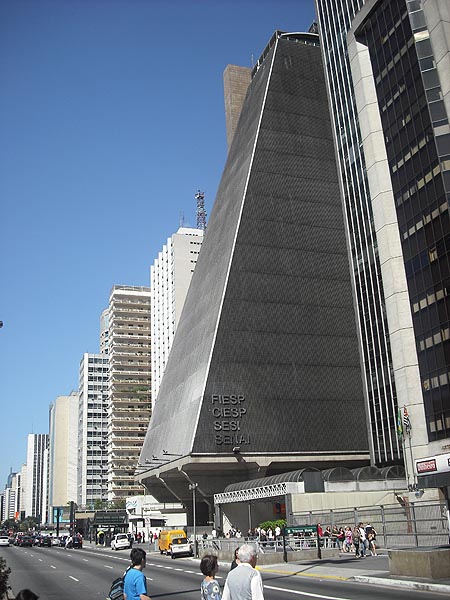
The symposium, hosted by the Instituto Cervantes in Sao Paulo, gathered several experts and artists who presented their explorations in the theory and practice of media art. Among the most interesting contributions were the presentation of Prof. Espen Aarseth on the aesthetics of ludo-narrative software, and the colloquy of South American digital art, in which Raquel Renno (Brazil), Jorge Hernandez, Ricardo Vega (Chile) and Vicky Messi (Argentina) discussed the current developments in the media art scene in the South Cone.
Alongside the FILE PRIX LUX, the most outstanding feature of the present edition of the festival is FILE PAI (Paulista Avenida Interactiva), which takes several interactive artworks to the public spaces in the Paulista Avenue. Interactive art offers the possibility of bringing art to the public space in a more efficient and dynamic form than what is usually known as “public art”. As Ricardo Barreto states: “the public environment is not something empty, aseptic and dead, as is the old white cube; on the contrary, it is an environment teeming with life, with multiple interests and multiple behaviors”. Interactive art integrates itself into this environment and is much more apt to relate to a public that is now willing to take an active role. The organizers of the FILE festival have distributed twelve interactive artworks along the Paulista Avenue, at subway stations, inside shopping malls, and even in a bus. The selected artworks include, among others, videogames such as Patrick Smith’s Windosill or the celebrated games of That Game Company, Flower and Flow; VR/Urban’s SMSlingshot, an urban intervention project that allows users to write a message in a custom-made slingshot that incorporates a screen and a keyboard and then send the message to a wall, where it is displayed as a virtual graffiti; Karolina Sobecka’s Sniff, an interactive projection in which a virtual dog reacts to the presence of passersby; the installations of Rejane Cantoni and Leonardo Crescenti Piso and Infinito ao Cubo, which attracted a large number of people, and the sound piece Omnibusonia Paulista by Vanderlei Lucentini, which is played in a bus as it moves along the avenue, interacting with several points in the itinerary and thus generating a new set of sounds in every trip. These works reveal the possibilities of integrating interactive art in the public space, to the point that, as Ricardo Barreto indicates, “the new paradigm of public art will be the interactive city”. The busy Paulista Avenue is certainly a good location for the creation of an emerging, interactive city.
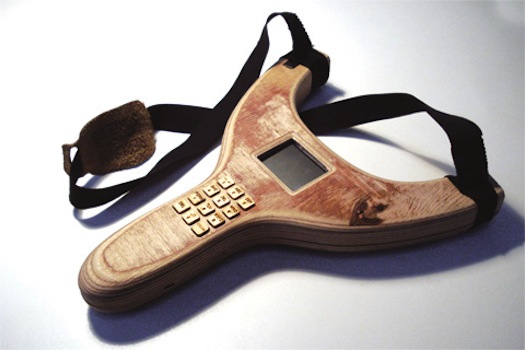
In this 11th edition, the FILE festival has achieved a state of maturity. The FILE PRIX LUX, FILE PAI and an estimated 25,000 visitors to date support its claim of being the largest festival of its kind in Latin America, and a steady event that places Brazil in the map of the international digital art scene. In a tightly interconnected world, each region is a node: there isn’t a center and a periphery anymore, there are no colonies. FILE exemplifies how a region can become a powerful node in this network by promoting the most recent developments in art and technology, avoiding obsolete distinctions between North and South and becoming a point of development for the future stages of our digital culture.
Co-published by Furtherfield and The Hyperliterature Exchange.
Last October I received an e-mail headed “Introducing Vook”:
The Vook Team is pleased to announce the launch of our first vooks, all published in partnership with Atria, an imprint of Simon & Schuster, Inc. These four titles… elegantly realize Vook’s mission: to blend a book with videos into one complete, instructive and entertaining story.
The e-mail also included a link to an article about Vooks in the New York Times:
Some publishers say this kind of multimedia hybrid is necessary to lure modern readers who crave something different. But reading experts question whether fiddling with the parameters of books ultimately degrades the act of reading…
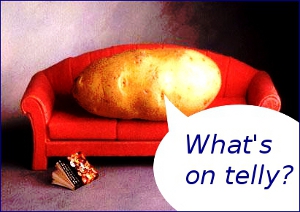
Note the rather loaded use of the words “lure”, “crave”, “fiddling” and “degrades”. The phraseology seems to suggest that modern readers are decadent and listless thrill-seekers who can scarcely summon the energy to glance at a line of text, let alone plough their way through an entire book. If an artistic medium doesn’t offer them some form of instant gratification – glamour, violence, excitement, pounding beats, lurid colours, instant melodrama – then it simply won’t get their attention. But publishers have a moral duty not to pander to their readers’ base appetites: the New York Times article ends by quoting a sceptical “traditional” author called Walter Mosley –
“Reading is one of the few experiences we have outside of relationships in which our cognitive abilities grow,” Mr. Mosley said. “And our cognitive abilities actually go backwards when we’re watching television or doing stuff on computers.”
In other words, reading from the printed page is better for your mental health than watching moving pictures on a screen: an argument which has been resurfacing in one form or another at least since television-watching started to dominate everyday life in the USA and Europe back in the 1950s. To some extent this is the self-defence of a book-loving and academically-inclined intelligensia against the indifference or hostility of popular culture – but in the context of a discussion of Vooks, it can also be interpreted as a cry of irritation from a publishing industry which is increasingly finding the ground being scooped from under its feet by younger, sexier, more attention-grabbing forms of entertainment.
The fact that the Vook publicity-email links to an article which is generally rather sniffy and unfavourable about the idea of combining video with print no doubt reflects a belief that all publicity is good publicity – but it is also indicative of the publishing industry’s mixed attitudes towards the digital revolution. On the whole, up until recently, they have tended to simply wish it would just go away; but they have also wished, sporadically, that they could grab themselves a piece of the action. But those publishers who have attempted to ride the digital surf rather than defy the tide have generally put their efforts and resources into re-packaging literature instead of re-thinking it: and the evidence of this is that the recent history of the publishing industry is littered with ebooks and e-readers, whereas attempts to exploit the digital environment by combining text with other media in new ways have generally been ignored by the publishing mainstream, and have therefore remained confined to the academic and experimental fringes.
The publishing industry’s determination to make the digital revolution go away by ignoring it has been even more evident in the UK than in the US. The 1997 edition of The Writers’ and Artists’ Yearbook, for example, contains no references to ebooks or digital publishing whatsoever, although it does contain items about word-processing and dot-matrix printers. On the other hand, Wired magazine was already publishing an in-depth article about ebooks in 1998 (“Ex Libris” by Steve Silberman, http://www.wired.com/wired/archive/6.07/es_ebooks.html) which describes the genesis of the SoftBook, the RocketBook and the EveryBook, as well as alluding to their predecessor, the Sony BookMan (launched in 1991). Even in the USA, however, enthusiasm for ebooks took a tremendous knock from the dot-com crash of 2000. Stephen Cole, writing about ebooks in the 2010 edition of The Writers’ and Artists’ Yearbook, summarises their history as follows:
Ebook devices first appeared as reading gadgets in science fiction novels and television series… But it was not until the late 1990s that dedicated ebook devices were marketed commercially in the USA… A stock market correction in 2000, combined with the generally poor adoption of downloadable books, sapped all available investment capital away from internet technology companies, leaving a wasteland of broken dreams in its wake. Over the next two years, over a billion dollars was written off the value of ebook companies, large and small.
After 2000, there was a widely-held view (which I shared) that the ebook experiment had been tried and failed: paper books were a superb piece of technology, and perhaps a digital replacement for them was simply never going to happen. There were numerous problems with ebooks: too many different and incompatible formats, too difficult to bookmark, screens hard to read in direct sunlight, couldn’t be taken into the bath, etc. But ebooks have always had a couple of big points in their favour – you can store hundreds on a computer, whereas the same books in paper form demand both physical space and shelving, you can find them quickly once you’ve got them, and they’re cheap to produce and deliver. Despite the dot-com crash and general indifference of the reading public, publishers continued to bring out electronic editions of books, and a small but growing number of people continued to download them.
Things really started to change with the launch of Amazon’s Kindle First Generation in 2007. It sold out in five and a half hours. With the Kindle, the e-reader went wireless. Instead of having to buy books on CDs or cartridges and slot them into hand-helds, or download them onto computers and then transfer them, readers using the Kindle could go right online using a dedicated network called the Whispernet, and get themselves content from the Kindle store.
Despite this big step forward, the Kindle was still an old-school e-reader in some respects: it had a black and white display, and very limited multimedia capabilities. The Apple iPad changed the rules again when it was launched in April 2010. The iPad isn’t just an e-reader – it’s “a tablet computer… particularly marketed for consumption of media such as books and periodicals, movies, music, and games, and for general web and e-mail access” (Wikipedia, http://en.wikipedia.org/wiki/I-pad). Its display screen is in colour, and it can play MP3s and videos or browse the Web as well as displaying text. For another thing, it goes a long way towards scrapping the rule that each e-reader can only display books in its own proprietary format. The iPad has its own bookstore – iBooks – but it also runs a Kindle app, meaning that iPad owners can buy and display Kindle content if they wish.
It seems we may finally be reaching the point where ebooks are going to pose a genuine challenge to print-and-paper. Amazon have just announced that Stieg Larsson’s The Girl with the Dragon Tattoo has become the first ebook to sell more than a million copies; and also that they are now selling more copies of ebooks than books in hardcover.
It is certainly also significant that the past couple of years have seen a sudden upsurge of interest in the question of who owns the rights over digitised book content, and whether ordinary copyright laws apply to online text – a debate which has been brought to the boil by a court case brought against Google in 2005 by the Authors Guild of America.

In 2002, under the title of “The Google Books Library Project”, Google began to digitise the collections of a number of university libraries in the USA (with the libraries’ agreement). Google describes this project as being “like a card catalogue” – in other words, primarily displaying bibliographic information about books rather than their actual contents. “The Library Project’s aim is simple”, says Google: “make it easier for people to find relevant books – specifically, books they wouldn’t find any other way such as those that are out of print – while carefully respecting authors’ and publishers’ copyrights.” They do concede, however, that the project includes more than bibliographic information in some instances: “If the book is out of copyright, you’ll be able to view and download the entire book.” (http://books.google.com/googlebooks/library.html)
In 2004 Google launched Book Search, which is described as “a book marketing program”, but structured in a very similar way to the Library Project: displaying “basic bibliographic information about the book plus a few snippets”; or a “limited preview” if the copyright holder has given permission, or full texts for books which are out of copyright – in all cases with links to places online where the books can be bought. Interestingly, my own book Outcasts from Eden is viewable online in its entirety, although it is neither out of copyright nor out of print, which casts a certain amount of doubt on Google’s claim to be “carefully respecting authors’ and publishers’ copyrights”.
In 2005 the Authors Guild of America, closely followed by the Association of American Publishers, took Google to court on the basis that books in copyright were being digitised – and short extracts shown – without the agreement of the rightsholders. Google suspended its digitisation programme but responded that displaying “snippets” of copyright text was “fair use” under American copyright law. In October 2008 Google agreed to pay $125 million to settle the lawsuit – $45.5 million in legal fees, $45 million to “rightsholders” whose rights had already been infringed, and “$34.5 million to create a Book Rights Registry, a form of copyright collective to collect revenues from Google and dispense them to the rightsholders. In exchange, the agreement released Google and its library partners from liability for its book digitization.” (http://en.wikipedia.org/wiki/Google_Book_Search_Settlement_Agreement). The settlement was queried by the Department of Justice, and a revised version was published in November 2009, which is still awaiting approval at the time of writing.
The settlement is a complex one, but its most important provision as regards the future of publishing seems to be that “Google is authorised to sell online access to books (but only to users in the USA). For example, it can sell subscriptions to its database of digitised books to institutions and can sell online access to individual books.” 63% of the revenue thus generated must be passed on to “rightsholders” via the new Registry. “The settlement does not allow Google or its licensees to print copies of books in copyright.” (“The Google Settlement” by Mark Le Fanu, The Writers’ and Artists’ Yearbook 2010, pp. 631-635).
Google, it will be noted, are now legally within their rights to continue their digitisation programme. This means they don’t have to ask anyone’s permission before they digitise work. If authors or publishers would prefer not to be listed by Google it is up to them to lodge an objection online. Google would argue that in launching their Library Project and Books Search they have merely been seeking to make their search facilities more complete, and thus to “make it easier for people to find relevant books” – but whether or not they have been deliberately plotting their course with wider strategic issues in mind, the end result has been to make them the biggest single player – almost the monopoly-holder – where digital book rights are concerned. As a reflection of this, an organisation called the Open Book Alliance has been set up to oppose the settlement, supported by the likes of Amazon and Yahoo: “In short,” their website claims, “Google’s book digitization strategy in the U.S. has focused on creating an impenetrable content monopoly that violates copyright laws and builds an unfair and legally insurmountable lead over competitors.” (http://www.openbookalliance.org/)
Whatever the pros and cons of the Google Settlement, it has undoubtedly helped to focus the minds of writers and publishers alike on the question of digital rights. Copyright laws and publishers’ contracts were designed to deal with print and paper, and until very recently there has been almost no reference at all to electronic publication. Writers who have agreed terms with a publisher for reproduction of their work in print have theoretically been at liberty to re-publish the same work on their own websites, or perhaps even to collect another fee for it from a digital publisher; and conversely, publishers who have signed a contract to bring out an author’s work in print have sometimes felt free to reproduce it electronically as well, without asking the writer’s permission or paying any extra money.
But things are beginning to change. A June 2010 article in The Bookseller notes that Andrew Wylie, one of the most prestigious of UK literary agents, “is threatening to bypass publishers and license his authors’ ebook rights directly to Google, Amazon or Apple because he is unhappy with publishers’ terms.” This is partly because he believes electronic rights are being sold too cheaply to the likes of Apple: “The music industry did itself in by taking its profitability and allocating it to device holders… Why should someone who makes a machine – the iPod, which is the contemporary equivalent of a jukebox – take all the profit?” Clearly, electronic rights are going to be taken much more seriously from now on.
Further indications that authors, publishers and agents are beginning to wake up and smell the digital coffee can be found in the latest editions of The Writers’ and Artists’ Yearbook and The Writers’ Handbook. For those who are unfamiliar with them, these annual publications are the UK’s two main guides to the writing industry. The 2010 edition of The Writer’s Handbook opens with a keynote article from the editor, Barry Turner, entitled “And Then There was Google”. As the title indicates, its main subject is the Google settlement and its implications – but its broader theme is that the book trade has been ignoring the digital revolution for too long, and can afford to do so no longer:
In the States… sales of e-books are increasing by 50 per cent per year while conventional book sales are static. An indication of what is in store was provided at last year’s Frankfurt Book Fair where a survey of book-buying professionals found that 40 per cent believe that digital sales, regardless of format, will surpass ink on paper within a decade.

The Writers’ and Artists’ Yearbook is more conservative in tone, but if anything its coverage is more in-depth. It has an entire section titled “Writers and Artists Online”, which leads with an article about the Google settlement. In addition there are articles on “Marketing Yourself Online”, “E-publishing” and “Ebooks”. Even in the more general sections of the Yearbook there is a widespread awareness of how digital developments are affecting the book trade. For example, there is a review (by Tom Tivnan) of the previous twelve months in the publishing industry, which acknowledges the importance not just of ebooks but print-on-demand:
Amazon’s increasing power underscores how crucial the digital arena is for publishing… Ebooks remain a miniscule part of the market,… yet publishers and booksellers say they are pleasantly surprised at the amount of sales… And it is not all ebooks. The rise of print-on-demand (POD) technology (basically keeping digital files of books to be printed only when a customer orders it) means that the so-called “long tail” has lengthened, with books rarely going out of print… POD may soon be coming to your local bookshop. In April 2009, academic chain Blackwell had the UK launch of the snazzy in-store Espresso POD machine, which can print a book in about four minutes…
There is also an article about “Books Published from Blogs” (by Scott Pack):
Agents are proving quite proactive when it comes to bloggers. Some of the more savvy ones are identifying blogs with a buzz behind them and approaching the authors with the lure of a possible book deal… Many bestsellers in the years to come will have started out online.
Most of the emphasis in these articles falls on the impact which digital developments are having on the marketing of books rather than the practice of writing itself. But now and again there are signs of a creeping awareness that digitisation may actually change the ways in which our literature is created and consumed. In The Writer’s Handbook, Barry Turner attempts to predict how the digital environment may affect the practice of writing in the coming years:
Those of us who make any sort of livng from writing will have to get used to a whole new way of reaching out to readers. Start with the novel. Most fiction comes in king-sized packages… Publishers demand a product that looks value for money… But all will be different when we get into e-books. There will be no obvious advantage in stretching out a novel because size will not be immediately apparent… Expect the short story to make a comeback… The two categories of books in the forefront of change are reference and travel. Their survival… is tied to a combination of online and print. Any reference or travel book without a website is in trouble, maybe not now, but soon.
Scott Pack’s article on “Books Published from Blogs” tends to focus on those aspects of a blog which may need remoulding to suit publication in book form; but an article by Isabella Pereira entitled “Writing a blog” is more enthusiastic about the blog as a form in its own right:
The glory of blogging lies not just in its immediacy but in its lack of rules… The best bloggers can open a window into private worlds and passions, or provide a blast of fresh air in an era when corporate giants control most of our media… Use lots of links – links uniquely enrich writing for the web and readers expect them… What about pictures? You can get away without them but it would be a shame not to use photos to make the most of the web’s all-singing, all-dancing capacities.
Even here, however, the advice stops short of videos, sound-effects or animations. Another article in The Writers’ and Artists’ Handbook (“Setting up a Website”, by Jane Dorner) specifically forbids the use of animations:
Bullet points or graphic elements help pick out key words but animations should be avoided. Studies show that the message is lost when television images fail to reinforce spoken words. The same is true of the web.
It’s a little difficult to fathom exactly what point Dorner is trying to make here, but it seems to be something along the lines that using more than one medium may have a distracting rather than enhancing effect. If the spoken words on your television are telling you one thing, but the pictures are telling you another, then “the message is lost”. Perhaps a more interesting point, however, is where Dorner draws her dividing-line between acceptable and unacceptable practice. “Bullet points or graphic elements” are all right, because they “help pick out key words”, but “animations should be avoided”. In other words visual aids are all very well as long as they remain to subservient to text. They minute they threaten to replace it as the focus of attention, they become undesireable.
Clearly this point of view continues to enjoy a lot of support, particularly from traditionalists in the writing and publishing industries. All the same, combinations of text with other media may be about to enjoy some kind of vogue; and the development of the Vook brand since its launch last October is an instructive case-history in this regard.
When Vooks were first launched it seems fair to say that they were broadly greeted with a mixture of indifference and scorn. Reviews which appeared in the first couple of months after the launch were usually either lukewarm of downright unfavourable. Here, for example, is one from Janet Cloninger, writing in The Gadgeteer, November 2009:
So how were the video clips? Have you ever seen any of those old 60s TV shows where they were trying to show a bad acid trip? You know the crazy camera work, the weird color changes, the really bad acting?… I don’t think they added anything to the story at all… I found they were very distracting while trying to read.
Here is another from the Institute for the Future of the Book:
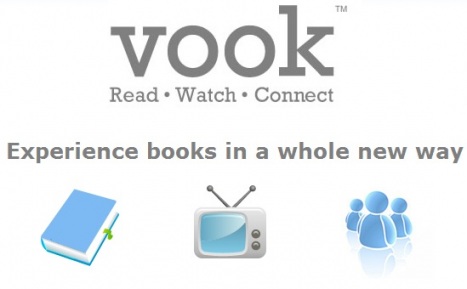
In terms of form the result is ho-hum in the extreme, particularly as there doesn’t seem to be much attempt to integrate the text and the banal video, which seems to exist simply to pretty-up the pages.
Following on from this generally unenthusiastic reception for the first Vooks, news about the brand over the next few months seemed to suggest that it was struggling to establish itself. In January 2010 Vook announced that they were publishing a range of “classic” titles, mostly for children – since “classic” normally means “out of copyright”, this seemed to imply that they were trying to boost their titles-list on the cheap. In February there was an announcement that Vook had raised an extra $2.5 million in “seed-financing” from a number of Silicon Valley and New York investors, suggesting that perhaps initial sales had been disappointing, Simon & Schuster had been reluctant to put up more money, and new sources of finance had therefore been sought.
With the launch of the iPad, however, it became obvious that Vook was making another throw of the dice. In April they launched 19 titles specially adapted for the iPad: In a statement, Bradley Inman, Vook CEO and founder said, “We will remember the iPad launch as the day that the publishing industry officially made the leap to mixed-media digital formats and never looked back…” The Vook blog makes this pinning-of-hopes on the iPad even more apparent:
The release of the iPad this Saturday was not just a red letter moment for Silicon Valley, it marked a turning point for the publishing and film industries, and a great opportunity for those invested in the future of media. The team at Vook has been working hard for months to prepare apps for submission to Apple… In many ways, it seems like the iPad was literally made for us…
And it seems their hopes may not have been misplaced. In May they launched a title about Guns’n’Roses (Reckless Road, documenting the creation of the Appetite for Destruction album), and lo and behold it was favourably greeted:
…unprecedented photos and memorabilia from the early years of one of the great rock bands from the 1980s and 1990s… If you are a true hard rock fan, and Guns ‘N’ Roses was one of your favorite bands, this app is worth the try. (PadGadget)
Now that I’ve had some time to read through Reckless Road and watch many of the videos included in it I can see the value of the Vook approach. It lends itself well to a product like this… This is an app any Guns N’ Roses fan would greatly appreciate. (Joe Wickert)
In June, the Vook version of Brad Meltzer’s bestseller Heroes for my Son was also favourably received:
It is easy to see the tremendous possibilities in the Vook format, especially when tied to a tablet device like the iPad. I very much enjoyed my first experience with a Vook mainly because I rapidly dropped my attempt to think of it as a Book with video plug ins. A Vook is really a multimedia platform that centers around text, rather than a traditional book. (MobilitySite)
Both these books are non-fiction – a genre in which the relationship between video footage and text seems far less problematic. It is interesting to note, however, that in both cases the non-linear structure of the Vook is singled out as a positive feature, compared to the sequential organisation of a traditional book:
It is charmingly non-linear and can be approached from many different angles. More a chocolate box than a book, especially if you are like me and enjoy really digging down into a subject while reading. (MobilitySite)
Remember that old VH1 series, Behind the Music? Canter’s Vook app feels like a modern version of that approach, with the added benefit that you can hop around the story to your heart’s content… (Joe Wickert)
There are hints here of a realisation that digital media can sometimes offer kinds of reading which are unavailable to, or hampered by, traditional print-and-paper.
Further recognition that ebooks with multimedia in them might actually have market appeal came at the end of June from none other than Amazon, who announced that they were adding audio and video to the Kindle iPhone/iPad app. The irony of this move is, of course, that Kindle ebooks are now multimedia-capable on the iPhone and iPad but not on the Kindle itself – an irony which can hardly be allowed to continue, and which therefore doubtless presages the launch of a multimedia Kindle some time in the near future.
Of course, the story of multimedia innovation in literature goes back much further than Vooks and the iPad. The British writer Andy Campbell, for example, has been publishing his own new media fiction online for years – most recently on the Dreaming Methods website. Most of his work has been designed in Flash, which the iPad unfortunately does not support. He therefore finds himself in the one-step-forward-and-two-steps-back position where new media literature is finally starting to make some headway in the marketplace, but thanks to a whim of the Apple corporation his own work in the field, developed over more than a decade, been landed with a big disadvantage. Understandably, his feelings are mixed:
It does indeed seem like there is a shift going on with digital fiction, although there are still a large number of stumbling blocks from a development point of view… Whilst the potential of the iPhone and iPad is undoubtedly exciting, a lot of authors – including myself – do not work with Macs or have the programming experience required to produce Apple-happy content…. However that’s from the point of view of Apple dominating the market and forcing everyone to use their SDK, whilst in actual fact Android holds considerable promise… I wouldn’t say digital fiction is breaking through into the mainstream – although perhaps it depends what you mean by digital fiction… Whether anything has been produced that really takes reading as an experience to a new level, I’m not sure.
Since Flash has hitherto been one of the main tools used by new media writers and artists, many of them will now find themselves in the same predicament as Campbell – and many of them will doubtless be hoping, like him, that alternative platforms such as Android are going to make some headway in the coming months. But leaving the question of platforms on one side, another difficulty for existing new media writers seems to be that although publishers are suddenly discovering a new enthusiasm for the form, they have very little knowledge or understanding of the work which has already been done, and very few links with those who have been doing it. Nor is this entirely the publishers’ fault, because there seems to be a genuine cultural divide between those who work in the publishing industry and those who take an interest in new media literature. Emily Williams of Digital Book World alludes to this divide in her article about this year’s London Book Fair (“Old London vs. New Media”, April 2010):
In most [publishing] houses, the digital innovators are still operating on a parallel plane, touching on but not fully integrated into the publishers’ core business centers. This segregation is so complete that much of the digital crowd is liable to skip the traditional fairs altogether, gravitating instead to their own tech confabs (which are in turn often boycotted by, or unknown to, the bookish folk).
Michael Bhaskar, a publisher and one of the judges of the Poole Literary Festival’s New Media Writing Prize, makes a similar point in his blog:
There has been no real conversation between the two [publishers and new media writers]. Why? It seems like we should have hit the meeting point where there could and should be a productive alliance, when in fact the gulf seems as wide as ever… Publishers have to sell books – or something – to keep going… [whereas] much new media writing is not designed to be commercial, being associated with a more recondite and experimental mindset.
In other words, publishers and new media writers have failed to come together, not simply because publishers have been hoping for the digital revolution to go away, nor because new media writers have been go-it-alone experimentalists, but because culturally they have belonged to different worlds, moved in different circles and spoken different languages.
Even assuming that these difficulties can be overcome, it is open to doubt whether new media writers will necessarily want to throw themselves headlong into the commercial mainstream. Many of them, like Andy Campbell, have been going it alone for so long that the habit of independence may be difficult to shake. Undoubtedly a bit of money would be very welcome, but advice from marketing men about how to make their work more commercial might be less well-received. On the publishing side of the equasion, however, there are definite signs that things are starting to change. Experimentation was the buzzword of the 2010 London Book Fair:
The publishing industry must move at speed to adopt new business models and new ways of working if it is to seize the opportunities of the digital revolution, delegates were told at London Book Fair… Industry figures focused on the need to experiment and to get a real understanding of what consumers want from the new technologies in a fast-changing environment. (The Bookseller)

There are also signs that the influence of digital technology on writing now extends beyond the software-savvy fringe, and is starting to affect the ways in which less specialised writers create their work. One of the surprize best-sellers of last year was a book called Important Artifacts and Personal Property from the Collection of Lenore Doolan and Harold Morris, Including Books, Street Fashion and Jewellery, by Leanne Shapton, which (as the title suggests) takes the form of an auction catalogue, selling off the belongings of a fictional couple. As befits an auction catalogue, the book consists of photographs of the articles for sale, accompanied by snippets of text –
Lot 1231: Two pairs of white shoes. Two pairs of white bucks. The label inside the men’s pair reads “Prada”, the women’s reads “Toast”. Sizes men’s 11, women’s 9. Well worn. $40-60.
The artefacts in the catalogue are arranged in chronological order, which makes it easier for them to tell the story of the couple’s love-affair; but despite this concession to linearity what is striking about the novel, to anyone who has had very much to do with new media literature, is how like a piece of new media literature it is. Experimental it may be as a novel in print, but as a piece of digital writing it would be fairly conventional, albeit unusually well-put-together. It was obviously composed as collection of objects and pictures as much as a a piece of written text; there is no conventional dialogue or storytelling; despite its chronological sequence there is a strong non-linear element to the book, a feeling that it is as much designed to be dipped and skimmed as to be read from one end to the other; it makes a knowing reference to Raymond Queneau, the Oulipo writer; and in many ways it would be more at home on the Web, where the pictures could be in full colour and zoomable at no extra expense.
Another example of the influence of digital technology on “ordinary” literature comes from the small-scale end of the publishing industry – Martha Deed’s poetry chapbook The Lost Shoe, which was published earlier this year by Dan Waber at Naissance Chapbooks (about whom, more in a moment). The first point to note about this collection is that in order to publicise it Martha made a video, also called “The Lost Shoe” (http://www.sporkworld.org/Deed/lostshoe.mov), which deserves to be thought of as a companion-piece rather than a “trailer”. The poems in the collection are based on Martha’s experiences as a psychologist specialising in family law – more specifically, they deal with cases in which family members have done violence to each other, and some of them are harrowingly raw:
Upstairs, he tried twice to change his clothes
his fingers slippery with your blood…
You were looking at him
the last person you saw before your death
It bothered him, that lifeless stare,
so he stepped over your mother
your dying baby sister
and tried to close your eyes…
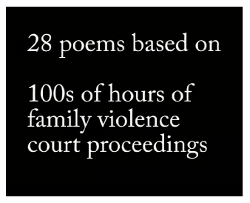
The video has the same combination of near-documentary authenticity and artistic control. It starts with a 911 telephone call from a man who has harmed his own children. There is a terrible moment when he is asked what has happened and he breaks into hysterical tears and says “They got stabbed”, as if somebody else might have done it. It ends with Martha reading aloud from one of her own poems, “Practice Tips”, which is based on the Center for Criminal Justice Advocacy‘s “Criminal Pre-Trial and Trial Practice”:
Play the tape 10 times at trial.
The jury will become accustomed to the carnage…
Obfuscate. Whine. Grandstand.
Fumble with your papers.
The fact that Martha feels equally at home working with both the written word and the camera, and therefore feels able to shoot her own video as a means of publicising her collection of poems, is an indication of the way in which digital technology is beginning to influence literary practice at grass-roots level. But the influence goes further. As well as conventional verse, her collection contains a number of visual poems – you could almost call them diagram poems – combining text with graphic design. “Jury Pool”, for example, shows a number of black stick-figures in and around the jury pool, labelled with reasons why they have been disqualified from the jury, or factors which will influence their outlook on the case: “Have to go back to school”, “Ate lunch with defendant’s mother”, “Crime victim”, “Don’t understand English”, and so forth. Including a diagram-poem such as this in a collection of poetry would not have been impossible before digital technology came along, but the fact that software packages such as Microsoft Word and Open Office Writer can handle images as easily as text, and make it simple to customise page-design without incurring any extra cost, means that poets now have an enormous range of experimental possibilities constantly at their fingertips.
Furthermore a lot of writers haven’t just moved beyond the pen or the portable typewriter to computers and word processing software; they have moved on to such things as blogs and web-pages, which have built-in multimedia capabilities. Sound-files and videos are rapidly becoming a normal part of the amateur writer’s working environment, and as a result the combination of text with other media is becoming a grassroots staple rather than a specialists-only field.
The Lost Shoeis published by Naissance Chapbooks, run by Dan Waber. A glance through Waber’s catalogue is enough to confirm the effect which digital technology is starting to have on poetic style. Amongst more formally conventional poetry he publishes, for example, Psychosis by Steve Giasson, which is based on comments collected by a YouTube posting of the shower scene from Psycho:
kthevsd Lame movies ? Kid I like all movies, old films, new films, etc. How is this classic lame ? Have you even ever watched it ? What would some 16 year old teenybopper know about cinema ? You probably have never even heard of Kurosawa and I bet you have never even seen a Daniel Day Lewis or Meryl Streep movie in your life. No wonder everyone laughs at your generations taste…
Or there is a collection by Jenny Hill called Regular Expressions: the Facebook status update poems –
Ron: I delivered a fucking BABY tonight! Yep, a fucking BABY!!!!!!!!! what did
u do today? Nursing school is AWESOME!!!!!!!
Someone asks if it was slimy, another wants
the placenta, most are stumped
at how to comment
on all your exclamation marks.
Then there is Watching the Windows Sleep by Tantra Bensko, which combines “fiction, poetry, and photographs”; or Open your I by endwar, which is “at times concrete, at times typoem, at times visual poem, at times conceptual poem, at times typewriter poem”. It is clear that the digital revolution has affected all of these collections in one way or another – either by making a wider range of experimental options available, or by providing them with their inspiration and subject-matter.
Of course, these are atypical exhibits, because Dan Waber, the publisher, is clearly interested in adventurous and experimental kinds of poetry. He also publishes a series called “This is Visual Poetry“, which now runs to about fifty full-colour booklets of visual poems, “answering the question [What is visual poetry?] one full-color chapbook at a time”, and answering it extremely variously. All the same, even allowing for Waber’s adventurous tastes, the fact that within a couple of years he has managed to put together fifty chapbooks of visual poetry, plus nineteen “conventional” poetry collections which often show clear signs of technological influence, is strongly suggestive of the directon in which things are moving.
Just as noteworthy is the business-model behind Waber’s publishing ventures. Basically, his operation relies on three key elements. The first is print-on-demand technology, which has almost completely done away with the printing expertise on which book production used to rely. These days, as long as writers can produce a competently-laid-out electronic original it can be turned into a book at the touch of a button. Colour reproduction is slightly more expensive than black-and-white, but not prohibitively so. Standards of reproduction are undoubtedly lower than they would be in the hands of a specialist printer, but most people never notice the difference. Self-publishing ventures such as Lulu (www.lulu.com) rely on this kind of print-on-demand process, and although Waber sends his electronic originals to the local print shop rather than using a completely automated online process, the technology is the same.
However, whereas the Lulu publishing process involves quite a bit of donkeywork (and usually a crash course in book-design and pagination) on the part of the author, the second key element of Waber’s publishing model is a drastically simplified and stringent set of layout criteria. Submissions to the visual poetry series must be “17 color images of visual poems of yours that are 600 pixels wide by 800 pixels tall”; and submissions to the Naissance chapbook series must be a maximum of 48 pages, in A4 portrait layout, with specified page-margins. Waber has designed a macro which takes Word files laid out according to these specifications and converts them instantaneously into print-ready book originals. This means that responsibility for the page layout is left squarely with the author – as Waber’s guidelines say, “all you need to do is make each page look how you want it to look… and we’ll convert it” – with the added effect that as long as authors stay within the guidelines, they are free to experiment as much as they like.
This combination of strict limitations and artistic freedom has undoubtedly helped to foster some of the adventurous design his chapbook series displays. At the same time, however, Waber has eliminated so much complexity from the publishing process that the third key element of the business model looks after itself: his costs (including time-costs) have come right down, to the point where he can show a modest profit on print-runs as low as ten units. All he has to do is decide whether he wants to publish something: if he does, he runs his macro, sends his print-ready file to the printer, and has ten copies of the chapbook in his hands within 24 hours. As he writes with understandable pride:
The beauty in all of this is no cash outlay. No huge print runs. No wondering if there’s grant money to support it, no worrying if it’ll actually sell enough to cover costs. It’s all profit after one copy sells… I am in a situation where because I make money off of every book I publish, all I need to do is find more books to publish. Because I de-complexified the process so completely.
Waber believes that his kind of venture represents the way forward for literary publishing in the era of digital technology, and he also believes that it is the kind of solution which can probably only come from outside the existing print industry, not from inside, because, as he puts it, “Big Publishing has a model that is blockbuster-based”. To explain this more fully, he cites an article by Clay Shirkey called “The Collapse of Complex Business Models“, which argues that big and complex businesses become unable to adapt to new circumstances, because their ideas about how they should operate become culturally embedded. If the new circumstances are sufficiently challenging then the only way forward will be for big organisations to collapse, and for new small ones, without the same culturally embedded assumptions, to take their place.
When ecosystems change and inflexible institutions collapse, their members disperse, abandoning old beliefs, trying new things, making their living in different ways than they used to… when the ecosystem stops rewarding complexity, it is the people who figure out how to work simply in the present, rather than the people who mastered the complexities of the past, who get to say what happens in the future.
This, argues Waber, is likely to be the ultimate effect of the digital revolution on the publishing industry; not simply dramatic changes in publishing formats and marketing methods, but a complete collapse of “Big Publishing”, and a multitude of small-scale, dynamic new ventures like his own, growing up out of the wreckage.
Clearly this is something that publishers themselves are worried about. As Michael Bhaskar writes in his blog for The Poole Literary Festival’s New Media Writing Prize,
On the writing side I often hear that people feel ignored by publishers.Essentially the world of commercial publishing is a closed shop unwilling to listen to the maverick, the outsider and the original, and will ultimately pay for this as audiences gravitate to newer and amorphous forms… This might be an argument for by-passing publishers or intermediaries altogether… [but] what I would like is mediation.
Clay Shirkey quotes the example of the “Charley bit my finger” video on YouTube to illustrate how production values have changed:
The most watched minute of video made in the last five years shows baby Charlie biting his brother’s finger… made by amateurs, in one take, with a lousy camera… Not one dime changed hands anywhere between creator, host, and viewers. A world where that is the kind of thing that just happens from time to time is a world where complexity is neither an absolute requirement nor an automatic advantage.

The “not one dime changed hands anywhere” line is perhaps a bit of an oversimplification. Wikipedia notes that “According to The Times, web experts believe the Davies-Carr family could earn £100,000 from ‘Charlie Bit My Finger’, mostly from advertisements shown during the video.” (http://en.wikipedia.org/wiki/Charlie_Bit_My_Finger) But the Davies-Carrs didn’t make or post the video with the intention of becoming celebrities or making money. They posted it so that it could be viewed by the boys’ godfather. The success of the video, in other words, owes nothing to its production values or to any marketing strategy, and everything to the environment created by YouTube and its viewers.
An alternative to the Big Publishing model is already with us, and despite odd viral phenomena like “Charlie Bit My Finger”, it consists in the main of very large numbers of small-scale products reaching small audiences, rather than small numbers of very high-profile products reaching huge audiences. This alternative model is enabled by digital technology, and it replaces high production values and market-minded editorial controls with the principle that people’s desire to publish themselves and to look at each other’s efforts is itself a profit motor. No single book published by Lulu, for example, has to sell a lot of copies for Lulu itself to make a profit – it’s the volume which counts. The same is true of YouTube, and it’s also true, on a much smaller scale, of Dan Waber’s enterprise.
YouTube is now crawling with people hoping to become the next viral phenomenon – and there are also a number of talented individuals who have built up sizeable audiences on YouTube and who are making decent amounts of money out of those audiences – but the really big money is being made not by the people who contribute material, but by YouTube itself. The same is true of print-and-paper publishing via Lulu. The removal of editorial constraint has greatly freed up and democratised the creative side of the publishing process, but on the other hand, a system where most writers made relatively small amounts of money compared to publishers and agents is being increasingly shoved aside by a new system where most creators make no money at all, while the publishers do very nicely.
Add to this the fact that YouTube is now in the hands of Google – the same Google which has been “creating an impenetrable content monopoly” over digitised books through the Google Books programme – and the future of publishing starts to look less like an open field for small enterprises, created by the collapse of big corporations, and more like a battleground where a few monster Web 2 corporations – Amazon/Kindle, YouTube/Google and Apple – are carving up the territory as fast as they can, much as the major European countries carved up Africa during the nineteenth century.
What the future really holds for the publishing industry is probably a mixture of these two scenarios. It’s unlikely that conventional publishing is going to disappear any time soon, but in a shrinking market publishers are going to be more and more reluctant to publish untried material, more and more inclined to go with material which seems to tap into an already-established audience. The celebrity biography or autobiography; the book of the comedy series; the first novel by a TV personality; these are already familiar. The book version of a popular blog and the “global distribution” edition of something which has already sold very well via the Web are going to become increasingly familiar in the near future. Add to this books with associated websites, increasing emphasis on ebooks, and a cautious trial of ebooks with interactive elements, and you have a pretty good picture of how the conventional publishing industry is shaping up to deal with the digital revolution.
In the meantime, entrepreneurs like Dan Waber are taking fuller advantage of the new possiblities offered by digital technology, and perhaps planting the seeds for a whole new generation of publishing houses; while writers like Martha Deed and Leanne Shapton, under the influence of the digital revolution, are redefining literary genres.
But one consideration which should not be overlooked in all this is the importance of open standards. The digital revolution itself is predicated not only on technical advances – such as broadband, print-on-demand, digital video and multimedia handheld devices – but on the Web itself, and in particular on the fact that the Web is non-commercial and belongs to all its users. Material which appears on the Web doesn’t have to comply with a proprietary format laid down by any one corporation: it has to comply with standards laid down by the World Wide Web Consortium. It is this open structure which has enabled the Web to develop so rapidly and to serve as a framework within which so many enterprises have been able to flourish. For the field of publishing to flourish in the same way, open standards need to prevail here as well – open standards for ebooks, for example, so that standards-complaint work will be viewable on a whole range of different devices. Only under those circumstances can small enterprises and individual artists stand some kind of chance against the big corporations.
http://www.hyperex.co.uk/reviewdigitalpublishing.php
© Edward Picot, August 2010
© The Hyperliterature Exchange
Above image taken by Scott Beale, Laughing Squid.
Marc Da Costa interviews the ever dynamic Johannes Grenzfurthner, founder of monochrom. This is the first of three interviews, where he talks about the project ‘Soviet Unterzoegersdorf’; the fake history of the “last existing appanage republic of the USSR”. Created to discuss topics such as the theoretical problems of historiography, the concept of the “socialist utopia” and the political struggles of postwar Europe. In March 2009 Monochrom presented ‘Soviet Unterzoegersdorf: Sector II’. The game features special guest appearances of Cory Doctorow, Bruce Sterling, Jello Biafra, Jason Scott, Bre Pettis and MC Frontalot.
Since 1993, the Monochrom members have devoted themselves to the grey zones where systems intersect: the art (market), politics, economics, pop, gaiety, vanity, good clean fanaticism, crisis, language, culture, self-content, identity, utopia, mania and despair. The technique underlying Monochrom’s work is that of being and working in the fields of Pop/avant-garde, theory/reflection, interventionism/politics, gaiety/lust/tragedy, (self-)configuration/mystification. The project Monochrom pushes into and beyond these fields is, ‘networking’ events, people, possibilities, material, impetus and identities.” (Zdenka Badovinac, Moderna Galerija Ljubljana)
Grenzfurthner has collaborated with groups such as ubermorgen, Billboard Liberation Front, Esel and Mego (label). Grenzfurthner writes for various online/print magazines and radio stations (e.g. ORF, Telepolis, Boing Boing). Grenzfurthner has served on a number of art juries (e.g. Steirischer Herbst, Graz). He holds a professorship for art theory and art practice at the University of Applied Sciences, Graz, Austria and is a lecturer at University of Arts and Industrial Design in Linz, Austria.
Recurring topics in Johannes Grenzfurthner’s artistic and textual work are: contemporary art, activism, performance, humour, philosophy, sex, communism, postmodernism, media theory, cultural studies, popular culture studies, science fiction, and the debate about copyright.
The ‘Soviet Unterzoegersdorf’, a game created by monochrom, is described as being at once the “last existing appendage republic of the USSR” and located inside the Republic of Austria. Could you speak a bit about the project and its background?
From a conceptual background we have to state that we have been occupied with the construction, analysis and reflection of alternative worlds for quite a long time. A lot of our projects are treating this field partly as a discussion with concepts deriving from popular culture, science and philosophy, and partly as a direct reference to science fiction and fantasy fan culture. We first created the fake history of the “last existing appendage republic of the USSR” in 2001 — ten years after the ‘mighty Soviet Union’ went into this nation-state-splitting-up-process and new countries emerged like Firefox pop-ups that you can’t manage to click away.
We wanted to discuss topics such as the problems of historiography, the concept of “utopia” and “socialist utopia” and the political struggles of postwar Europe in a playful, grotesque way. You have to bear in mind that the real village of Unterzoegersdorf was part of the Post WWII Soviet zone from 1945 until the foundation of the ‘neutral’ Republic of Austria in 1955. Reactionary Austrians talk about 1955 as the ‘real liberation’… and I have to mention that that’s rather typical: cheering when Hitler arrives and being proud members of the Third Reich, afterwards proclaiming that Austria was the first victim of Nazi Germany and complaining about the allied occupation forces — especially the Soviet.
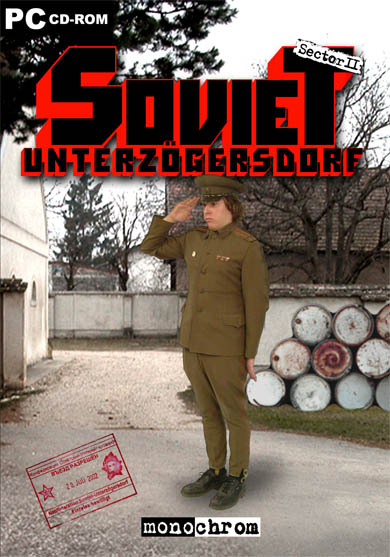
We transformed the theoretical concept into an improvisational theatre/performance/live action role-playing game that lasted two days. That means we really organized bus tours to Unterzoegersdorf — a small village that really exists — and acted the setting; beginning with the harsh EU Schengen border control. Later, in 2004, we started to think about a possible sequel to the performance. We thought that the cultural format of the “adventure game” provided the perfect media platform to communicate and improve the idea.
We started to work in February 2004 and presented ‘Sector 1’ — the first part of the trilogy — in the form of an exhibition in Graz/Austria in August 2005. We released ‘Sector 2’ in 2009, featuring guest stars as Cory Doctorow, Jello Biafra or Bruce Sterling. As the game series uses a 3rd person perspective with photo backgrounds and pictures of real actors as sprites, it took us quite a while to digitize and image process all of the material. This technique was actually first used by Sierra On-Line during the early and mid-1990s — but we are quite proud that we managed to get the feeling of discovering an old computer game that never existed on your old 500 MB hard drive. One aspect of the game is playing with memories and the future of the past. The future is a kind of carrot, the sort tied just in front of the cartoon donkey’s nose so it goes to work, goes off to war, learns Javascript and knows which bits to laugh at in Woody Allen’s Sleeper. You can imagine.
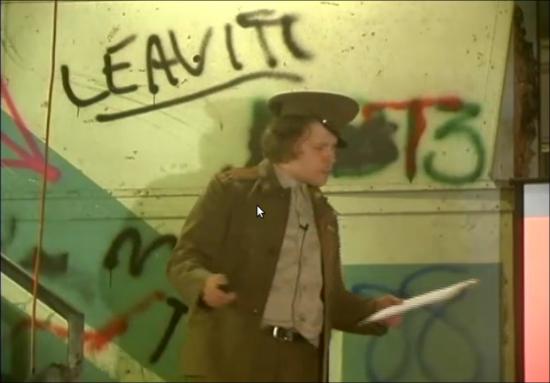
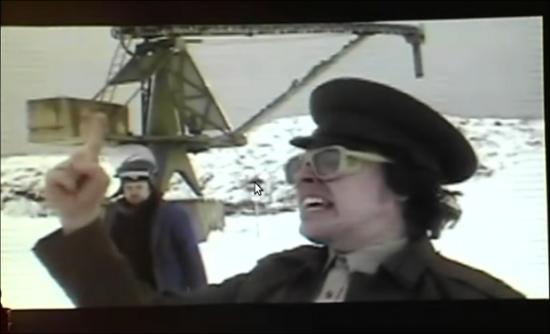
At a HOPE conference a few years back I was interested to hear you talk about the framing of the project as somehow deeply connected with a certain understanding of historiography that you and the other members of monochrom share. Could you elaborate on this a bit?
Debates triggered by postmodern culture have directed our attention towards questions of representation and the relevance of “history” and stories — i.e. The challenging proclamation of a post-histoire, the realization of the impossibility of a meta-narrative of history; the clash between reality and sign systems, the difference between fact and fiction, the impossibility of neutral contemplation or witnessing as well as the positioning of subjective awareness within such representations, etc. All these forms of representation have been playing a central part in the development of national, ethnic and tribal identities since WWII. And (as a by-product of military technology) computer game development is hardly aware of these discourses.
We wanted to combine (retro)gaming and (retro)politics and (crypto)humor to delve into this ongoing discourse. We wanted to harvest the wonderful aesthetic and historic qualities of adventure gaming. It is a commemoration and resurrection, and one more reminder that contemporary gaming (in its radical business-driven state-of-the-artness) should not dare to forget the (un)dead media of the past — or they will haunt them.
If you compare the status of the adventure game in the context of the economic growth of the computer game industry you could state that it is gone. Less than 1% of all computer games written are adventure games. Adventure games are nearly extinct… but only nearly. If media and media applications make it past their Golden Vaporware stage, they usually expand like giant fungi and then shrink back to some protective niche. They just all jostle around seeking a more perfect app.
For many people in the Soviet Unterzoegersdorf team, adventure games are part of their media socialization. For the computer industry it is one of the most successful gaming formats of the past. And for the feminist movement it is proof that a woman — I’m talking about Sierra On-Line’s Roberta Williams — was able to shape the form of a whole industry totally dominated by men.
Computer games are embedded in the cultural framework of technological developments. In the study of technological development and creativity, focusing attention on the failure, the error, the breakdown, the malfunction means opening the black box of technology. Studies have convincingly demonstrated that the widespread inability to understand technological artifacts as fabricated entities, as social and cultural phenomena, derives from the fact that in retrospect only those technologies that prove functional for a culture and can be integrated into everyday life are “left over.” However, the perception of what is functional, successful and useful is itself the product of social and cultural–and last but not least–political and economic processes. Selection processes and abandoned products and product forms are usually not discussed. According to Langdon Winner, there is a sense in which all technical activity contains an inherent tendency toward forgetfulness. Quote: “Is it not the point of all invention, technique, apparatus, and organization to have something and have it over with? (…) Technology, then allows us to ignore our own works. It is license to forget.”
Could you also perhaps talk about the choice of selecting the genre of an adventure game as the incarnation of this downtrodden republic. At the risk of being literal minded, is there any sense in which the existence of ‘Soviet Unterzoegersdorf’ as a kind of place that comes alive through players’ interactions with a program downloaded from the internet has anything to say to how you imagine being able to engage/critique/disrupt the idea of the nation-state?
We are postmodern leftists. A little bit melancholic… but you can count on us. We love to play with layers of consciousness and layers of layers of consciousness. On first view our project could be interpreted as a mock-up of the Soviet Union and the communist state structures that really existed. But, why on Earth do we need so many references to 1980s and 1990s metal music? Or Marvin Minsky? Or Negri? Or Austrian post-WWII history? Or geek adumbrations? Mocking the Soviet State would be much easier. In fact it’s about the wonderful clash between reality and sign systems, the impossibility of neutral contemplation or witnessing as well as the positioning of subjective awareness within such representations. The traditional humanists tend to see the whole philosophic aesthetic postmodern line of thought — from Judith Butler to Lyotard and Derrida — from the wrong angle. Okay, you can’t explain Sun Ra to a Green Day fan now, when he’s laying in the corner, piss-drunk and crooning “Anarchy”. But we think that the (radical) nature of postmodernism is often simply not grasped because people just copy it down into the conservative pattern of thinking which has been indoctrinated into us since the Enlightenment. Of course, on the other hand, it functions as a virus, and there’s nothing wrong with that.
Contemporary art — the field we are usually working in because there’s money — is mostly concerned with systems or systematic concepts. In the context of their work, artists adapt models of individual art-specific or economic or political systems like in a laboratory, to reveal the true nature of these systems by deconstructing them. So would it be fair to say that by their chameleon-like adaptation they are attempting to generate a similar system? Well… the corporate change in the art market has aged somewhat in the meantime and looks almost as old as the ‘New Economy’. Now even the last snotty brat has realized that all the hogwash about the creative industries, sponsoring, fund-raising, the whole load of bullshit about the beautiful new art enterprises, was not much more than the awful veneer on the stupid, crass fanfare of neo-liberal liberation teleology. What is the truth behind the shifting spheres of activity between computer graphics, web design and the rest of all those frequency-orientated nerd pursuits? A lonely business with other lonely people at their terminals. And in the meantime the other part of the corporate identity has incidentally wasted whole countries like Argentina or Iceland. That’s the real truth of the matter.
Read Part 2 of this Interview
http://www.furtherfield.org/features/interviews/interview-johannes-grenzfurthner-monochrom-part-2
Read Part 3 of this Interview
http://www.furtherfield.org/features/interviews/interview-johannes-grenzfurthner-monochrom-part-3
‘Living’ is the result of a six month residency at the V&A by Christian Kerrigan – from January to June 2010 – and it is part of The 200 Year Continuum. The 200 Year Continuum is the title of a project by the same artist that explores the relationship between nature and technology. Interestingly ‘Living’ was exhibited in the same space where it was created: in the digital studio of the V&A. This was a small room with dim light and crowded with rarities. It felt like one was penetrating the secretive and magical space of experimentation of some sort of mad professor.

Once in the space my gaze wandered around a series of oddities. On the right, a table full of raw materials; in the middle of the room, a fish tank with algae floating in high pH waters; on a wall, a real time video projection showing the evolution of the algae; on a different wall, a slide projection showing some drawings; in some shelves, notebooks with notes by the artist; above the sink, chemical products piled up on a shelf; and on each and every window a semi-transparent drawing. No explanations, no titles, nothing. It’s you and the objects. Luckily Christian Kerrigan was always about, meeting visitors and discussing the work. We started looking at the materials on the table. Christian told us those were unprocessed rocks and crystals that he used as the starting point for his drawings. He scanned pieces of amber, moss, fiber glass, volcanic rock or resin and produced a model using 3D software. Then he manipulated that model to create his drawings and printed them on semitransparent paper. He eventually placed them on the windows of the space. This routine allowed him to explore the different stages of a process that makes real matter and virtual space intermingled. It is a practice that explores where the process of creation begins, and what it does to reality. ”The drawings, he tells us, become extensions of the physical material which I started with.” Although we have become accustomed to discuss the hybridity of our nature-culture, the way Christian carefully interwove materialities and virtualities was very evocative. The fact that the drawings were placed on the windows gave yet another layer of complexity to the mixture. The colours of the printings morphed natural light into a hybrid light turning the atmosphere of the room into a creative and ongoing process.
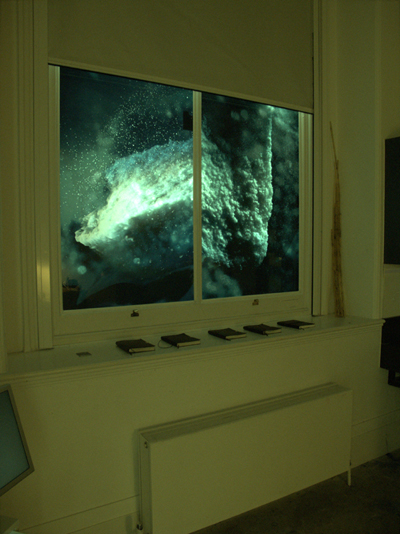
Next I wondered about that mysterious fish tank in the middle of the room where algae lived (and died) in high pH waters: Encased Nature. Apparently the algae reacted to the elevated pH creating a protective coat that eventually killed them. At the bottom of the tank: a graveyard of coated dead algae showed the consequences. I instantly loved the idea. Again an experiment about the hybridity of natural and controlled habitats. I thought it was a particularly dystopic illustration of the environment we inhabit where control works on the conditions of the environment, dictating the way reality unfolds. This is an emerging tendency in our most-discussed societies of control, what has come to be called soft control. And we could take it even further, and see it as a great illustration of today’s climate of fear. In such a habitat, the threat has become virtual and all-pervasive, it has become poisonous in itself, just like high pH. The nightmare of security measures that this artificially produced environment justifies links quite well to the ‘lethal-protective’ coat. What this allegory leaves out, though, is the power of imagination! The capacity of conditions to be turned around, the potential for intervention and deviation from the pre-programmed chain of (re)actions. The idea of projecting a live video recording on the wall was to intensify the experience and highlight the importance of mediation. As Christian argued, we are now more used to experience nature through a lens than to experience its presence. However, the quality of the footage seemed to work against the intentions of the artist and rather than intensifying the experience of that enclosed nature, it tended to obscure it. The particular texture that the webcam gave to the recordings turned that hybrid habitat almost into an abstract movie. On a different corner there was another video projection made out of a series of drawings. Interestingly they had been created using a ‘living technology’ and recorded at a nano-scale. For Living Drawing, the artist had collaborated with Martin Hanczyc from the Department of Physics and Chemistry at the University of Southern Denmark. They had manipulated some protocells that inhabited chemical gradients and reacted to ultraviolet light. When UV light was applied to the fiberglass where these protocells ‘lived’ their motion left traces of colour that were recorded. This technique, although still in its early stages, allowed the artist to ”explore the spontaneous event of drawing by using organic systems”, he told us. Kerrigan’s rather cryptic exhibition proved to be an inspiring and very personal exploration of the blurring between nature and culture in its absolute physicality. Paying particular attention to the materiality of the creative process, from the composition of the materials used, to the chemistry of the drawing process or to the laws of electromagnetism that inform light in its interaction with his work, his methodologies show a passion for unfolding reality in its many scales. His work is that of someone who’s starting to explore rather than someone who’s making an assertion; it is tentative rather than conclusive, it is interesting for its questions rather than its answers. However, even if sometimes vague, it is at points pleasingly dark and sometimes inspiringly intense.
Introduction:
As media attention wanes, the impact of British Petroleum’s Deep Horizon, off-shore drilling disaster continues to unfold. Artists worldwide respond to this new ecological catastrophe in a group show organized by Transnational Temps, an arts collective exploring the interstices of art, ecology and technology. For Andy Deck, one of the founding members of Transnational Temps and the curator of the show, “After a decidedly unsuccessful round of climate negotiations in Copenhagen, the disaster in the Gulf of Mexico frames this exhibition of Earth Art for the 21st Century.”
Now hidden from view by BP’s media campaigns and other de facto censoring actions, the images of oil-covered birds struggling to breathe and fly, oil and dispersant-coated fish, dolphins and whales washing up dead while most sink to the ocean floor, have all but vanished. Partially filling the void are the artists showing here who are recreating topographies: mapping the course of a deadly shadow over our shores and waters; and reinterpreting the sea, its rising levels and largesse, before the vicissitudes of man and nature. Transnational Temps.
———-
Spill >> Forward by Transnational Temps describes itself as an Online Exhibition. It is a website containing images and other media on the theme of oil spills. Some of the images were shown at the MediaNoche gallery from July 30th – November 19th, 2010, with works added or removed so it isn’t just an online catalogue of a meatspace show.
The front page of the site warns that you’ll need a browser that supports HTML5 video and audio, and states that you can view it using patent-free media codecs. From a Free Software and Free Culture point of view this is excellent, your ability to view the art is not restricted by anyone else’s technological or legal machinations. This is also good from an artistic point of view. The software used to view the art can be run and maintained by anyone, making it more accessible, exhibitable and archivable. But this freedom doesn’t extend into the work itself. some of the art uses proprietary software, and none is under a free Creative Commons licence.
The image on the front page, or possibly the image exhibited at the entrance to the exhibition, is not advanced HTML5 video or canvas tag animation but an animated GIF. A Muybridge-ish series of still images of a pelican in flight flickers rapidly up and down as it descends behind an iridescent oil slick that solarizes the bottom half of the image. It’s an effective image in itself, a visually and net.art-historically literate statement that also serves to set the stage for the rest of the show.

This is clearly a politically motivated exhibition, with the theme of the exhibited art centred on a specific historical event (the Deepwater Horizon disaster). Oil spill and petrol station imagery dominates . The resulting art varies from cooly ironic asethetics (Ubermorgen), photo and video journalism (Guillermo Hermosilla Cruzat, S.Slavick & Andrew E.Johnson, Chris Dascher, Adrian Madrid), agitprop (Eric Benson, Geoffrey Michael Krawczyk, Alyce Santoro, Russ Ritell, Terri Garland, Patrick Mathieu), photography(Jessica Eik, Sabina Anton Cardenal), painting(Jessie Mann), collage(Ume Remembers), performance art(Graham Bell), interactive multimedia (Gavin Baily, Tom Corby, Jonathan Mackenzie, Chris Basmajian, Matusa Barros, Mark Cooley), augmented reality (Mark Skwarek and Joseph Hocking) and drawing (Cristine Osuna Migueles, Adrienne Klein, Jesus Andres, Sereal Designers) to video and audio art (Irad Lee, Luke Munn, Gene Gort, Tim Geers, Gratuitous Art Films, Alex George, Collette Broeders, Fred Adam and Veronica Perales, Virginia Gonzalez, Henry Gwiazda, Maria-Gracia Donoso, Jeremy Newman).
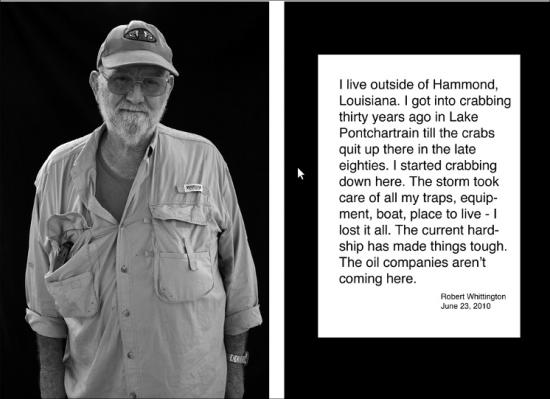
This is a lot to take in but the diversity of the work is a strength rather than a weakness, building a broad and visceral response to the Deepwater disaster. Verbal responses to the disaster from politicians seem unconvincingly nationalistic and corporate in comparison. It might seem hypocritical for artists to criticise the source of the energy that feeds us and allows us to make new media art. But we are trapped in that system, and we must be free to criticise it.
Politically inspired artworks have a difficult history, tending to be either bad politics or bad art. The art in Spill >> Forward is excellent, though. Some has a more direct message than others. Again the diversity of the exhibition plays a positive role here. The immediacy of the agitprop images doesn’t need art historical baggage to be effective, but that immediacy provides a social context for the more contemplative or abstract works. The more contemplative or abstract works don’t hammer home a simple political message but they provide an aesthetic context for the more direct images. They work very well together.
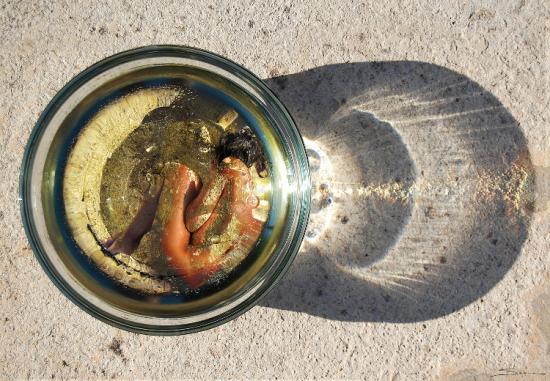

Some of the pieces in the show are clearly illustrations or recordings of work, some are electronic media that can be played on a computer, some are clearly designed to be experienced specifically through a computer system. If you removed the political theme of the show it would still be a visually (and audially) and conceptually rich cross-section of contemporary art. I was going to write “digital art” there but the show includes painting, drawing, performance, and other analogue or offline media recorded digitally for presentation online. The celestial jukebox is hungry.
If I had to pick out just a few pieces from the show I’d say that I was struck by the sounds of Luke Munn’s Deepwater Suite, by the visuals of Ubermorgen’s DEEPHORIZON, by the monochrome images and text of Terri Garland’s photography, by the video mash-up of Colette Broeders’ Breathe and by the critical camp of Graham Bell’s Radical Ecology. I think my favourite is Mark Skwarek and Joseph Hocking’s “The Leak in Your Home Town”, an iPhone app that uses the BP logo as an Augmented Reality marker to super-impose a 3D animation of the Deepwater leak over live video of your local BP petrol station. It is art that could only be made now, technologically, aesthetically and socially.
The aesthetic and conceptual competence of the artistic responses to the environmental and human crises of the oil spills in Spill >> Forward make the case for art still being a relevant and capable answer to society’s need to make sense of unfolding events. Art can still provide a much-needed space for reflection, and Spill >> Forward creates just such a space in a very contemporary way.
The text of this review is licenced under the Creative Commons BY-SA 3.0 Licence.
Ambient Information Systems
English, some texts in German. Translator: Nicholas Grindell
400 pages, 6-colour hardbound, 17.5 x 23 cm
edition of 1,500 unique & numbered.
now available at ambient.publishing.
ISBN-13: 978-0-9556245-0-6
Ambient Information Systems by Manu Luksch and Mukul Patel is a hardback book that presents writing, images and art by and about ambient.tv (Luksch and her collaborators) from during the last decade. Its purple and yellow cover tempered by a tracing paper slip-cover, contains almost four hundred pages of sans-serif text cleanly laid out among images and sidebars. As intermedia artists with a strong emphasis on research and dissemination. Recent works have addressed surveillance, corporate data harvesting, and the regulation of public space.
The material presented in the book ranges from written essays and project proposals through preparatory sketches, computer server log files and video screen grabs to modification of the printed book iteslf by unique rubber stamps and scribbling over sections of text. This diverse and detailed presentation of ambient.tv’s work provides an insight into the inspiration, planning and production of some conceptually and aesthetically rich new media art.
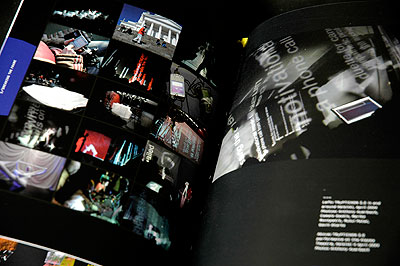
There’s a report from Kuwait during Ramadan 2002, a description of using cutting-edge wearable PCs, a discussion of the role of television, information about the harp in mythology, cyborg markets, the UK Data Protection Act, climate change, anti-gentrification, art and systems theory, UAVs, the Pacific plastic dead zone, and much, much more. There are projects that create free networks, dangerous musical instruments, taped-out surveillance camera boundaries, video installations, photographic images, movies of CCTV footage gained through freedom of information requests, manifestos, snowglobes, and cocktails.
(It’s a fascinating pleasure to read but it’s overwhelming to try and review.)
The portrait of Ambient.tv that emerges from all this is of intensive cultural critique pursued through a playful low-fi digital aesthetic. This isn’t a contradiction, the latter is in the service of the former. Ambient.tv’s projects and proposals tackle serious social and political issues. They do so through skilled use of the aesthetics and attitude of low-fi new media art and technological activism.
The wealth of ideas contained in the essays and other writing in the book show how historical, political and philosophical knowledge grounds the resulting art and indicates how it embodies a critique of contemporary culture.
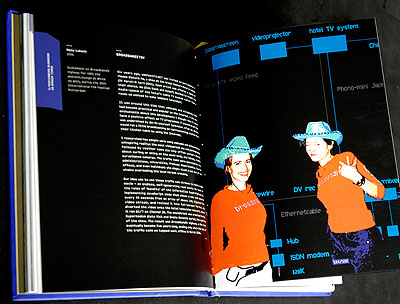
Contemporary culture as seen by Ambient.tv is surveillance culture, the database state with its DNA databases and laws that protect freedom by removing freedom. Ambient.tv is a realistic project, depicting the hidden forms of contemporary society that intrude into our lives. This is heavy stuff, and to air it critically without alienating the audience it requires precisely the playful touch that ambient.tv often bring to their art.
To take the example of FACELESS, 2007, (the first project I personally saw Luksch present), there is an exquisite balance between the disturbing idea of pervasive surveillance, the practical limitations of Freedom Of Information requests, and the visual and science-fictional narrative aesthetic that emerged from this. On their web site it states that it was produced “…under the rules of the Manifesto for CCTV Filmmakers. The manifesto states, amongst other things, that additional cameras are not permitted at filming locations, as the omnipresent existing video surveillance (CCTV) is already in operation.” The result is something more interesting and disturbing to watch than a simple collage of CCTV footage would be. The fact that the work can be made like this, that it can look like this, means something.
This strategy can be seen in “Mapping CCTV around Whitehall”, 2008, as well, which I also reviewed for Furtherfield here, and in many other pieces by Ambient TV.
Reading the proposals and essays shows the depth I suspected to this work, when I first saw it projected in a darkened room is there in its conception and execution.
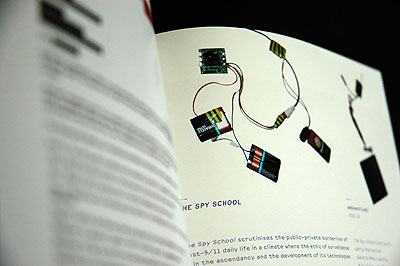
It’s an intense and inspiring experience to be faced with the textual equivalent of a decade-long open studio. The first essay in the book, a theory-laden piece by Fahim Amir, is almost overwhelming in a different way. It’s pure Theory, which will hopefully sell Ambient.tv to the artworld sectors that thrive on that sort of thing, but it isn’t the best introduction for newcomers to the project’s very accessible art.
But what a rare pleasure to be given such a wealth of insight into art that so acutely depicts our times. “Ambient Information Systems” is an important resource for contemporary artists and critics, an insight into the ideas and development of a very successful new media art practice. The grungey, playful, important realism of Ambient.tv’s work deserves presentation in a context that shows just what has gone into the art and just what people can get out of it. This is it.
The text of this review is licenced under the Creative Commons BY-SA 3.0 Licence.
Helen Varley Jamieson’s account of working collaboratively in Madrid at the Eclectic Tech Carnival. On a ‘sprint’, with five women coming together for a week to rebuild the group’s website, physically & remotely.
In the last week of June I went to Madrid for the Eclectic Tech Carnival (/ETC) website workweek – the collective effort of five women coming together for a week to rebuild the group’s website. This is sprint methodology, a concept that I first met in Agile software development, but one that is being increasingly applied as a successful creative collaboration methodology. During the workweek I blogged about the process and this article is an assemblage of the blog posts.
Thinking about the concept of the sprint, I realised that over the years, I’ve participated in a number of theatrical “sprints” although we didn’t call them that. In fact it could be argued that the normal development process for theatre productions in New Zealand is the sprint – a three or four week turnaround of devising/rehearsing/presenting. Except that it doesn’t usually continue the Agile process after the first sprint – evaluation, refinement then the next sprint and iteration – and as a result, the work is often undercooked. But theatre projects that better fit the sprint analogy are some of the workshop-performance processes that I’ve participated in at theatre festivals, where a small group comes together for a few days to create a performance, then some time later meets again in another situation, perhaps a slightly different configuration of people, for another sprint. Each sprint generates a stand-alone performance or work-in-process showing, as well as contributes to a larger evolving body of work that forms the whole collaborative project. Two such projects that I’ve been part of are Water[war]s and Women With Big Eyes (with the Magdalena Project).

Recently I participated remotely in a Floss Manuals sprint, developing a manual for CiviCRM (which is something that I use with the Magdalena Aoteroa site). In this sprint, a group of about 15 people met somewhere in the USA to create a manual for CiviCRM. A few more of us were online, doing things like copy-editing the content. Most of the time there were people active in the IRC channel, chatting about the project and other things going on around them, so I got a sense of their environment, time zone and the camaraderie generated by the intense process.
Sprinting seems like a very logical and effective way to work in many situations: in software development, where each sprint focuses on specific feature development, and allows for a lot of flexibility and adaptation as the project progresses; in theatre, where limited resources make it a practical way to work, and the time pressure forces us to be resourceful and imaginative and also with networks, such as the Eclectic Tech Carnival, whose organisers don’t get to meet physically very often. It also makes sense in the context of our hectic lives, to block out a week or a few days when we agree to put everything else on hold and commit to intense, focused work instead of trying to juggle and multitask, with deadlines pushing out and out.
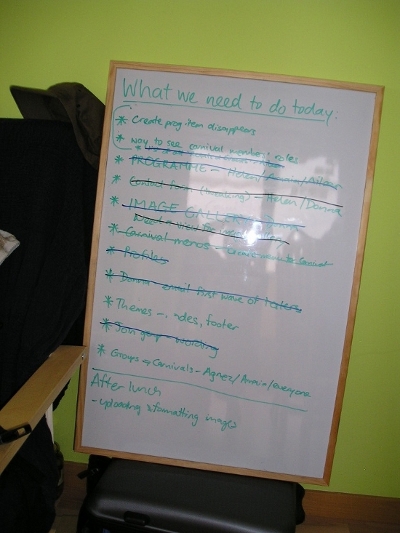
By halfway through the second day of the workweek, the wiki we used to plan and manage the project was filling up with tech specs, user requirements, design ideas, etc. We were getting encouraging emails from others in the network, and chatting to each other across the table and in the IRC. After lunch we did the new Drupal install and things seemed to be moving forward quickly in an organised and collaborative way.
Wednesday afternoon and the heat was oppressive; I put a little rack under my laptop because she was so hot, and my hands were too sweaty to use the trackpad. It wasn’t just Madrid’s weather that was making me sweat – we’d all been working hard on the new site since our late start in the morning (following on from a late night …). Agnes was busy developing the theme for the site, Aileen was working on profiles and user roles while Donna and Amaia were trying to configure mailing list integration and I was using the command line to drush download modules – much easier and quicker than the process of downloading, unpacking, ftp-ing and installing! And very exciting for me to use the command line, which I generally only get to do when hanging out with the /ETC crowd.

We were in that murky middle phase of the process: we’d done a lot of groundwork in terms of defining users, content types, general structure and the functionality required, but everything was still very bitsy and amorphous. But the installation of the test site had happened very easily yesterday, using drush, so that meant we now had something tangible to work with.
Working with Drupal can be pretty frustrating; it seems that every step of the way, another module is required to do what we want – then that module requires other modules, and then every little thing has to be finely configured to work just right with every other piece of the puzzle. From my previous experience with the Magdalena Aotearoa site, I knew we are doing a lot better this time in terms of defining what we need first, but some things we just can’t define until we know what’s possible, which we don’t really know for sure until we actually try it. We *think* we’re going to be able to do everything we want, but getting there isn’t simple. Also, the naming of different components and modules is sometimes ambiguous or confusing – the documentation ranges from really clear and detailed to non-existent. And some things just didn’t seem intuitive to me.
But, with five brains and our different complementary experiences and skills, I was still confident that we would have a new site by the end of Friday; maybe not a completely finished one, but a web site is never finished, is it?
On Friday morning the heat broke with a thunder storm and cooling welcome rain, but it didn’t last long. For some reason I woke up at 7.30am, ridiculously early as we hadn’t gone to bed until 2am. But I was wide awake so I enjoyed a couple of hours of quiet before everyone else awoke, drinking coffee and answering emails. The day before, Agnez and I had got up early to do yoga on the terrace, but the intense rain prevented that on Friday.
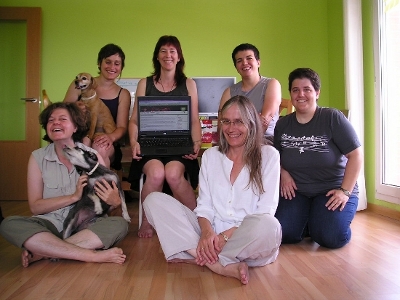
The test site was up and some of the others not present in Madrid were looking at it and trying things out. We’d solved a lot of problems but there were still a number of things not working. I had learned heaps about Drupal in the previous four days, particularly about organic groups, roles, permissions, and views. Altogether it is potentially incredibly flexible and powerful, however it takes time to work out how things need to be done and sometimes it is a confusing and circular process. Changing a setting in one place can stop something in a completely different place from working. However the combination of skills and experience between the five of us meant that usually one of us had at least an idea about how to do things and a couple of times we drew on external expertise via IRC or email.
On the last day, Agnez worked on finishing the theme while Aileen and I tried to work out why our groups are no longer displaying in the og_my view, and how to make the roles of group members visible. Donna had found that mailhandler and listhandler didn’t seem to be a practical way to integrate our mailman lists with Drupal after all – for the time being we’ll stick to the old system – and Amaia had been working on a way to create a programme for each event. The idea is that each /ETC event can be created as an organic group with the organisers having control over content and members within that group, but not being able to edit the rest of the site content. By Friday, we had this working pretty much how we wanted it.
We had planned a barbecue to celebrate the end of the workweek, but the rain prevented that. Instead, we ate inside then took turns to suffer humiliation and defeat with Wii Fitness (Amaia had clearly been practising!). In fact it wasn’t really the end of the sprint – rain again on Saturday morning meant that we decided to keep working longer and only went into the city in the afternoon, for a wander around and then the Gay Pride parade. On Sunday as we began to scatter back to our different parts of the globe, the site was still not live, as we were waiting for more feedback from testers and the finishing of the design themes. However, the site is essentially functional and should be live very soon.
The sprint process enabled us to achieve a considerable amount in a short space of time, sharing our knowledge and developing our skills. We also had great conversations over meals, explored Madrid and Colmenar Viejo, learned how to make Spanish tortilla, attempted a bit of Spanish, went swimming and did yoga. I even fitted in a performance on the first night, with Agnez, and dinner with friends another night. It’s amazing what you can do when you put the rest of your life on hold for a week; the only downside is the catching up afterwards.
In episode five of the popular Israeli sitcom, Arab Labor, Amjad and his family are invited for Passover to the home of a reform family whose son goes to kindergarten with Amjad’s daughter. Amjad is enthusiastic about the Seder ceremony and decides to adopt the concept of the Haggadah into Eid al-Adha (The Festival of Sacrifice). In this way Amjad attempts to balance his life as an Israeli Arab by using some food, a bit of ceremony, and a lot of comedy!
Eating together is a central theme in many religions, going back to ancient Greece. The basic diet in Greece consisted mostly of grains. Meat was only eaten collectively after sacrifices to the gods, which anyone who can get through the first book of the Iliad without drooling will tell you.
It is hard not to bond with people when you eat together. Sometimes the act of eating together can be a tool of influence: business lunches, awards dinners, naked brunches, etc. Even a breakfast might be an opportunity to bond, as Thomas Macauly once said: “Dinner parties are mere formalities; but you invite a man to breakfast because you want to see him.” But can take-away meals be a way to disseminate culture and spread knowledge?
A new take-out restaurant that only serves cuisine from countries that the United States is in conflict with has open in Pittsburgh, PA. It is called Conflict Kitchen. This eatery is similar in concept to Michael Rakowitz’s 2004 project called Enemy Kitchen. The purpose of Enemy Kitchen was to use food to “open up a new route through which Iraq can be discussed. In this case, through that most familiar of cultural staples: nourishment.”
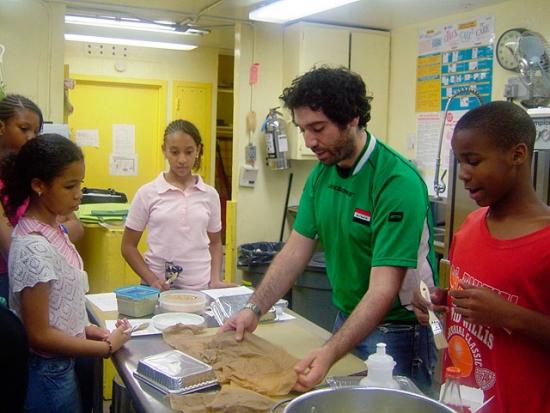
Enemy Kitchen, an ongoing project where Rakowitz collaborates with his Iraqi-Jewish mother. Compiling Baghdadi recipes, teaching the dishes to different public audiences. The project functioned as a social sculpture: while cooking and eating, the students engaged each other on the topic of the war and drew parallels with their own lives, at times making comparisons with bullies in relation to how they perceive the conflict.
Conflict Kitchen is a more commoditized version of Rakowitz’s project, using Iranian cuisine as a vehicle to market “rogue” state culture. Conflict Kitchen will have rotating menus, the next being Afganistan and then North Korea. In an interview with We Make Money Not Art, the creators of the project said that most Pittsburghers don’t know what the restaurant is all about, despite its having made international headlines. Besides creating a more commercially marketable Iran, the food counter brings people from all walks of life together to discuss everything from politics to religion while they wait for their food to be prepared. The creators use this opportunity to chat with the customers and “the conversation naturally goes to Iranian culture–perceptions and misperceptions–and often back to the customer’s own cultural heritage.”
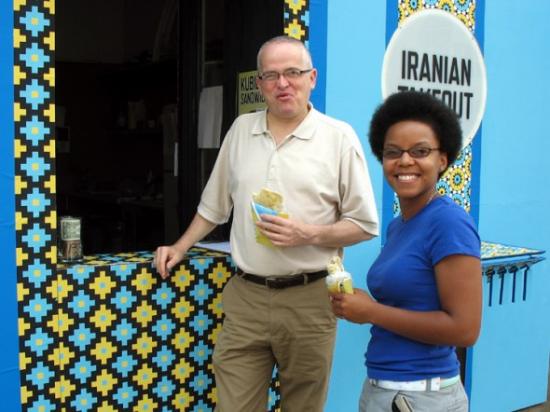
I like the idea of promoting cultural awareness through cuisine, I guess it is the next best thing to having a study abroad experience. Maybe now people can go out, eat and get informed first hand instead of being force fed fear-mongering news by the American media. The main US propaganda machine, Disney, has a long history of using food to influence public opinion. 0ne of their most successful brain-washing campaigns, known as The Magic Kingdom, convinced millions of children and their families that all Mexicans shoot Churros from their fingertips on command, that all Germans walk around in lederhosen serving bratwurst all the live-long day, and that all Chinese children wear rice-picking hats and ride around on one-speed bikes and selling chop-sticks. What sort of chance does Conflict Kitchen stand against such Pavlovian methods of coercian? None whatsvever, but at least you get to eat somewhere that is officially more famous than the Carnegie Deli.
An Interview with Heath Bunting – Part 1
I first met Heath when I moved to Bristol (UK) in 1988. It felt important, even profound. Not in a ‘jump in a bed’ kind of way. Yet our meeting did seem life changing somehow, to the both us. We hit it off and we collided – as equals – our collisions resonated, it shook our imaginations. From then on our paths, our lives connected and clashed regardless. We regularly challenged each other through constant, critical duels of dialogue; about activism, art, technology and ideas surrounding different life approaches and philosophies. From 1988 – 1994 (just before the Internet had properly arrived), in Bristol and London we collaborated on various projects such as pirate radio, street art and the cybercafe BBS – Bulletin Board System. We then went our separate ways exploring our own concerns more deeply, but continued to meet every now and then. Us both meeting in Bristol changed both of our worlds, it built the grounding of where we are now.
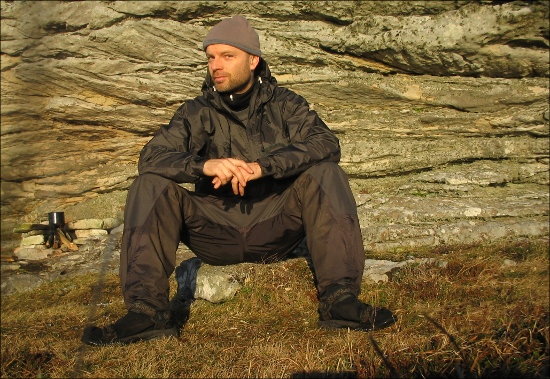
Heath founded the Irational.org collective in 1995, a loose grouping of six international net and media artists who came together around the server irational.org. The collective included Daniel Garcia Andujar / Technologies to the People (E), Rachel Baker (GB), Kayle Brandon (GB), Heath Bunting (GB), Minerva Cuevas / Mejor Vida Corporation (MEX) and Marcus Valentine (GB).
Heath Bunting’s work manifests a dry sense of humour, a minimal-raw aesthetic and a hyper-awareness of his own artistic persona and agency whilst engaging with complex political systems, institutions and contexts. Crediting himself as co-founder of both net.art and sport-art movements, he is banned for life from entering the USA for his anti GM work, such as the SuperWeed Kit 1.0 – “a lowtech DIY kit capable of producing a genetically mutant superweed, designed to attack corporate monoculture”. Bunting’s work regularly highlights issues around infringements on privacy or restriction of individual freedom, as well as issues around the mutation of identity; our values and corporate ownership of our cultural/national ‘ID’s’, our DNA and Bio-technologies “He blurs the boundaries between art, everyday life, with an approach that is reminiscent of Allan Kaprow but privileging an activist agenda.”[1]
In this two part interview we will discuss his current work within two distinctive areas of digital culture and sport-art starting with The Status Project, which studies the construction of our ‘official identities’ and creates what Bunting describes as “…an expert system for identity mutation”. His research explores how information supplied by the public in their interaction with organisations and institutions is logged. The project draws on his direct encounters with specific database collection processes and the information he was obliged to supply in his life as a public citizen, in order to access specific services; also on data collected from the Internet and from information found on governmental databases. This data is then used to map and illustrate how we behave, relate, choose things, travel and move around in social spaces. The project surveys individuals on a local, national and international level producing maps of influence and personal portraits for both comprehension and social mobility.
Marc Garrett: For many years now, your work has explored the concept of identity, investigating the various issues challenging us in a networked age. The combination of your hacktivist, artistic approach and conceptual processes have brought about a project which I consider is one of the most comprehensive, contemporary art projects of our age. The Status Project, deals with issues around personal identity head-on.
Why did you decide to embark on such a complex project?
Heath Bunting:
Three reasons
1. the network hacker
the network hacker fantasises about unlimited access to all systems made available through possession of treasure maps, keys and navigation skills
2. the Buddhist
the Buddhist intends to destroy the self and become only the summation of environmental factors plus find enlightenment in even the most banal bureaucracy
3. the computer scientist
the computer scientist aims to find comfort and hidden meaning in complex data
I am all three and am attempting to combine the obsessions of each into one project.
So far I have
Created a sketch database of the UK system with over 8000 entries
Created over 50 maps of sub-sections of the system to aid sense of place and potential for social mobility
Created system portraits of existing persons
Created software to generate new identities lawfully (off the shelf persons) and sold these identities
I am currently adding more data to the database. Which is split between the human being (flesh), the natural person (strawman) and the artificial person (corporation). Remaking maps using upgraded spider software, researching how to convert my identity generating software into a bot recognised under UK law as a person; and hence covered by the human rights act i.e. right to life and liberty; freedom of expression; peaceful enjoyment of property. I am very close to achieving this.
Did you know that 75% of the human rights act applies to corporations as well as individuals? If you were afraid of corporations in the 90’s and noughties then be very afraid of the automated voices that speak to you on stations or programs that transact currency exchanges, as they will soon be your legal equals as with all Hollywood propaganda, the reverse is true. The human beings will be the clumsy, half wit robot like creatures serving the new immortal ethereal citizens. If you think I am mad or joking, check back in 10 years time.
MG: Way back in 1995, there were already various groups and individuals (including yourself) who were critiquing human relationships whilst exploiting networked technology. Creative people who were not only hacking technology but also hacking into and around everyday life, expanding their skills by changing the materiality, the physical and immaterial through their practice. It was Critical Art Ensemble (CAE) who in 1995 said “Each one of us has files that rest at the state’s fingertips. Education files, medical files, employment files, financial files, communication files, travel files, and for some, criminal files. Each strand in the trajectory of each person’s life is recorded and maintained. The total collection of records on an individual is his or her data body – a state-and-corporate-controlled doppelganger. What is most unfortunate about this development is that the data body not only claims to have ontological privilege, but actually has it. What your data body says about you is more real than what you say about yourself. The data body is the body by which you are judged in society, and the body which dictates your status in the world. What we are witnessing at this point in time is the triumph of representation over being. The electronic file has conquered self-aware consciousness.”[2]
15 years later, we are dealing with an unstoppable flow of meta-networks, creeping into every area of our livng environments. We have mutated, become part of the larger data-sphere, it’s all around us. As you describe, it seems that we are mutating into fleshy ingredients, nourishing a technologically determined world.
HB: Data body is quite a good way to think about it. I consider each human being to possess one or more natural person(s) and each natural person to control or possess none, one or more artificial person(s) (i.e. corporation). The combined total of natural and artificial persons possessed or controlled by a human being can be thought of as their databody. As human beings, we have quite a lot of control over our persons (natural and artificial). The problem is that we either don’t realise this or it takes the time to manage them. It’s possible to obtain a corporation for less than the price of a train ticket between Bristol and London. Why do so many people live without one? Could anti corporate propaganda have something to do with this ?
“What is most unfortunate about this development is that the data body not only claims to have ontological privilege, but actually has it. What your data body says about you is more real than what you say about yourself.”(CAE).[2]
Only if you remain a passive user of it. The natural person is only linked to the human being through such fine devices as a signature, which we decide to give or withhold, most human being’s natural person is actually owned by the government and borrowed back by the human being. This does not have to be the case as we can create and use our own persons.
“The data body is the body by which you are judged in society, and the body which dictates your status in the world. What we are witnessing at this point in time is the triumph of representation over being. The electronic file has conquered self-aware consciousness.”(CAE).[2]
I would say laziness has triumphed over mindfulness. All information about the functioning of natural persons is easily available, all persons have the same rights unless they choose not to claim them. Instead, people choose to get lost in their own selves and dreams, indulged by those that seek to profit from their labour.
Technology is becoming more advanced and the administration of this technology is becoming more sophisticated and soon, every car in the street will be considered and treated as persons, with human rights. This is not a conspiracy to enslave human beings, it is a result of having to develop usable administration systems for complex relationships. Slaves were not liberated because their owners felt sorry for them, slaves were given more rights as a way to manage them more productively in a more technologically advanced society.
MG: Getting back to the part of your project which incorporates a complex process of compiling and creating ‘off the shelf persons’, as you put it. Are you using some of the collected data as a resource to form these new identities, or is it a set of ‘hybrid’ identities?
HB: Please expand this question further…
MG: Near the beginning of the interview, you mention that you “Created software to generate new identities lawfully (off the shelf persons) and sold these identities.” I am asking whether most of these ‘new identities’ that you have formed and sold are, a mixture of different bits of information. Like data-versions of body parts from a machine or vehicle, reused, recycled to recreate, make new hybrid identities?
HB: The identities I can create are all new and legal, they are a portfolio of new unique legal relationships created with existing artificial persons. For example, registering with Tesco Clubcard either creates or consolidates the new natural person http://status.irational.org/identity_for_sale – for a new natural person to be credible, it must be coherent and rational. This is achieved simply by following the rules of the system, the more interrelating links with other persons, the more real the new person becomes.
Off the shelf natural person.
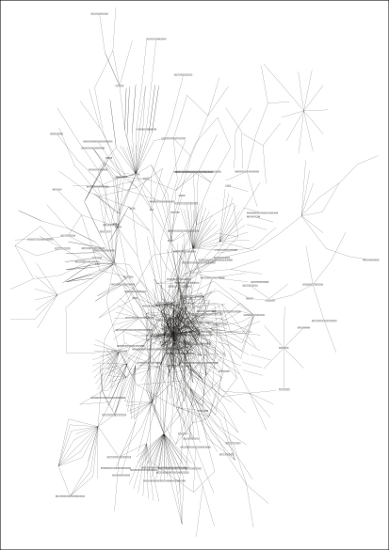
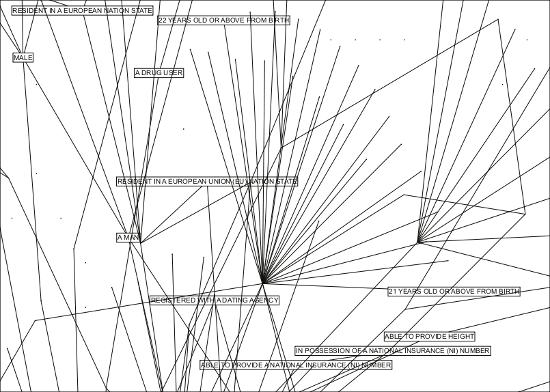
Comes with supporting physical items:

personal business cards, boots advantage card, marriott rewards card, cube cinema membership card, baa world points card, tesco clubcard, vbo membership card, WHSmith clubcard, silverscreen card, airmiles card, somerfield loyalty card, post office saving stamps collector card, virgin addict card, subway sub club card, dashi loyalty card, t-mobile top up card, european health insurance card, waterstone’s card, 20th century flicks card, bristol library card, co-operative membership card, nectar card, oyster card, bristol ferry boat company commuter card, love your body body shop card, co-operative dividend card, bristol credit union card, choices video library card, national rail photocard, bristol credit union account, bristol community sports card, star and garter public house membership card, first class stamp, nhs donor card, winning lottery ticket (2 GBP), t mobile pay as you go mobile and charger…
Upgradable to both corporate and governmental levels.
(500.00 GBP) – SOLD
MG: I can see on the web site, in the section The Status Project – Potentials that there are various ready-mades, ‘Off the shelf natural person – identity kits’. Am I right in presuming that there are individuals out there who have bought and used these kits?
HB: These are mostly existing persons, only one of them was synthetic. I will be setting up a small business soon though to manufacture and sell natural person.
MG: On exploring deeper into the Status Project data-base, there is link to a file called ‘In receipt of income based job seeker’s allowance’. This information is taken from ‘Jobcentre plus’, a UK government run organisation and on-line facility, inviting visitors to search for jobs, training, careers, childcare or voluntary work. How important was this source in compiling data for your database of individuals?
HB: This is only one record of over 8000 in the database, each record refers to one or more other record(s) in the database.
MG: What projects relate to/have influence on The Status Project in some way, and what makes them work?
HB: They Rule[3] – It allows users to browse through these interlocking directories and run searches on the boards and companies. A user can save a map of connections complete with their annotations and email links to these maps to others. They Rule is a starting point for research about these powerful individuals and corporations. A glimpse of some of the relationships of the US ruling class. It takes as its focus the boards of some of the most powerful U.S. companies, which share many of the same directors. Some individuals sit on 5, 6 or 7 of the top 500 companies.
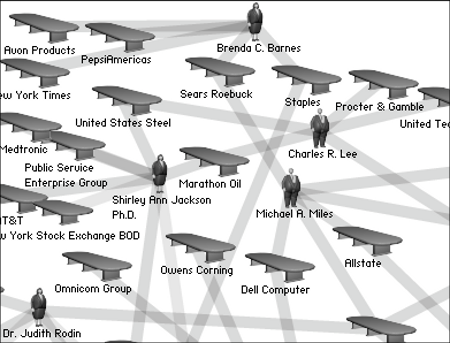
“Go to www.theyrule.net. A white page appears with a deliberately shadowy image of a boardroom table and chairs. Sentences materialize: “They sit on the boards of the largest companies in America.” “Many sit on government committees.” “They make decisions that affect our lives.” Finally, “They rule.” The site allows visitors to trace the connections between individuals who serve on the boards of top corporations, universities, think thanks, foundations and other elite institutions. Created by the presumably pseudonymous Josh On, “They Rule” can be dismissed as classic conspiracy theory. Or it can be viewed, along with David Rothkopf’s Superclass, as a map of how the world really works.”[4]
Bureau d’etudes – distribution.
http://bureaudetudes.org/
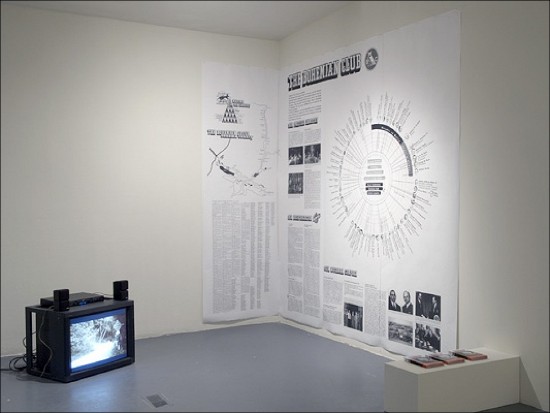
The Paris-based conceptual group, Bureau d’etudes, works intensively in two dimensions. In 2003 for an exhibition called ‘Planet of the Apes’ they created integrated wall charts of the ownership ties between transnational organizations, a synoptic view of the world monetary game. Check the article ‘Cartography of Excess (Bureau Bureau d’etudes, Multiplicity)’ written on Mute by Brian Holmes in 2003.[5]
MG: The sources of data for the Status Project seem to vary in type. Where do you collect them from and how do you collect the different kinds of data?
HB: It ranges from material instruments such as application forms right through to constitutional law and then common sense .
MG: How do you propose the Status Project might be used as a system for ‘identity mutation’?
HB: I want to communicate the fact that people in the UK can create a new identity lawfully without consulting any authority. I intend to illustrate the precise codification of class in the UK system, and there are three clearly defined classes of identity in the UK: human being, person and corporate . I am looking at the borders between these classes and how they touch each other, this can be seen with my status maps. Also, I intend to create aged off-the-shelf persons for sale similar to off-the-shelf corporations.
Taken from the front page of the Status Project:
Lower class human beings possess one severly reduced natural person and no control of an artificial person.
Middle class human beings possess one natural person and perhaps control one artificial person.
Upper class human beings possess multiple natural persons and control numerous artificial persons with skillful separation and interplay.
End of Part 1.
————–
.re_potemkin is a crowdsourced re-make of the film “Battleship Potemkin”. It is a “.f.reeP_” project by .-_-., part of a series of projects that embrace the ideology and means of production of contemporary media and technoculture in order to make art.
From December 2006 to January 2007 .-_-. worked with 15 groups of students from Yildiz Technical University to reproduce Battleship Potemkin on a shot-by-shot basis. Not all shots were reproduced, there are empty black sections in the new film. The students and the setting of the university and its surrounds are very different from the locations and actors of Battleship Potemkin. The domesticity, institutional backdrops and modern street furniture would be very different from the 1920s Soviet backdrops of the original even if they weren’t in colour.
Soviet film-maker Sergei Eisenstein’s “Battleship Potemkin” (1925) is a classic of early 20th century cinema, a piece of obvious propaganda that both fulfils and transcends its instrumental purpose with its exceptional aesthetics. Its most famous images have become cultural icons and cliches. If you haven’t seen it then ironically enough it’s on YouTube so you can watch it there and go “oh, that’s where that came from…” before we continue. Or you can watch it in the side-by-side comparison with .re_potmkin on the project’s homepage.
The Soviet dream became (or always was) a nightmare, an ideology that sacrificed many millions of lives in order to maintain its fictions. Our contemporary liberal democratic society regards itself as unquestionably morally superior to communism for this and many other reasons. The (self-)defining difference between Soviet communism and liberal free-market capitalism is economic ideology. Free markets benefit individuals by reducing inefficiencies.

As free market capitalism has triumphed its means of production have evolved. Corporations emerged as a leading way of organizing labour, leading to utopian social projects in the West in the same era as Eisenstein was working in the East and later to a burgeoning middle class in the post-war era. But since then corporations have become increasingly unapologetic exploitative economic projects.
In order to cut costs and become more economically efficient, corporations can become virtual. They shed jobs to reduce payroll and other costs associated with actually employing people. They then source cheaper labour and production from outside, paying other companies to make the branded goods that the corporation sells. This is known as outsourcing.
A logical next step in corporate cost reduction is to source labour from individuals without paying for it at all. This is known as crowdsourcing. Although individuals who donate their labour to a corporation through crowdsourcing might not be compensated monetarily, they can still be compensated in other ways.
With crowdsourced intangible goods the best way of rewarding people who donate their labour to produce those goods is simply to give the resulting product to them under a licence that allows them to use it freely. Non-profit projects such as GNU and Wikipedia do this very successfully, but corporations are always tempted to try and privilege their “ownership” of other people’s work. Where crowdsourced labour is exploited without fair compensation this called sharecropping.

.re_potemkin is a non-profit project rather than a corporation, and as such it has adopted a GNU or Wikipedia-style copyleft licence. Or at least it claims to have. In a creative solution to the fact that there is more than one copyleft licence suitable for cultural works, .re_potemkin’s licence is a kind of meta-copyleft. Checking the licence page reveals that .re_potemkin’s licence is more a licence offer than a licence.
This avoids the politics of imposing a choice between competing copyleft licences on the producers and consumers of the work. The only problem with this approach is that adaptations of the project, works that build upon it, may end up unable to be combined and built on further because they have been placed under incompatible licences. This is unlikely to happen, but it can be very frustrating when it does.
.re_potemkin is crowdsourced equitably, then. And even in its technical form, .re_potemkin is a free and open resource. it is distributed not in a patent-encumbered, proprietary format such as Flash or MP4 but in the Free Software Ogg Vorbis format. Too few artistic projects follow the logic of their principles in this way, instead sacrificing principle to the at best temporary convenience of the proprietary YouTube or QuickTime distribution channels.
The politics of the production of an artwork are only of aesthetic (rather than art historical) interest if they intrude into the finished artwork. A crowdsourced artwork such as the Sheep Exchange is about crowdsourcing as well as being made by it. The aesthetic of that work (many differently styled drawings of sheep) raises the question of how and why it was produced and this feeds back into the aesthetic experience.
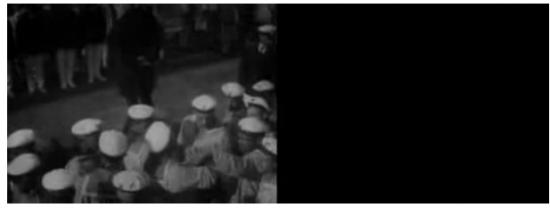
.re_potemkin does not follow the classic crowdsourcing model of an open call for volunteer labour on the internet. It was produced by many groups, but in a closed community. It functions more as an allegory of crowdsourcing than as a literal example of it, but this adds to the project artistically, creating a layer of depiction. The means of production are aestheticized in a way that presents them for the viewer’s consideration in way that can be understood and contemplated more easily than an amorphous internet project.
The “commons based peer production” of free software and free culture is not, to use Jaron Lanier’s phrase, “Digital Maoism”. But the comparison is a useful one even if it is not correct. Utopianism was exploited by the Soviets as it is exploited by the vectorialist media barons of Web 2.0 . re_potemkin gives us side-by-side examples of communism and crowdsourcing to consider this comparison for ourselves.
Within the work the similarities and differences between the original film and its recreation vary from the comical to the poignant. Students in a play park acting out shots of soldiers on a warship, hands placing spoons on a table cloth, crowds gathering around notice boards. This isn’t a parody, it’s an interrogation of meaning. And it is a strong example of why political, critical and artistic freedom is at stake in the ability of individuals and groups other than the chosen few of the old mass media to organize in order to refer to and reproduce (or recreate) existing media.
The text of this review is licenced under the Creative Commons BY-SA 3.0 Licence.
Playing Hard: Urban Art Games of Summer 2010.
Not long ago, urban games were a kind of novelty. Some grew out of the street performance tradition of live theater. Some came from gamers who were involved in tabletop RPG and wanted to experiment with live reenactment. Others were produced by media artists as a way of experimenting with new technologies like GPS and text messaging. But along with these approaches to play, and at times learning from their carefree attitude towards entertainment, there grew another tradition of the urban game, a tradition of using the city focusing on exploration, and as a specific kind of critique. At its worst, the artist produced street game replicates of hollow self-promotion, through corporate, sponsored seasonal festivals. But just as experimental art can involve an analysis of mainstream art, the urban game can embody a palatable critique of the routines of city systems, including the deadening routines of metropolitan life and some of the large scale mechanisms of corporate capitalism.
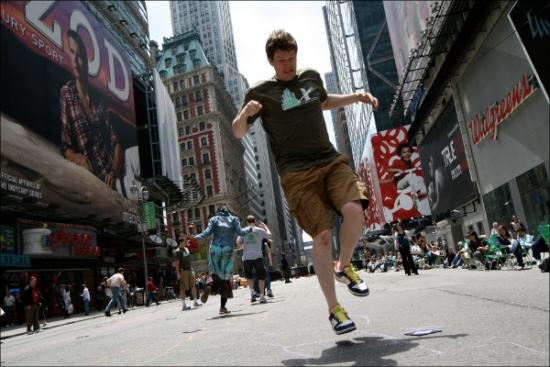
These kinds of games echo the spirit of the Situationist International, which called on artists to create alternate experiences through the construction of situations, psychogeography, and the use of play as a form of critical thinking. Urban games can also remind us of Hakim Bey and his idea of a Temporary Autonomous Zone by using goals, rules, and play with the creation of the ‘magic circle’, a world inside a world, as a method of directing public imagination towards an alternative presence, a way of acting and existing as an independent community within a larger, more repressive reality, even if only momentarily. Urban games also continue the Fluxus idea of the ‘happening’, a participatory media form in which audiences support artists, moving beyond the role of observers of performance to become collaborators in events. With the urban games season about to begin, this review takes a look at how several groups, either consciously or at times not so consciously, have interpreted these traditions for summer 2010.
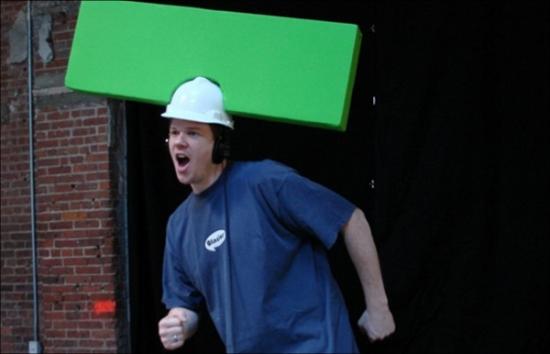
In New York, the much loved Come Out and Play Festival will run from June 4th through June 6th, with events scattered throughout the city borough of Brooklyn. Games include playground mods, GPS exploits, extreme sports, narrative quests, and massively multiplayer scavenger hunts. The festival hosts about forty game designers from around the world and about two thousand people will attend. Executive producer Greg Trefry says COaP strives to be entertaining and is not so much concerned with philosophy as it is with place: “Where the festival is located each year is actually really important to us. We look for interesting parts of the city to experiment on and use as the stage for the festival. So we’ve played everywhere from big anonymous urban areas like Times Square to now more family oriented locales like Park Slope.”
Still, the designers of COaP seem to have a way of engulfing serious issues with comedy and encouraging people reclaim neglected parts of the city by giving them a second look. Along these lines, Atmosphere Industries of Toronto will present Gentrification, a game that picks up on Brooklyn’s ongoing housing conflicts by asking players to assume the roles of real estate developers or neighborhood locals while collecting properties and gentrifying neighborhoods. Meanwhile, Gnarwhal Studios of Baltimore will sponsor ‘Humans vs. Zombies’, a modification of the playground game tag that introduces large groups of strangers to one another by sending players out into the city as the walking dead.. It’s hard to sit in a park, completely shut off from everyone around you, during a two hundred person simulation of a zombie attack. Also part of COaP, New York’s Crux Club will confront community fears of toxic contamination through their game ‘It Lurks in Gowanus’, a hide-and-seek mod that asks participants to track down a creature who has ominously escaped from legendary pollution of the neighborhood’s Gowanus Canal.
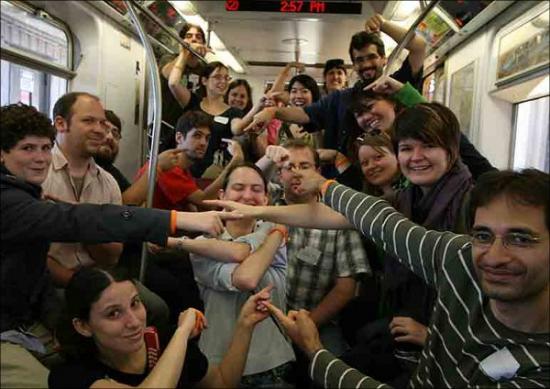
Although he agrees that all urban game events take some kind of cue from historical antecedents like the Situationist International or Fluxus, producer Trefry resists making a formal connection between these movements and COaP. Instead, he says, the main concern was and continues to be community building, getting people together in a surprising way and in an unexpected space: “At its heart, the festival is about running around outside and having fun with your friends. It sounds silly, but that’s such an amazing thing to experience.” This goal of community building has caused COaP to inspire other urban games festivals, including the Hide & Seek Festival in London and the igFest in Bristol, and the Steel City Games Fest in Pittsburgh. The organized versus the random, or the juxtaposition of the carefully designed structure of a game with the largely unstructured, seemingly arbitrary activity of ordinary public space continues to be a common interest among COaP design groups, which are likely to include engineers, academics, and urban planners alongside artists and actors.
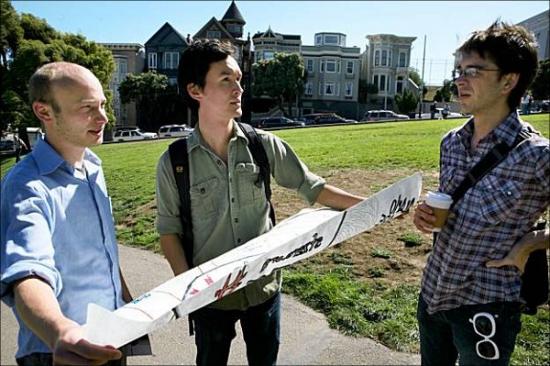
In San Francisco, the artists of SFZero cite Situationism and Fluxus as fundamental to their practice. The SFZero collective was founded by Ian Kizu-Blair, Sam Lavigne, and Sean Mahan in January 2006. Initially, the group used something like a Fluxus process of writing instructions for happening-like events that teams of other players acted out. Soon, these collaborations became the basis for both an online community and real world urban games network that now include over five thousand players. Through the SFZero website, participants initiate events by challenging other participants to ‘Eat a food that frightens you’, or ‘Go to a street corner of your choosing and wait for something fantastic to happen.’ SFZero seems to agree with classic Situationist objectives. A good game shifts awareness, Kizu-Blair says, changing the city for the people who play: ‘Oftentimes the players report that they have a completely different experience of the urban environment as a result of playing and go to places in their city where they have never been before. There is a cinematic quality whereby players live out experiences that normally exist only in spy movies – chases down dark alleys, chance meetings, etc.’ Typical SFZero tasks range from exploring overlooked locations in the city to taking a chance on meeting new people.
As fantastic as some of these instructions sound, and as important as the Internet is to SFZero’s success, Kizu-Blair says it is essential that some productions have a real world component: ‘As people become disenchanted with eight plus hours per day of screen time, they are increasingly gravitating towards hybrid activities that bridge the space between the virtual imaginary and the physical real world. These activities blend the safety and simple pleasure of screens with the risk, tension and excitement of physical interaction. More and more, members of our society will seek to escape from escapism towards an ethics of action, to escape from movies to real experiences. They will find that they have little idea how to have real experiences after their time in the imaginary. SFZero is the transition. ‘SFZero offers both real-world excitement and eternal return to the screen, to re-live, re-experience and re-imagine your engagement with reality.’
Recently, Kizu-Blair, Lavigne, and Mahan have begun staging riskier, more elaborate game events like ‘Journey To the End Of Night’, in which runners try to make it through six checkpoints on foot or by public transportation, while avoiding capture by chasers. An early version of Journey actually opened the 2006 season of Come Out and Play. This July, the veteran SFZero player Lincoln will stage a further production of Journey in Los Angeles.
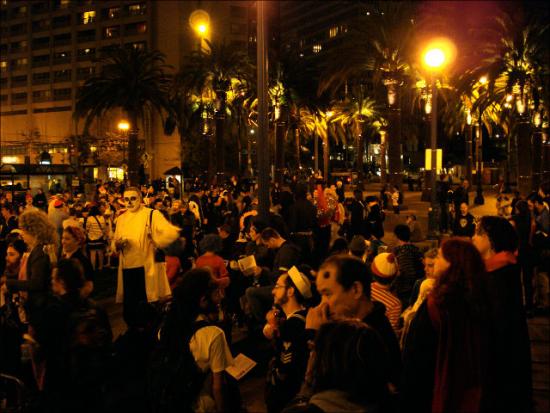
This summer, SFZero will present The Wanderers Union, a game that is loosely based on a French style of self-supported long-distance cycling called randonneuring. To perform Wanderers Union, players get a set amount of time to travel on foot and by public transportation through a series of zones. The idea is to create a single holistic experience of a urban area. The journey intends to juxtapose city spaces in ways that reveal meanings that might otherwise remain unobserved. Players who complete all of the events will progress from an initial four hour wandering to a final twenty-four hour wandering. By using play as a means of gaining understanding, participants will hopefully gain a small degree of mastery over urban space. Kizu-Blair says: ‘It’s like a video game – you level up and gain powers – but you have the added satisfaction of doing something real, and you can include anyone in the experience.’
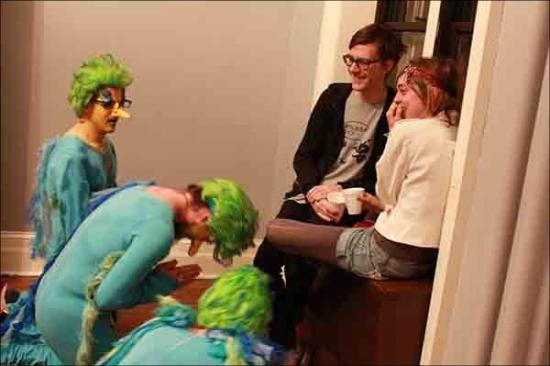
Back on the East coast, the New York based artist’s collective Opt-In found that what started as a thesis project for an experimental film class unexpectedly became a series of multimedia events that now includes filmmakers, fine artists, dancers, performers, and musicians. Titled ‘ZeroDay Exploits’, these evenings are the work of Bryn Jackson, Sarah Lerner, and Nathaniel Barker, who says the group has adapted the Fluxus concept of “happening” to the 21st century: ‘We create immersive environments in which strangers and friends can form new communities around a project, an idea, or a simple good time. We bring people from all walks of life together by promoting open dialogue and the creative expression of public discourse through a vast array of mediums and the use of public space.’
Past themes for the Opt-In exploits have included faith and technology. This July, the group plans to explore the idea of “home” by inviting guest artists and guests to contribute items and materials that evoke a sensation of home. The goal of this event is to create a sense of rootedness in New York, a city of perpetual resettlement. Another major goal for Opt-In is the deconstruction of the digital experience through live performance. According to Barker: ‘Our focus has always been on participation, so our events offer multiple means for encouraging visitors to get their hands dirty including music, secret actors to stimulate conversation, inclusive performances, and free art materials for spontaneous art creation.’
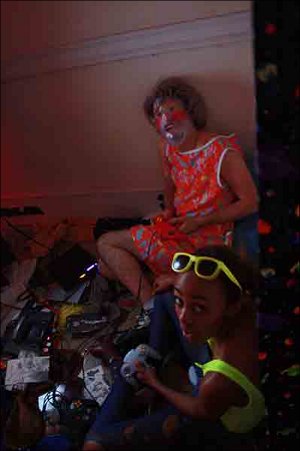
Also related to Fluxus, but in a gesture that seems more directed towards the Brazilian director Augusto Boal, a group calling themselves Invisible Playground Berlin, uses the urban game as a kind of political visualization. Founded by the artist known as Sebastian Quack Sebastian, this group’s interests lie at the intersection of theater and digital gaming. In ‘F Be I, See I A’, Invisible Playground re-enacted peer-to-peer communication as a giant game of urban capture the flag. Later, in Space Station Escape, the group simulated the release of an alien virus inside a phantom space station supposedly docked underground beneath Alexanderplatz.
Sebastian views missions and rule sets as ‘experience systems’, Games are a kind of participatory appropriation, an interrogative code that is placed over or enacted within an existing urban mechanism. In other words, if you want to get people to think more critically about the way immigration works in your city, you’d design a game that plays with the existing locations, activities, and mechanisms of immigration. In this way, Invisible Playground intends to put forward what otherwise goes unnoticed, tolerated, or is even passively accepted. Sebastian is careful to structure his rule sets in ways that highlight the power structures that arise between groups of players, between players and their environments, or between players and organizers. According to the Schwellenland site: ‘Players must work together and against each other. Over SMS and email you are guided to appointments and arrive at places where you were barred from entry until now. The game asks you to decipher who is legal, who is questionable, who can be trusted, who will trust you, who observes you, what should be ignored, what is critical. You are accompanied by a coach and by referees who left the usual national borders behind long ago and are now in Vienna as refugees without papers. These specialists can help you to master the challenges of being from a developing country. But they have also power to turn on you if you make too many errors.’

Finally, with a practice based in both New York and in Brazil, Adriana Varella is one of the artists behind the AnarkoArtLab, a collective of new-media, visual, dancers and genre benders in residence at the Living Theatre. Each month, Anarko creates a multimedia event that runs as part lab, part performance. This summer, the group plans to become mobile and to bring the Lab to different situations and neighborhoods. ‘We are searching,’ Varella says ‘for a last trace of that most ephemeral and elusive state where only a dusty dystopian haunting may yet remain. ‘Of course,’ Varella says, ‘all of them, Dada, the Situationists, Fluxus they are all our ancestors.’
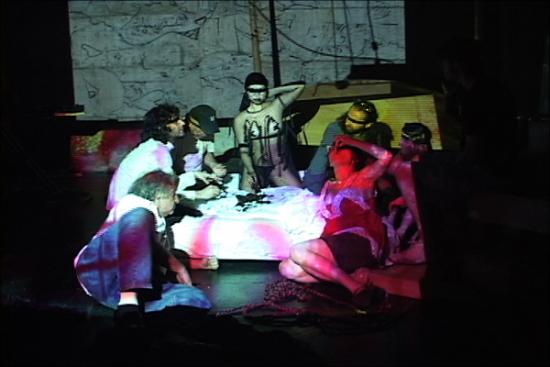
Meat Space and the World Inside the Machine
Danja was an Artist in Residence at Furtherfield’s HTTP Gallery space between the 1st March – 9th April 2010. A Russian born computer artist currently living between Berlin and Rotterdam. Working with diverse methods, technologies and materials Danja ridicules the contemporary affection for digital life and questions the global tendency for cyborgination. Danja co-founded media-lab moddr_ in 2007 which is a joint project at Piet Zwart Institute alumni and WORM Foundation. Based in Rotterdam moddr_ is a place for artists and hackers, engaging with critical forms of media-art practice.
The email interview took place a few weeks after his residency. A recent collaborative project that many readers may already know of, by Danja Vasiliev, Gordan Savicic and Walter Langelaar, all part of moddr.net lab is, Web 2.0 Suicide Machine, which lets you delete your social networking profiles and kill your virtual friends. Danja is certainly prolific, he is also collaborating with New Zealander artist, Julian Oliver who is now based in Berlin. This interview unearths some of the ideas and intentions behind Danja’s personal works, asking what motivates him to use computers, technology and networks, as well as understand more the social contexts and implications of his endeavors.
Marc Garrett: You’ve been on the residency at Furtherfield’s HTTP space http://www.http.uk.net/ for a few weeks now. Before we discuss Netless, the project you have been researching here and some of your other recent works, I think it would be interesting to know about some of your earlier works first. Before the turn of the century you made various net.art pieces. What I find interesting here is that whilst you were creating these works you were also parodying net.art at the same time, was there any particular reason for this kind of approach?
Danja Vasiliev: “HTTP” as an abbreviation was a very significant thing for me throughout the last decade, now having to stay at a place bearing the same title feels like a necessary experience indeed. Fifteen years ago WWW was something very new in Russia and besides the new dial-up aesthetics and world-wide means it brought a complete new layer of existence – “netosphere”, which made my youth. I was trying to understand the technology, though not being of a scientific kind I did it by monkeying around with artworks of others. Later I heard it was called “Open Source” approach. The Website “koala.ru” http://koala.ru.k0a1a.net became a collection of expressionist pages, each page had its own story and often a narrative. Back in the day my arsenal was naturally limited: HTML3, GIF89a (animated) and JavaScript1.2. It felt challenging to work with those tools, file-size was aesthetically just as important as letter-case, and I liked it… I haven’t changed any of the pages since 2002, iirc. The greatest source of my inspiration (image and code -wise) of that time was the baddest of all Superbad – I loved the wackiness yet elegance weaved into the piece. My attraction to /random redirect/ comes from there.
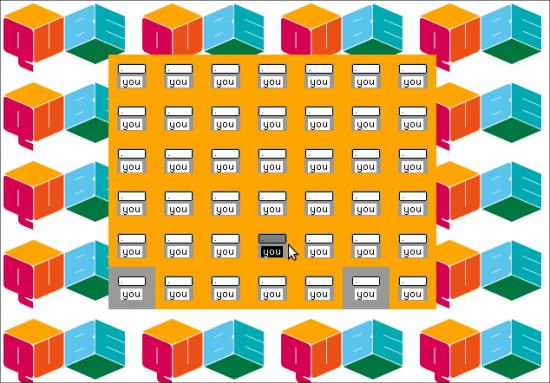
MG: What draws you into using computers in your art practice?
DV: It must be the conflict between the everyday technology and digital life. I’m exploring that edge between the meat space and the world inside the machine. Machine in this case is not just a PC – a single computer is only a part of the network. Acting on those parts adjusts the behavior and perception of the whole – I’m interested in that. Computer hacker attitude and methods are very influential, my works are often merely illustrations of those technological interventions. It makes much more sense to me to try to confront or challenge the technology (and the users) rather then to celebrate the achievements. ‘IT’ today is what politics were yesterday – it and its aesthetics owe to be questioned, broken into pieces, interrogated, sabotaged, reflected upon and ridiculed.
MG: On the NETTIME list on 1st July 2008, Eric Kluitenberg wrote an intriguing essay about your work titled “Turning the machines inside out”.[1] He also discusses something which is close to one of my own interests, about the world as a kind of Interface, metaphorically, virtually and materially “The world according to Rossler is defined by that what transfers between the observer and the “real” world at the interface. It is the interface to the world that defines what can be observed about the “real” world.” Kluitenberg.
Before we talk about Kluitenberg’s concepts regarding his thoughts around your work, I would like to know what your own considerations are in respect of the “World as Interface” and what this means to you?
DV: Well, it always surprises when I come across some theoretical implications confirming, destroying or otherwise connecting to my own work. Perhaps that is why I got to be a maker rather then a thinker – I could never describe the topic I was covering with m/e/m/e 2.0 in a such a profound way as Eric Kluitenberg did. However incapable of posing a verbal question, my intention was indeed to discuss and demonstrate that effect of alienation created by the very medium (or shall I say the interface) of the Web. A System that promotes itself to the users as a fair substitute for reality and provides services for talking, seeing, being and so on, yet fails to escape its own binary jail, i.e. fails to become indeterministic. This determined interface creates determined world – web applications are uploaded straight into our brains. In my perception what we are seeing now is rather reversed or multiplexed inclination of “World as Interface” idea, when devices used for participation in-World and auxiliary systems created around to assist the process, all of this _is_ the World for its users.

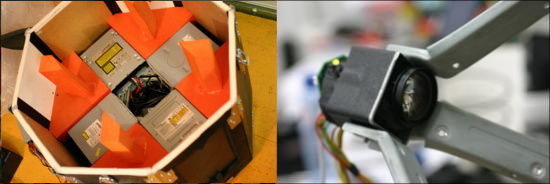
MG: Kluitenberg in his essay, viewed your m/e/m/e/2.0 to be part of a tradition “(inadvertently or not) in the best company of a long tradition of “avant-garde” artists who created various sorts of absurd, ironic, impossible, sadistic, insane or ridiculous machines. His likes are the creators of ominous bachelor machines (Duchamp, Lautreamont, Picabia, Roussel, Kafka), self-destructing machines of the Tinguely type, right down to the magically autistic robotic anti-sculptures of Allan Rath.”
For me, what links m/e/m/e/2.0 to our contemporary world and its ever increasing networked existence “and what we know it to be now” is, its playful and direct link and reference to the Internet. It could not be what it is without the Internet, in which millions have been and are still being taught how to adapt and reconfigure relationships with others, and ourselves. We have become part of the networked driven interface via this socially engineered activity. Would it be presumptuous of me to consider m/e/m/e/2.0 to be a kind of portrait, or a physical re-representation of the human mind or perhaps “head”, metaphorically?
DV: m/e/m/e 2.0 is a manifestation of the absence of any human traits in an act of network communication. Of course it is impossible to demonstrate this without the involvement of the main suspect – the object, the sculpture – is only a half of the work, another half is the Internet. Whenever the piece is not online – it is not complete, and as such – kept in a wooden crate. What “m/e/m/e 2.0” ultimately represents is the physicality of the fellow Internet user on the other end of the wire. It is a device that converts digital instances (copies) of netizens into humanoids, adding flesh around immaterial skeletons. By the analogy to what’s known as “modem” (MOdulator-DEModulator, a device used for digital communication over analog, physical mediums), “m/e/m/e 2.0” is a “semi-modem” or just “mo” without “dem” – it materializes (modulates) without caring to convert back into binary format. It lets the users enjoy their own bodily presence while online; much like the famous FuFme device only with some corrections to the current state of things.
The machine of m/e/m/e 2.0 allows its visitor to sense not only the surfaces of the system but also to get into an strange relationship with the concurent users. The $USER begins to understand intimacy over a distance. The mechanical body can not be re-multiplied to a spontaneous number of requests, instead all of the users come to share one analogue broadcast medium. Whenever someone clicks to open a new link, the information is transmitted to all connected users, “meshing” and colliding their sessions. Seemingly a constraint becomes a feature – unbodied cyberspace gets filled with physical presence. The consequence is that it turns web browsing into a broadcast, collective group activity without any predefined rules. Each page is a part of info-system contained with-in m/e/m/e 2.0, all pages are hyper-linked into a mesh that has no beginning or end.
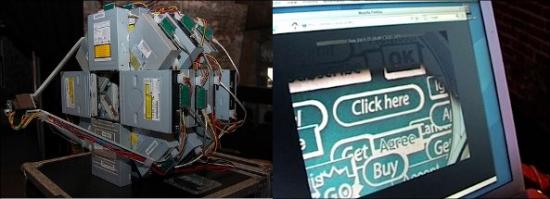
MG: During your residency here in London, you worked on another project called Netless. Could you explain what the project does and why you have chosen to embark on such a venture?
DV: I’m researching a digital communication strategy or technique that would be free from the “panoptical” effect of the Internet. It is too easy to observe and trace users connected to the global network – partly because of the way it is structured, as well as its reliance on the corporate communication channels. It is something about “net neutrality”.
Netless is an attempt to create a new network, alternative to the Internet. More precisely – networks within existing city infrastructures, possibly interconnected into a larger network alike the Internet. Netless is not dependent on specialized data carriers such as cables or regulated radio channels. In fact, there is no permanent connection between all of its hosts (peers) at all – it is net-less. The network is based on the city transportation grid, where traffic of the vehicles are the data carriers. Borrowing the principals from the Sneakernet concept, the information storage devices are physically moved from point A to point B. Numerous nodes of the netless network are attached to city buses or trams. Whenever those vehicles pass by one another a short-range wireless communication session is established between the approaching nodes and the data they contain is synchronized. Spreading like a virus, from one node to another, the data is penetrating from the suburbs into the city and backwards, expanding all over the area in the meanwhile. That broadcast data can be picked-up by anyone.

…the similarities between city transportation maps and circuitry of modern networks are not accidental. their purposes are identical – to provide efficient transport flow between all the locations of the area they cover. routes are designed to match the necessary throughput without congesting at peak times. D.Vasiliev.
MG: What kind of information will be shared within a “Netless” system? Also, are these ad hoc mini-networks going to be attached onto vehicles as secret transmitters?
DV: Constrained by the bandwidth limits Netless networks will work most effectively when dealing with short messages. Technically speaking – “ascii” text, or short base64 encoded binaries/images. Textual data is playing well together with human brains – we often do not need to read a complete sentence to understand the meaning – this would be a great way of keeping the data traffic down. If an error occurs during the transmission of a text message, it can be easily “repaired” by the recipient’s brain – less work for hardware, more information can come thorough. The Netless network integrates into the citizens’ living infrastructures, its data-processing and error-correction routines are outsourced to the users. This is a “hybrid” (parasitic) system, it requires the “human” as resource in order to function.

It would be very interesting to collaborate with some city transportation company, like the one that runs all the buses across London, Arriva. It blankets all areas pretty well as I discovered during my residency at HTTP and if every bus would carry a “Netless” node – the performance would be amazing. That said, it wouldn’t be smart to make “Netless” depend on any commercial entity. Instead I’d rather encourage people to follow up on the project development and start putting together their own “Netless” nodes and take those on everyday travels within the cities. The strength (and bandwidth) of any mesh-network grows proportionally to the amount of nodes involved into the network, thus – (random) network maintenance is the sole responsibility of its users..

MG: This idea of independent nodes/activities of communication, asking us to consider the notion of what it would be like to be “off the grid”; is an important issue. It reflects wider concerns around individual freedoms and civil liberties, in an age where corporations are channelling our everyday digital behaviours towards, a more “official” form of mediation. Where top-down, imposed digital infrastructures are dominating the interface of who our digital, data-bodies are, whilst having control and access to our content, not on our terms. It also reminds me of the battle between pirate radio and institutionally implemented radio broadcasts, as in who owns the medium and what is perceived “correct” information when sharing with others?
DV: Definitely, reclaiming the medium (or the net-space for this matter) does not happen on paper or during some international conference on the topic of net-neutrality. Such changes in disposition of the forces – corporate state on one hand and personal interest/freedom on other is a tedious process; approached top-down it might take ages to complete. Revolution starts on the streets! Rather than having endless debates and explaining to the officials about how and why “Inter Net” is different from “Closed Circuit Tele-Vision”, we respond proactively, ahead of the regulations; creating our own communication strategies. I see my role here in exemplifying the conflict and its resolution.
MG: To the more traditional art practitioner out there who may not be so dedicated or as involved as yourself, in using computers and technology as part of the creative process; how do you manage to keep the balance, maintain the essence of what you do, as art?
DV: I’m for sure not “doing art”. I reflect on certain things, certain events, topics. Those often happen to have technological origins – nothing very surprising nowadays. My works are somewhat “improved” versions or “hacks” of our every-day technology and thus – our life. It is an essential thing for me to work with the same means as the means of the subject of my criticism – e.g. /misuse/ a piece of technology to demonstrate its other potentials; it is a more constructive approach.
MG: What other projects can we expect to see in the future other than what we have discussed so far?
DV: More technological interventions… and I was also thinking of building a railway model! People should check http://k0a1a.net more often.
MG: Will do, and thank you very much for the conversation…
DV: Thank you, nice chatting…
—
danja vasiliev
http://k0a1a.net
Danja was also interviewed by Marc on a Furtherfield, radio broadcast 6th April 2010 – Resonance FM. http://www.furtherfield.org/resonancefm.php
From September 2008 – June 2010, Ellie Harrison undertook a Leverhulme Scholarship on the Master of Fine Art programme at Glasgow School of Art. The thesis published below forms one of the major outcomes of her research during this period. This is part one of four.
The thesis published below forms one of the major outcomes of her research during this period and builds on two earlier essays How Can We Continue Making Art? – which questions whether there is a place for art in a world which is fast approaching environmental catastrophe, and Altermoderism: The Age of Stupid – which uses Nicolas Bourriaud’s Altermodern exhibition at Tate Britain in 2009 as a paradigm for exploring the art world institution’s lack of acknowledgement and action over climate change.
Trajectories: How to Reconcile the Careerist Mentality with Our Impending Doom addresses the ethical implications of continuing to choose the career of artist in the twenty-first century. It is a manifesto of sorts, written from the personal perspective of a young UK-based artist looking to identify worthwhile reasons for continuing down this ‘self-interested’ path, given that the future we are likely to face as a result of climate change, is so different from how we dreamt our careers might pan out whilst growing up under Thatcher and New Labour. It explores how we should aim to evolve our roles as artists, in light of this, and what form a new ‘reconciled practice’ might take.
The graph below shows the projected average global temperature increase over the forthcoming century if we remain on our current trajectory of economic growth and population increase (peaking at 9 billion in 2050), but also incorporate new efficient technologies, a convergent world income and a balanced emphasis on energy sources. This is known as the Intergovernmental Panel on Climate Change’s ‘scenario A1B’ (IPCC 2001).
The graph is extracted from the official AVOID response to the United Nations Climate Change Summit in Copenhagen in December 2009 published on 26 March 2010. AVOID is a United Kingdom governmental research programme led by the Met Office with the aim of averting dangerous climate change (AVOID 2010).

Looking back, 1979 now emerges as a pivotal year in the recent history of our species. On 6 October this year the US central bank, the Federal Reserve, increased interest rates by 20 points (Fisher 2009, p.33). This act, which on paper appears of little significance, opened the gates to a whole new breed of free-market capitalism which, as a result of reduced regulation, would spread its way all over the globe. It signified the switch between Fordism and post-Fordism as the predominant economic system of production; from the ‘disciplinary societies’ of late modernism characterised by Foucault, to the ‘control societies’ which constitute our present reality (Deleuze 1990). It was the beginning of a carefully choreographed and intricately planned neoliberal project, which would serve the “restoration or reconstitution of naked class power” (Harvey 2007, p.119) to an economic elite; radically transforming the way in which all our lives would operate in its wake. Our attitudes towards work, politics, society; our relationships to one another, even the internal structuring of our own minds, would never be the same again.
It is no coincidence that it was on 4 May 1979 that Margaret Thatcher came to power in the United Kingdom; she was, of course, instrumental in overseeing this ‘revolution’. What is coincidental however is that it was also in 1979, on 11 March to be precise, that my own life began its trajectory. The rapidly changing society into which I was born would not only prove fundamental in shaping the artist I would become, but it would also prove key in determining the ‘mentality’ with which I would come to visualise my future: to plan my career.
‘Thatcher’s children’ as my generation are known, were indoctrinated to believe that the world owed us a living (Blackburn 2009). “Success”, she said, was “a mixture of having a flair for the thing that you are doing; knowing that it is not enough, that you have got to have hard work and a certain sense of purpose”. It was simply a question of making the right career choice. If we aimed for the top, we had just as much chance of getting there as anyone else. All we had to do was look out for number one. The secret, she taught us, was to have a strategy – to “plan your work for today and every day, then work your plan” (M. Thatcher n.d.); to think about what we wanted our lives to be like in the future and then to work flat-out towards that ‘goal’.
In hindsight, it now seems inevitable that my life took the course it did. Entering art school for the first time in 1997 – the year the seminal Sensation exhibition at the Royal Academy of Arts took place – we could see ‘success’ being played out before our very eyes. A group of Young British Artists (YBAs), just one generation older, were now ‘living the dream’. As 18-year-old students, we were now able to visualise the paths we wanted our own lives to take and to see exactly where we aimed to find our fortune. Like most of my art school peers, I was from an “above average social background” – raised in suburbia by a middle class family of teachers. And, as Hans Abbing notes, this added “social capital” gave me the “flair, self-assurance, and… sense of audacity” (Abbing 2002, p.95) which now seemed so essential to commodify and sell myself – to keep going, regardless of failure and rejection, with eyes firmly fixed on the prize.
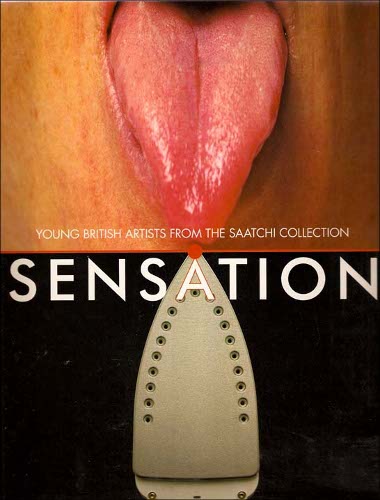
My career trajectory led me blinkered along a familiar path – a BA (Hons) degree in Fine Art from Nottingham Trent University; a Postgraduate Diploma in Fine Art from Goldsmiths College (where nearly all my YBA role models had been before me). It was as though every incremental step took me ever closer towards my ‘goal’: towards ‘success’. Finally, I won a scholarship to study on the Master of Fine Art (MFA) programme at The Glasgow School of Art; yet another prestigious art school to add to my expanding curriculum vitae. What I hadn’t banked on, however, was that on the very same day I was heading north up the M1 to Glasgow to begin this new stage in my life, the global economic order was fast collapsing around us into its own new distinct epoch, taking with it the belief systems which had been carefully constructed around it over the past 29 years.
On 15 September 2008 the investment bank Lehman Brothers Holdings Inc. filed for the biggest bankruptcy in US history with more than $600 billion of debt (Mamudi 2008). Over the course of the next year a slew of bailouts took place all over the world to prevent other banks going under. The neoliberal project had, “in every sense, been discredited” (Fisher 2009, p.78). The ideology on which, knowingly or not, my own life’s trajectory had been modelled was now on the ‘scrapheap’. And, as Mark Fisher suggests, a bleak, empty and relentless state known as ‘capitalist realism’ – in which nobody could believe, but equally nobody could stop – crept in from every corner to fill the void.
Society, it seemed, had reached a hiatus; a ground zero amid a sea of “ideological rubble” (Fisher 2009, p.78). Lots of suggestions emerged about what had gone wrong, lots of questions about where we should go next. From the privilege of my funded MFA place, I was able to enter into my own period of self-reflection about the path I had so blindly been following. Was the vision I upheld of my life in the future essentially a delusion, based on a now defunct model of ‘success’ from the past? Was I suffering from the “self-deceit” (Abbing 2002, p.114) Hans Abbing diagnoses to be prevalent in young artists, coupled with the complete “disavowal” (Fisher 2009, p.13) of the negative side-effects of my complicity in the system of capital? With a sudden and overwhelming urgency it felt essential that I question how I could begin to reconcile my career choice and the entrepreneurial methodology (Abbing 2002, p.96) with which I was pursuing it, with the harsh realities that both science, and now science fiction, are predicting the future actually holds in store…
Films such as The Road (Hillcoat 2009) offer us a very different picture of the forthcoming century. In this barely hospitable, yet eerily recognisable version of our present world there is no Turner Prize, no Frieze magazine to be reviewed in; no canon to become part of. In fact, there is no scope for the non-essential; no room for aesthetics; no space for art at all. Whereas it now appears clear that the trajectory I had planned for my life since art school is constituted by fantasy, the trajectory which befalls the lives of the protagonists of this particular post-apocalyptic vision is in part based on what the current overwhelming scientific evidence points towards.
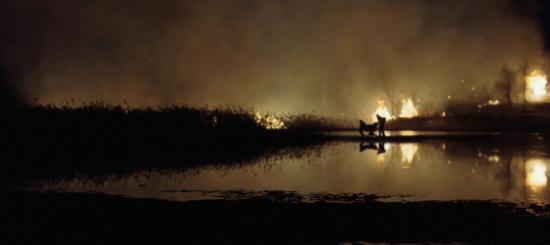
The United Nations Climate Change Summit which took place in Copenhagen in December 2009 offered what many scientists and campaigners referred to as our ‘last chance’ of averting global catastrophe within the coming century. Prior to the talks the 10:10 Campaign’s ‘call to arms’ statement outlined what sort of trans-governmental worldwide commitment it would be necessary to achieve:
“The best deal currently on the table is that from the EU, which calls for a 30% reduction [in greenhouse gas emissions] by 2020 (compared to 1990 levels). If this deal were to be accepted (which is a very big if, given that Japan argues for 8%, Australia for 5% and America for between 0%-6%) and if the emission cuts were then carried out (which is an even bigger if), this would give us about a 50/50 chance of not hitting the dreaded two degrees. Two degrees is where we trigger runaway climate change [emphasis added]: two leads to three, three to four, four to five, five to six… by which time it’s about over for life on Earth.” (Armstrong 2009b)
Given that Copenhagen was by all accounts a complete failure and that, in fact, not even the least significant of the ‘deals’ presented was agreed upon and signed off, the balance now appears to be swaying decisively towards the latter of these two potential trajectories. We find ourselves “trapped inside a runaway narrative, headed for the worst kind of encounter with reality” (Kingsnorth & Hine 2009, p.11). Unless it is fully acknowledged and hastily acted upon in consensus across the globe, climate change “threatens to render all human projects irrelevant” (Kingsnorth & Hine 2009, p.6). It appears that it is not just the future of our careers we should be worried about but now, more likely, the fundamental ability of our species to survive on the planet.
The concern of this essay is to uncover exactly how we could have arrived at a situation where these two distinct visions of our future can so wildly diverge – to explore the factors which have allowed our careerism to persist, in light of advice to the contrary. The aim is to illuminate the significance of this ‘now or never’ moment in the history of our species as an opportunity for radical change, and to develop a ‘plan of action’ and a ‘new moral code’ which may help us, as artists, determine what role we can and should play in the reality of the twenty-first century.
To read Part 2 of this article visit this link: http://www.furtherfield.org/articles/trajectories-how-reconcile-careerist-mentality-our-impending-doom-part-24
——-
References:
Armstrong, F., 2009b. What is 10:10? 10:10 Campaign website. Available at: www.1010uk.org/1010/what_is_1010/arms [Accessed April 10, 2010].
Abbing, H., 2002. Why Are Artists Poor?: The Exceptional Economy of the Arts, Amsterdam: Amsterdam University Press.
AVOID, 2010. Will the Copenhagen Accord avoid more than 2°C of global warming? AVOID website. Available at: ensembles-eu.metoffice.com/avoid [Accessed May 3, 2010].
Blackburn, S., 2009. Do we need a new morality for the 21st century? The Guardian Culture Podcast. Available at: www.guardian.co.uk/culture/audio/2009/nov/02/cambridge-festival-of-ideas.
Deleuze, G., 1990. Society of Control. L’Autre Journal, (1). Available at: www.nadir.org/nadir/archiv/netzkritik/societyofcontrol.html.
Fisher, M., 2009. Capitalist Realism: Is There No Alternative?, Ropley, Hampshire: 0 Books.
Harvey, D., 2007. A Brief History of Neoliberalism, Oxford: Oxford University Press.
Hillcoat, J., 2009. The Road, Dimension Films.
IPCC, 2001. Special Report on Emissions Scenarios. GRID-Arendal website. Available at: www.grida.no/publications/other/ipcc%5Fsr/?src=/climate/ipcc/emission [Accessed May 3, 2010].
Kingsnorth, P. & Hine, D., 2009. Uncivilisation: The Dark Mountain Manifesto. Available at: www.dark-mountain.net/about-2/the-manifesto.
Mamudi, S., 2008. Lehman folds with record $613 billion debt. MarketWatch website. Available at: www.marketwatch.com/story/lehman-folds-with-record-613-billion-debt?siteid=rss [Accessed April 25, 2010].
Thatcher, M., Margaret Thatcher Quotes. About.com website. Available at: womenshistory.about.com/od/quotes/a/m_thatcher.htm [Accessed May 2, 2010].
To read Part 1 of this article visit this link:
http://www.furtherfield.org/articles/trajectories-how-reconcile-careerist-mentality-our-impending-doom-part-24
What is curious about the neoliberal project that kick-started in the year of my birth, is that, from the politics of the preceding decade, it appeared history could have taken a very different course. 1972 marked the publication of The Limits to Growth – a study commissioned by the humanitarian think-tank the Club of Rome to estimate the planet’s reserves of natural resources, “including topsoil, fresh water, minerals, forests and oceans” – questioning for the first time what might be the consequences of “another 100 years of exponential growth” (M. Fowkes & R. Fowkes 2009, p.670). The findings of the study were so significant that they are cited by Maja and Reuben Fowkes as a revelation for the future of humanity on a par with Copernicus’s discovery of Heliocentrism: putting our lives on planet earth sharply into perspective. Essentially the report gave us all the information we needed to know: that the way of life modernity had accustomed us to, was not sustainable. The whole system on which our modern liberal democracies were structured was supported by a myth of continual and infinite progress (Kingsnorth & Hine 2009, p.3) and a universal belief that the future will always be better than the past – that it is always within our capable hands to control our destinies.
Rather than take heed of this advice and look for alternative ways of structuring our societies, what actually began towards the end of the seventies, continuing right up to the present day, was the opposite: a complete and utter acceleration of our production and consumption. Post- The Limits to Growth our lives were allowed to continue in a fashion now no longer based on scientific facts, but on fantasy:
“What this… illustrates is the fantasy structure on which capitalist realism depends: a presupposition that resources are infinite, that the earth itself is merely a husk which capital can at a certain point slough off like a used skin, and that any problem can be solved by the market… The relationship between capitalism an eco-disaster is neither coincidental nor accidental: capital’s ‘need of a constantly expanding market’, its ‘growth fetish’, mean that capitalism is by its very nature opposed to any notion of sustainability.” (Fisher 2009, pp.18-9)
We were allowed to continue because we repressed this truth. Our ‘denial’ was constituted by what Freud described as our inability to hear the things which did not fit easily with the way we envisaged ourselves in the world (Kingsnorth & Hine 2009, p.9). We simply blocked out any hint of a hitch or obstacle to our career trajectories and carried-on regardless. Neoliberalism achieved this ‘state of mind’ purposefully – by pacifying us with the things we thought we wanted, that would make us happy, whilst removing the possibility for resistance. The “drive towards atomistic individualisation” (Fisher 2009, p.37) captured in Margaret Thatcher’s dictum “There is no such thing as Society. There are individual men and women” (M. Thatcher n.d.), plunged us further into our internal solipsistic worlds; from where it became almost impossible to fully empathise with others, to acknowledge the wider consequences of our actions, to see beyond the fantasy – to believe that ‘an alternative’ might be possible. We lost our political ‘agency’ as our liberal democracies became governments-as-administration (Zizek 2009b); appealing to our burgeoning “individual ideals” (Strawson 2008) – to “short-termism” (Brown 2009) – rather than the bigger picture and a realistic long-term plan.
In his recent book First as Tragedy, Then as Farce, Slavoj Zizek describes the strategies the neoliberal policy makers employed to continue to maintain this state of denial well into the twenty-first century, explaining how the negative side effects of the bursting of the dotcom bubble in 2000 had been countered by a push on cheap loans to stimulate the housing market. This had simply allowed the US to “continue dreaming” (Zizek 2009a, p.20) for that little bit longer; essentially just prolonging the global crisis until a later date: until now.
“It’s useless to wait – for a breakthrough, for the revolution, the nuclear apocalypse or a social movement. To go on waiting is madness. The catastrophe is not coming, it is here. We are already situated within the collapse of civilisation.” (The Invisible Committee 2009, p.96)
The significance of this point in history cannot be underestimated. The hiatus caused by this latest epic crisis of capital should have given all of us opportunity for self-reflection. The connections between capitalism and environmental catastrophe have once again been starkly illuminated and so too has our own complicity in, and responsibility for, both. As the many climate scientists and campaigners have been telling us, we now only have one decade left – until 2020 – to stabilise and begin to reduce our rapidly increasing greenhouse gas emissions or we will be unable to avoid hitting the “dreaded two degrees” (Armstrong 2009b) – the tipping point at which we trigger runaway climate change and a rapid irreversible and uncontrollable descent into a new world of which the visions of The Road are not too much of an exaggeration.
Even mainstream politicians hungry for votes are forced to admit that “the age of irresponsibility is giving way to the age of austerity” (Cameron 2009). It does seem “useless to wait” (The Invisible Committee 2009, p.96). Now provides the opportunity to radically rethink the way we live, not just in practical terms, but in the way our minds perceive of ourselves in the future; of what we are working ‘towards’. We need to reverse our very ontological foundations so that we become capable of comprehending the opposite of progress – of approaching life in a world where deflation becomes the norm and where rationing is “inevitable” (Fisher 2009, p.80).
As artists – the producers of the non-essential – this rethink seems all the more vital and all the more urgent. It is now our ‘responsibility’ to redefine our roles within this new world, within the “collapse of civilisation” (The Invisible Committee 2009, p.96). As we approach the inevitable challenges of the forthcoming century we can no longer be immune to ethics – we must begin to question what practical function our work can have. And, if we decide that we can still persist in our roles as artists, then we must begin to generate new ways of finding “intrinsic motivation” when our traditional motivational structures of striving towards ‘goals’ such as “recognition and fame” (Abbing 2002, p.82); of creating a ‘legacy’ for ourselves in the future, no longer seem viable.

It is typical in periods of crisis (and opportunity) such as this to look to the past for guidance. Retrospective critique (as used to ‘set the scene’ for this essay) helps us to understand the causes of our current predicament in terms of a greater historical trajectory, to help us make sense of our own lives biographically. The real challenge, however, is in developing the suggestions, ideas and solutions that are essential to help us move on. The proceeding sections of this essay turn to two manifestos from 2009 which attempt just this: Ecoaesthetics: A Manifesto for the Twenty-First Century by Rasheed Araeen and Uncivilisation: The Dark Mountain Manifesto. The intention is to draw together their recurring ideas in order to formulate a ‘plan of action’ which may constitute our ‘new moral code’, and then to examine how some of these ideas are already being put into practice, not just by some artists, but by other more radical elements of society.
In September 2009, the international journal of “critical perspectives on contemporary art and culture” Third Text dedicated an entire issue to contemplating a vision of the future of art, in which Araeen’s manifesto is published. In the preface, Araeen and his co-editor Richard Appignanesi give their own diagnosis of the predicament of artists “now as we face a legacy of failures in modern history that endangers the future prospects of humanity” (Araeen & Appignanesi 2009, p.500). Their suggestion is that we have reached a cynical and solipsistic impasse which it is essential to overcome:
“… the very concept of art will have to liberate itself from the two historical limits of containment and legitimisation. One is containment in the artist’s own narcissist ego; the other is art’s dependence for its legitimisation as art on the institutions that facilitate and promote art only as reified commodities placed in museum and marketplace showcases.” (Araeen & Appignanesi 2009, p.500)
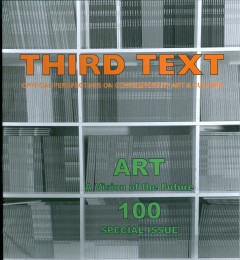
Ego and individualism have always gone hand-in-hand with the relatively autonomous role the artist has historically enjoyed within society, however, it appears that these characteristics have only been exacerbated in recent years. Neoliberal ideology has led to a “convergence of artistic and entrepreneurial values” (J. Thatcher 2009, p.5) – flexible, creative and autonomous modes of operating have been co-opted by the business world, just as ‘the careerist mentality’ has been inherited by artists. Recent mainstream television programmes such as School of Saatchi (Priddle 2009) and Goldsmiths: But is it Art? (Kerr 2010), which pit artists’ egos and entrepreneurial skills against one another, show the extent to which these attitudes have become the norm.
The super-competitive environment of the ‘atomised art world’ engenders a survival instinct in artists which causes us, knowingly or not, to make our sole objective the expansion of our curricula vitae. The emphasis is on the development of a “narrative” – on forming a “brand identity” (Prince 2010, p.10), because this presents itself as the most efficient means to the desired ends of “recognition and fame” (Abbing 2002, p.82). Trapped in a perpetual attempt to impress art world institutions, artists inevitably end up feeding them with the art that they think they want rather than stopping to question exactly what they are producing and why.
In a pre-neoliberal world, choosing the role of artist was seen as an alternative to the mainstream: a point of resistance, a political statement even (Walker 2002) – art offered a potential strategy of “opposition to capitalism” (J. Thatcher 2009, p.6). Now as a small component part in this means / end cycle – art – simply acts an instrument to serve the “career ambitions of self-centred artists” – its “significant critical and social function” (Araeen 2009, p.680) disabled in the process. But, at this particular point in our history, art’s power in “subverting the dominant hegemony” (Mouffe 2007) – in creating an ‘alternative knowledge’ – may be its only redeemable function.
Araeen’s call for art to be liberated from “containment and legitimisation” (Araeen & Appignanesi 2009, p.500) foresees the unprecedented power he believes our ideas could have if completely detached from capitalism:
“It is in fact artistic imagination, not art objects, which, once freed from the self-destructive narcissist ego, can enter this life and not only offer it salvation but put it on the path to a better future.” (Araeen 2009, p.683)
He goes as far as to suggest that artists should “abandon their studios” and “stop making objects” (Araeen 2009, p.684). He urges us to reconfigure our roles to such an extent that our creative skills are put to use in conceptualising real-life practical projects, such as creating solar-powered desalination plants, which simultaneously address the two imminent global challenges of energy and freshwater shortages. Art should renounce its “freedom from function which constitutes its autonomy” (Prince 2009, p.7), leave the world of the ‘non-essential’ and begin to offer us with ‘practical solutions’ to real life problems.
Whereas Araeen’s manifesto (inline with the desperate pleas of environmental campaigns such as 10:10) gives a sense that something can be done to avert ‘our impending doom’. There is, however, another concurrent school of thought which encourages us to embrace our fate. Uncivilisation: The Dark Mountain Manifesto was published in 2009 by writers Paul Kingsnorth and Dougald Hine, as a vision of the future of literature in the new form of “uncivilised art” (Kingsnorth & Hine 2009, p.13). It takes the pessimism of beliefs such as those of James Lovelock: that humans are too stupid to prevent climate change (Hickman 2010, p.12) and challenges us to invert these to become a positive creative force:
“We live in a time of social, economic and ecological unravelling. All around us are signs that our whole way of living is already passing into history. We will face this reality honestly and learn how to live with it.” (Kingsnorth & Hine 2009, p.19)
The key is in developing a sense of objectivity about the systems in which we are enmeshed. We are invited to “stand outside the human bubble”, to “tug our attention away from ourselves and to turn it outwards; to uncentre our minds”: essentially to put “civilisation – and us – into perspective” (Kingsnorth & Hine 2009, p.13).
Once we are able to shift our attitude from that of hubris to that of humility, it becomes easier to accept that resources are indeed finite; civilisations do collapse and that species, including our own, become extinct. With this finitude as a certainty, the petty squabbling of the art world and the insignificance of the ‘goals’ we have been striving towards become evident. We can be liberated from our career plans; from the careful crafting of our own personal legacies and can refocus our attentions on the immediacy of the present (Bey 1994), for it is perhaps here where we should learn to find meaning and happiness.
To read Part 3 of this article visit this link: http://www.furtherfield.org/articles/trajectories-how-reconcile-careerist-mentality-our-impending-doom-part-34
————
References:
Abbing, H., 2002. Why Are Artists Poor?: The Exceptional Economy of the Arts, Amsterdam: Amsterdam University Press.
Araeen, R., 2009. Ecoaesthetics: A Manifesto for the Twenty-First Century. Third Text, 23(5), 679-84.
Araeen, R. & Appignanesi, R., 2009. Art: A Vision of the Future. Third Text, 23(5), 499-502.
Armstrong, F., 2009a. Franny Armstrong: If you’re not fighting climate change or improving the world, then you’re wasting your life. The Guardian, 8.
Armstrong, F., 2009b. What is 10:10? 10:10 Campaign website. Available at: www.1010uk.org/1010/what_is_1010/arms [Accessed April 10, 2010].
Bey, H., 1994. Immediatism, Oakland, California: AK Press.
Brown, W., 2009. What will be the legacy of recession? The Guardian Culture Podcast. Available at: www.guardian.co.uk/culture/audio/2009/oct/26/culture-cambridge-festival-ideas.
Cameron, D., 2009. The Age of Austerity. The Conservative Party website. Available at: www.conservatives.com/News/Speeches/2009/04/The_age_of_austerity_speech_to_the_
2009_Spring_Forum.aspx [Accessed April 25, 2010].
Fisher, M., 2009. Capitalist Realism: Is There No Alternative?, Ropley, Hampshire: 0 Books.
Fowkes, M. & Fowkes, R., 2009. Planetary Forecast: The Roots of Sustainability in the Radical Art of the 1970s. Third Text, 23(5), 669-674.
Kerr, A., 2010. Goldsmiths: But is it Art?, BBC 4.
Kingsnorth, P. & Hine, D., 2009. Uncivilisation: The Dark Mountain Manifesto. Available at: www.dark-mountain.net/about-2/the-manifesto.
Mouffe, C., 2007. Artistic Activism and Agonistic Spaces. Art & Research, 1(2). Available at: www.artandresearch.org.uk/v1n2/mouffe.html [Accessed April 25, 2010].
Priddle, A., 2009. School of Saatchi, BBC 2.
Prince, M., 2009. Art & Politics. Art Monthly, (330), 5-8.
Prince, M., 2010. Remakes. Art Monthly, (335), 9-12.
Strawson, P.F., 2008. Social Morality and Individual Ideal. In Freedom and Resentment and Other Essays. London / New York: Routledge, pp. 29-49.
Thatcher, J., 2009. Crunch Time. Art Monthly, (332), 5-8.
Thatcher, M., Margaret Thatcher Quotes. About.com website. Available at: womenshistory.about.com/od/quotes/a/m_thatcher.htm [Accessed May 2, 2010].
The Invisible Committee, 2009. The Coming Insurrection, Los Angeles / Cambridge, Mass.: Semiotext(e).
Walker, J., 2002. Left Shift: Radical Art in 1970s Britain, London / New York: I.B. Tauris.
Zizek, S., 2009a. First As Tragedy, Then As Farce, London: Verso.
Zizek, S., 2009b. In Defense of Lost Causes, London: Verso.
To read Part 1 of this article visit this link:
http://www.furtherfield.org/articles/trajectories-how-reconcile-careerist-mentality-our-impending-doom-part-14
To read Part 2 of this article visit this link: http://www.furtherfield.org/articles/trajectories-how-reconcile-careerist-mentality-our-impending-doom-part-24
Drawing together the diagnoses which recur throughout the literature of the moment, such as Capitalist Realism: Is There No Alternative? (Fisher 2009), First as Tragedy, Then as Farce (Zizek 2009a) and The Coming Insurrection (The Invisible Committee 2009) alongside the key suggestions, ideas and solutions from these two manifestos, our ‘plan of action’ begins to materialise.
In the spirit of Pascal’s famous ‘wager’ (Hajek 2008) the plan aims to cover all bases: our active and / or passive responses to the situation. Encouraging the belief that we might still be able to use our roles as artists to incite the radical change to our societal structure (in the art world and globally) needed to avert climate catastrophe, whilst simultaneously developing philosophies for coping with our lives – finding meaning and happiness – should our active response fail.
The seven points below offer a set of guidelines for rethinking our lives, which should act as the starting points for redefining our roles as artists and thinking about how it might be possible to reconcile ‘the careerist mentality’ into which we have been inculcated with the possibility of ‘our impending doom’:
1. stand back and view the world objectively
The main focus of Uncivilisation and our greatest existential priority is to enable ourselves to grasp perspective, not only of the relative insignificance of our individual career plans within the wider world, but more pertinently of the fragility of our entire species within the greater timescales of the universe. Once this mind shift is achieved it becomes easier to distil what is actually important in our lives – happiness and our two unending desires for survival and meaning (Kingsnorth & Hine 2009, p.2). Only then will the remaining six points become easier to implement.
2. offer an external critique of the system
In our new ‘state of mind’ it becomes easier to see the systems in which we have been blindly functioning. From beyond the grasp of the dominant hegemony we can offer a vital ‘external critique’. As Chantal Mouffe suggests, our duty as artists then becomes to challenge the “given symbolic order” and the “existing consensus” (Mouffe 2007) – to revivify the belief that ‘an alternative’ is possible.
3. develop ways or working outside institutions
Our criticisms should extend to the hegemony of the art world, severing our dependence on “legitimisation” (Araeen & Appignanesi 2009, p.500). We must have the courage of conviction in our ideas to find ways of operating outside of art world institutions, especially the marketplace. We require what Mark Fisher describes as a “positive disengagement” – a protest of sorts – which should take the form of “collective activity” (Fisher 2006) to help us break out of our entrepreneurial solitude…
4. escape solipsism; work with and not against peers
As individual artists, working alone, we typify the global trend towards what Adam Curtis calls the “empire of the self” (Curtis 2002), in which anxiety and paranoia are rife. For Araeen, it is this “extreme self-centred individualism of art today” which is “a disturbing symptom of its detachment from our collective humanity” (Araeen 2009, p.679). And so, we must prioritise “collective activity” (Fisher 2006), learning to work in co-operation rather than competition with our friends. Peer support will relieve our paranoia and allow our capacities for empathy to be resuscitated.
5. reject ego and embrace anonymity
Collaboration will enable us to surrender our egos to the collective force; liberating our ideas from their “containment” (Araeen & Appignanesi 2009, p.500). We should “flee visibility” and embrace the new powerful, but faceless forms of resistance being pioneered by The Invisible Committee – encouraging us to turn our “anonymity… to our advantage” (The Invisible Committee 2009, pp.112-3).
6. create free ideas, not objects for sale
Our role as artists should be to focus on the creation of ideas, not the production of objects. The rejection of commodity is an important part of our ‘disengagement’ from the marketplace. Our ideas should not remain private property and should be gifted to the ‘creative commons’ for the ‘public good’ (Blackburn 2009). As Hakim Bey suggests in his book Immediatism, “The more imagination is liberated and shared, the more useful the medium” (Bey 1994, p.36).
7. abandon the trajectory; find motivation in immediacy, not legacy
We must cease to think of our art as a means to an end; a way of getting somewhere – into a book, a magazine, an exhibition etc, as it is pointless to base our motivations on a future which will, very likely, not be able to function as the present does. We should abandon the very notion of a career trajectory and learn to focus our attentions on the reality of now. Without an overpowering emphasis on the future our anxieties will begin to dissolve and we will be able to unearth the absolute state of happiness that exists in the “continuous present” (Crisp 1996, p.54). We must remain alert and not complacent, notice and appreciate the things which are actually good and, as Kurt Vonnegut suggests, continually remind ourselves “if this isn’t nice, I don’t know what is” (Vonnegut 2003).
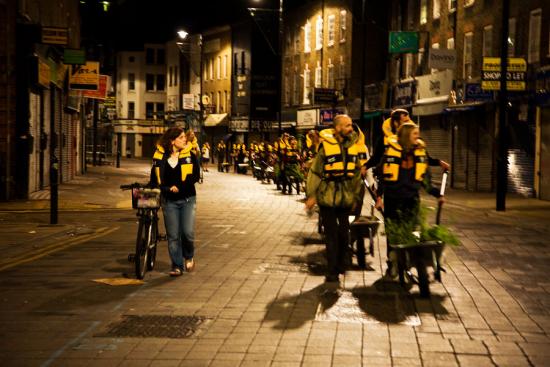
The ‘plan of action’ forms the basis of a new ideology, which acts as a counterpoint to neoliberalism – advocating our extrication from the system of capital that is the “ultimate cause” (Fisher 2009, p.70) of our environmental crisis. Heavy on words such as ‘abandon’, ‘reject’, ‘stand back’ and ‘disengage’ it calls us to make radical changes. It demands that we overcome our “path dependency” (Abbing 2002, p.96) by shifting our goals away from the fantasy status of the ‘successful’ artist. It all makes our new role seem far less glamorous than our dreams may have envisaged – insisting that we renounce our vanity, abandon our egos, move towards collectivism and anonymity; in short, commit “career suicide” (Sharp 2010, p.52).
But would it really be so beneficial to scrap everything and start again – to admit that our lives up until this point had been “lost causes” (Zizek 2009b)? The emphasis of this essay is on the possibility of reconciliation. Therefore, it aims to explore what positive characteristics of ‘the careerist mentality’ that has driven us to take this individualistic path, we might be able to “salvage” (Williams 2009) and, in doing so, reconfigure to become a positive force that can help us put the plan into action all the more effectively: to take the necessary risks and make a stand for the ‘right’ ethical choice.
Counter to Kant’s belief that the fields of ethical decision making (part of ‘practical reason’) and aesthetic decision making (part of ‘judgement’) be kept separate (Guyer 2004), it appears that the gravity of the situation we face means that these two spheres must begin to coincide. Indeed, in his final book Chaosmosis: An Ethico Aesthetic Paradigm, Felix Guattari argues for the culminating phase of art to be one in which it has an integral relationship with ethics (Guattari 2006). And so, the ethical implications of the ‘plan of action’ become difficult to ignore. Its focus on ‘tugging our attention away’ from our obsession with our own lives to reconnect with our “collective humanity” (Araeen 2009, p.679) is clearly a moral proposition, soliciting a shift from prudent self-interest towards more altruistic behaviour.
The conflict that emerges between the self-interest of ‘the careerist mentality’ and the apparently selfless altruism called for by several points of the ‘plan of action’ has long been the concern of moral philosophy. The recurring question being whether they can ever coexist or be reconciled. In her essay Altruism Versus Self-Interest: Sometimes a False Dichotomy, Neera Kapur Badhwar argues that in certain cases, where individuals display particular characteristics, reconciliation of these traditional polarities is possible (Badhwar 1993).
Badhwar’s essay is based on the analysis of extreme instances of altruism (in this case the behaviour of those who rescued / harboured Jews from the Nazis in the Second World War). What is interesting, and indeed relevant, is the way in which she demonstrates how these definitive acts of altruism are able to coexist with self-interested motivations. Her argument is based on an extension of the categories of self-interested motivation from “feeling virtuous, becoming famous, gaining wealth” (Badhwar 1993, p.101) – equate these to the artist’s extrinsic motivations “money, recognition, fame” (Abbing 2002, p.82) – to include “integrity and self-affirmation” (Badhwar 1993, p.101) – read the artist’s intrinsic motivations of “inner gratification or private satisfaction” (Abbing 2002, p.82). Even though she acknowledges that these altruistic acts were carried out with an “awareness of the risk, in the absence of expectations of material, social, or psychological rewards [and with] the spontaneity of their choice to help” (Badhwar 1993, p.96), she demonstrates that it was precisely because these individuals took the risk that they were able to satisfy the:
“fundamental human interest, the interest in shaping the world in light of one’s own values and affirming one’s identity.” (Badhwar 1993, p.107)
Furthermore, she unearths another peculiarity at the heart of the dichotomy of individualism / collectivism (Triandis 1995) which also becomes key to the possibility of reconciliation. The individuals that she studied were compelled to carry out these altruistic acts because they were able to perceive of themselves as part of the “collective humanity” (which Araeen demands we reconnect with) and so had a more developed capacity for empathy. But, moreover, that it was something inherent in their individualism that gave them the “confidence in the value of their mission, and their own capacities for carrying it out” (Badhwar 1993, p.100): to stand away from the crowd and to stand up for what they believed to be right.
Following Badhwar’s argument, it becomes possible to identify the first of the characteristics of ‘the careerist mentality’ we should aim to salvage. For it is our “flair, self-assurance, and… sense of audacity” (Abbing 2002, p.95) which we shall have to depend on in order to take the risk necessary to make a stand against the mainstream.
What might it look like if we took the risk? What might we end up with if we followed the points in the ‘plan of action’ to the word? It is possible that rather than resulting in a radical new type of art practice, what would actually take place is a shift away from art and into the field of activism.
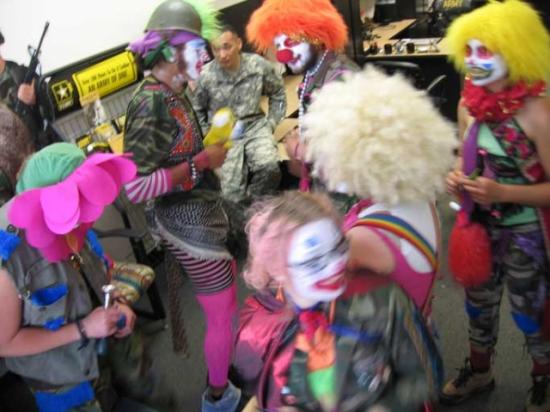
The Clandestine Insurgent Rebel Clown Army (CIRCA) was formed in 2003, to mark the official state visit of George W Bush to London at the onset of the Iraq war. It aimed to bring together “the ancient practice of clowning and the more recent practice of nonviolent direct action” (CIRCA 2003) – staging a series of strategic protests as part of an ongoing offensive against the evils of ‘war’ and ‘capitalism’. Before the protests at the G8 Summit at Gleneagles in 2005, the Rebel Clown Army embarked on a national recruitment tour of the United Kingdom. Anyone and everyone was invited to join, the only stipulation being that Basic Rebel Clown Training (BRCT) was first undertaken.
Much like the ‘plan of action’, the BRCT process focuses on the individual’s emancipation – on “transformation” and “personal liberation” from the dominant hegemony (CIRCA 2003). This internal reprogramming enables clownbatants, as they are known, to shut off their previous assumptions about hierarchical power structures and to step back and see the world with fresh eyes. From this new perspective the absurdity of a situation in which a line of protesters face-up against a line of police, becomes apparent. Beyond the signifiers of each others’ uniforms, Ranciere’s notion of the omnipresence of equality becomes evident (Ranciere 2007) and play and humour then perhaps do seem the natural human responses. Against the forward planning tactics of a traditional army (and indeed the career-minded artist) CIRCA’s emphasis is on spontaneity: “because the key to insurgency is brilliant improvisation, not perfect blueprints” (CIRCA 2003).
In a uniform which combines camo and greasepaint, clownbatants (as Point 5. suggests) ‘reject ego and embrace anonymity’ and so their inhibitions and embarrassment become irrelevant. So much more becomes possible without the worry of how they are perceived, of how others will judge them. Their individual subjectivities come together as a collective force of resistance. Their creativity exists in a space beyond the system of capital and they are utilising it to actively fight back.
The founders of the Rebel Clown Army were so aware of the importance of creativity in the process of resistance and of the potential for an evolution between art and activism, that they later set up the Laboratory of Insurrectionary Imagination (Lab of ii) as “a space to bring artists and activists together” (Harvie et al. 2005, p.249). The idea was to enable situations where they could work together and transfer skills – cultivating confidence in their “creative capacity as [a] fundamental tool for social change” (Lab of ii 2005). Functioning across the public realm, art world institutions and sites of traditional protest, the Lab of ii manages to successfully infiltrate and subvert different aspects of the hegemony. Most recently at Tate Modern in London, where under the banner of Disobedience Makes History – a two-day workshop on “art-activism” – they deliberately disobeyed the curator’s orders, encouraging participants to aim public attacks relating to the climate crises directly at the museum’s sponsors BP (Jordan 2010, p.35).
To read Part 4 of this article visit this link: http://www.furtherfield.org/articles/trajectories-how-reconcile-careerist-mentality-our-impending-doom-part-44
————
References:
Araeen, R., 2009. Ecoaesthetics: A Manifesto for the Twenty-First Century. Third Text, 23(5), 679-84.
Araeen, R. & Appignanesi, R., 2009. Art: A Vision of the Future. Third Text, 23(5), 499-502.
Badhwar, N.K., 1993. Altruism Versus Self-Interest: Sometimes a False Dichotomy. In Altruism. Cambridge: Cambridge University Press, pp. 90-117.
Bey, H., 1994. Immediatism, Oakland, California: AK Press.
Blackburn, S., 2009. Do we need a new morality for the 21st century? The Guardian Culture Podcast. Available at: www.guardian.co.uk/culture/audio/2009/nov/02/cambridge-festival-of-ideas.
CIRCA, 2003. About the Army. Clandestine Insurgent Rebel Clown Army website. Available at: www.clownarmy.org/about/about.html [Accessed April 25, 2010].
Curtis, A., 2002. The Century of the Self, BBC 4.
Crisp, Q., 1996. The Naked Civil Servant, London: Flamingo.
Fisher, M., 2006. Reflexive Impotence. k-punk blog. Available at: k-punk.abstractdynamics.org/archives/007656.html [Accessed April 25, 2010].
Fisher, M., 2009. Capitalist Realism: Is There No Alternative?, Ropley, Hampshire: 0 Books.
Guattari, F., 2006. Chaosmosis: An Ethico Aesthetic Paradigm. In Participation. London / Cambridge, Mass.: Whitechapel / MIT Press.
Guyer, P., 2004. Immanuel Kant. In E. Craig, ed. Routledge Encyclopedia of Philosophy. London: Routledge.
Hajek, A., 2008. Pascal’s Wager. The Stanford Encyclopedia of Philosophy. Available at: plato.stanford.edu/archives/fall2008/entries/pascal-wager [Accessed May 3, 2010].
Harvie, D. et al. eds., 2005. Shut Them Down!, Leeds / New York: Dissent! / Autonomedia.
Jordan, J., 2010. On refusing to pretend to do politics in a museum. Art Monthly, (334), 35.
Kingsnorth, P. & Hine, D., 2009. Uncivilisation: The Dark Mountain Manifesto. Available at: www.dark-mountain.net/about-2/the-manifesto.
Lab of ii, 2005. About Us. The Laboratory of Insurrectionary Imagination website. Available at: www.labofii.net/about [Accessed April 25, 2010].
Mouffe, C., 2007. Artistic Activism and Agonistic Spaces. Art & Research, 1(2). Available at: www.artandresearch.org.uk/v1n2/mouffe.html [Accessed April 25, 2010].
Ranciere, J., 2007. Hatred of Democracy, London: Verso.
Sharp, C., 2010. Career Suicide. Art Review, (40), 52-4.
The Invisible Committee, 2009. The Coming Insurrection, Los Angeles / Cambridge, Mass.: Semiotext(e).
Triandis, H., 1995. Individualism and Collectivism, Boulder, Colorado: Westview Press.
Vonnegut, K., 2003. Knowing What’s Nice. In These Times. Available at: www.inthesetimes.com/article/knowing_whats_nice [Accessed April 25, 2010].
Williams, E.C., 2009. Putting the punk back in salvage (where it was not to begin with). Socialism and/or Barbarism blog. Available at: socialismandorbarbarism.blogspot.com/2009/08/putting-punk-back-in-salvage-where-it.html [Accessed May 4, 2010].
Zizek, S., 2009a. First As Tragedy, Then As Farce, London: Verso.
Zizek, S., 2009b. In Defense of Lost Causes, London: Verso.
To read Part 1 of this article visit this link:
http://www.furtherfield.org/articles/trajectories-how-reconcile-careerist-mentality-our-impending-doom-part-14
To read Part 2 of this article visit this link: http://www.furtherfield.org/articles/trajectories-how-reconcile-careerist-mentality-our-impending-doom-part-24
To read Part 3 of this article visit this link: http://www.furtherfield.org/articles/trajectories-how-reconcile-careerist-mentality-our-impending-doom-part-34
Returning to Badhwar’s essay, it is important to note the impulsive and/or compulsive nature of the acts of altruism that she studied – “the spontaneity of their choice to help” (Badhwar 1993, p.96). She observes that:
“Those who acted spontaneously, then, acted with a sense that they had no alternative but to help, and that, under the circumstances, helping was nothing special… [Their actions were] a spontaneous manifestation of “deep-seated dispositions which form one’s central identity” or character.” (Badhwar 1993, p.97)
Of course, impulsion and / or compulsion are not the sorts of qualities which can be taught or learnt. As is suggested, you really have to believe in what you are doing in order to act instinctively – in a way which is not premeditated or over-deterministic. In this sense you cannot simply follow a ‘plan’ to be altruistic as this is in its essence self-defeating. It is, however, possible to develop one’s “character” or “identity”, so that we do begin to notice when things are wrong or unjust and we really do feel compelled to act to change them. This is done through periods of self-reflection but also, more importantly, by acquiring knowledge.
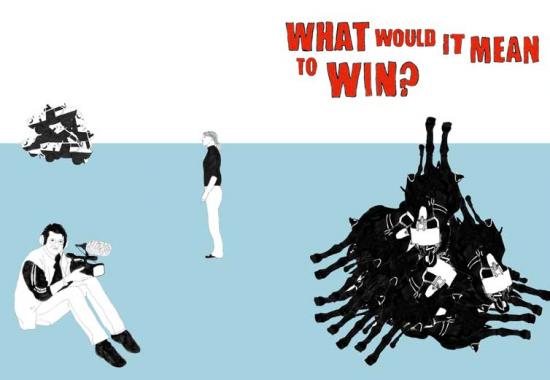
Oliver Ressler uses his research-based practice as a way of not only acquiring knowledge for himself, but of disseminating it to others – via video, installation and public realm contexts. His 2008 film What Would It Mean To Win? in collaboration with Zanny Begg focuses on the counter-globalisation protests at the G8 Summit in Heiligendamm in Germany in 2007. The documentary sections of which probe members of resistance movements to consider just what form society might take if they were to ‘win’ what they have been fighting for. His creation of a bank of knowledge about social alternatives is extended in Alternative Economics, Alternative Societies – a documentary, installation and billboard project which presents ideas and proposals for alternative economic and societal models, which all use the rejection of the system of capital as a starting point (Ressler 2007). The research from this project was published as a book in 2007.
Ressler’s book can be seen as a companion to that of art collective Superflex who in 2006 initiated and published Self-organisation / Counter-economic Strategies. As a “toolbox of ideas”, the book puts forward a series of proposals for self-organised models of social and economic systems that also aim to offer an alternative to capitalism (Bradley et al. 2006). Both books aim to spark debate about the negative effects of our current social order and (as Point 2. suggests) ‘to revivify the belief that ‘an alternative’ is possible’.
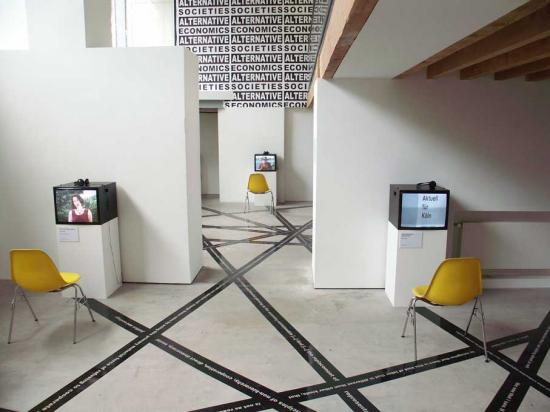
What is interesting is that the more we learn about the connections between capitalism and environmental catastrophe – the more self-reflection we undertake – the more ‘responsibility’ we inherit. In his famous essay exploring the moral differences between active and passive action Killing and Starving to Death, James Rachels illuminates this notion:
“There is a curious sense, then, in which moral reflection can transform decent people into indecent ones: for if a person thinks things through and realises that he is, morally speaking [in the wrong]… his continued indifference is more blameworthy than before.” (Rachels 2006, p.73)
And so the self-reflexive artist enters into a spiral. The more knowledge that they research and acquire – the more their conscience is likely to compel them to act. The question then becomes whether art is the most efficient way of effecting real change.
According to Artur Zmijewski, his recent work Democracies – a series of documentary clips depicting different protest movements from around the world – is not art. “Art”, according to Zmijewski, “is too weak to present political demand” (Prince 2009, p.6). Artists have in the past reached a similar conclusion – turning to existing political systems as a more direct means of effecting change. In 1980 Joseph Beuys was instrumental in setting up the Green Party in Germany, running as its candidate for the European Parliament, and, in 1988 Maria Thereza Alves co-founded the Green Party in Brazil. In a recent lecture Alves points out that it becomes the role of the artist to “judge in each situation whether art or politics provides a better solution” (Alves 2010).

As well as proposing theoretical solutions in book form, Superflex have also attempted to find practical solutions to real life problems in Africa. Although falling under the umbrella of their artistic practice, these projects seem more akin to the sort of thing you might expect to see being pioneered by a charity or a development agency. In 1996-7 they worked with engineers to develop the Supergas system, which is capable of turning compostable waste in the form of human / animal dung into “sufficient gas for the cooking and lighting needs of an African family”, thereby allowing them to “achieve self-sufficiency in energy” (Superflex 1997). The realisation of the Supergas system seems to epitomise the marriage between creative thinking and functionality which Araeen calls for by presenting the example of the desalination plant. What is interesting about this project, and indeed Beuys’ and Alves’ involvement in Green politics, is how it shifts our perception of the role of the artist when viewed as an important component part of a wider practice…
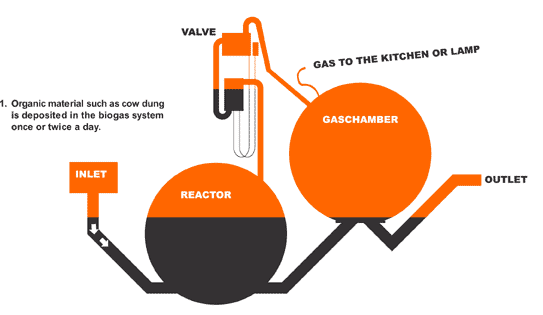
It has been suggested that the most successful campaigning bodies, such as Greenpeace, function “through multi-pronged channels of official, semi-official and illicit activity to negotiate specific ends” (Perry 2010, p.8). They operate under several different ‘hats’ – as a registered charity for raising funds (sometimes even stooping so low as to employ the cynical marketing strategies of the ‘charity-mugger’ on the street) and, at once, as a band of renegade activists aboard the Rainbow Warrior causing real disruption to cruel and exploitative practices and playing tactical media games. They demonstrate a “positive disengagement” (Fisher 2006) from the mainstream, coupled with a savvy co-option of the system, where it clearly presents itself as a more productive solution.
It is possible that the new model for a ‘reconciled artistic practice’ could take a similar form, where the artist (or preferably the collective of artists) balances a variety of activities across different fields. Described as “a group of freelance artist-designer-activists committed to social and economic change” (Myers 2007), Superflex do not ‘abandon’ the art world altogether and, in addition to the projects described above, they continue to work on commissions for its major institutions. For example, in 2009 they made a series of short films The Financial Crisis (Session I-V) for the art market’s number one annual trade fair – Frieze. Like the Lab of ii and following in a long lineage of institutional critique, Superflex appear to understand the benefits of being able to use the system by infiltrating it, criticising and beginning to change it from within.
In now seems evident that our success at adapting to this multi-pronged mode of operation, which straddles real political action, activism and art world insider jobs, depends on our flexibility in approaching different tasks – our ability to wear these different ‘hats’ with conviction and our adeptness at switching between roles. So here it becomes possible to identify the second of the characteristics of neoliberalism which we might aim to salvage. For it is “the very hallmarks of management in a post-Fordist, Control society” – our ‘flexibility’, ‘nomadism’ and ‘spontaneity'” (Fisher 2009, p.28) which we must now begin utilise, as well as our ability to cope with and adapt to change. Both very useful skills to have as the temperatures begin to rise and the food stocks begin to run low.

The final characteristic particular to the career-minded artist, which we must aim to reconfigure as central to our new roles in the twenty-first century, is our work-ethic, which results from our comparatively high levels of intrinsic motivation (Abbing 2002, p.82). The acceleration of work rates is something which has developed across the board under neoliberalism to the extent that we are now “bound” to our work in an “anxious embrace”…
“Managers, scientists, lobbyists, researchers, programmers, developers, consultants and engineers, literally never stop working. Even their sex lives serve to augment productivity.” (The Invisible Committee 2009, p.47)
However, it is the artist’s ability and willingness to work twenty-four-seven often in situations completely removed from wage-labour relations, that makes us ‘exceptional’ (Abbing 2002) and offers the potential, even, to act as a paradigm for a general approach to work in a world beyond capital. For it is this position of “radical autonomy” which presents the opportunity for “real education of our socialised senses and human potentials that releases development in all directions” (Ray 2009, p.546). We continue, over the course of our lives, to relentlessly acquire knowledge, self-reflect and develop, adapt, evolve and act – not for money, but because something inside us – something inherent in our ‘character’ – compels us to. If we could only succeed in “freeing” a small fraction of this exceptional motivation “from the self-destructive narcissist ego” (Araeen 2009, p.683) and releasing it in a more selfless and functional direction, it could still be a hugely positive force for change.
Following Aristotle’s classic assertion that moral excellence is found in a person’s rational capacity to choose the mean between extremes (Mautner 2005, p.43), the introduction to the Cambridge reader on Altruism, in which Badhwar’s essay is published, suggests that:
“The most challenging task of a moral theory is to strike a balance between the weight we give to our own interest and the weight we give to those of others. A theory that directs us to give too much to others is as deficient as one that directs us to give too little.” (Paul et al. 1993, p.ix)
And, so it seems that ‘a reconciled practice’ will also, to a certain extent, be about compromise. It will be about attempting to ‘strike a balance’ between the time we invest in each of the various facets of our activity – direct political action or more conventional art world activity – and about how we best use our judgement as to when to focus on one thing over another. If we can achieve this equilibrium in our ‘multi-pronged approach’ to practice, and indeed in our lives in general, then this is perhaps also where we will find our “private satisfaction” (Abbing 2002, p.82): our happiness.
In a recent interview Ranciere reminds us “that there are certain situations where only reality can be taken into account – there is no room for fiction” (Charlesworth 2010, p.75). What this suggests is that perhaps the balance between the ‘selfish’ and ‘selfless’ activity which artists undertake will only really begin to shift when we are directly confronted with the realities of climate change. As James Lovelock suggests it may well take until the point of real global disaster – such as an event on the scale of the Pine Island glacier breaking off into the ocean causing tsunamis and an immediate and permanent sea rise of two metres (Hickman 2010, p.12) – until we are, through absolute necessity, able to totally reconfigure our motivations. Perhaps only when we do come face-to-face with this “worst kind of encounter with reality” (Kingsnorth & Hine 2009, p.11) will we, as artists, be able to assume our fully functional role in society.
When Franny Armstrong, founder of the 10:10 Campaign, says “if you’re not fighting climate change or improving the world, then you’re wasting your life” (Armstrong 2009a, p.8), she is essentially reinforcing the ‘wager’ set out in our ‘plan of action’. However the future pans out, do you really want to look back on this pivotal moment in the history of our species and say ‘I did nothing’, ‘I did not make a stand’, or do you want to be able to say the opposite and to retain what should be our most commanding of all human motivations – our integrity.
——-
Abbing, H., 2002. Why Are Artists Poor?: The Exceptional Economy of the Arts, Amsterdam: Amsterdam University Press.
Alves, M.T., 2010. The Friday Event. The Glasgow School of Art. Available at: www.gsaevents.com/fridayevent/alves [Accessed April 25, 2010].
Araeen, R., 2009. Ecoaesthetics: A Manifesto for the Twenty-First Century. Third Text, 23(5), 679-84.
Araeen, R. & Appignanesi, R., 2009. Art: A Vision of the Future. Third Text, 23(5), 499-502.
Armstrong, F., 2009a. Franny Armstrong: If you’re not fighting climate change or improving the world, then you’re wasting your life. The Guardian, 8.
Armstrong, F., 2009b. What is 10:10? 10:10 Campaign website. Available at: www.1010uk.org/1010/what_is_1010/arms [Accessed April 10, 2010].
AVOID, 2010. Will the Copenhagen Accord avoid more than 2C of global warming? AVOID website. Available at: ensembles-eu.metoffice.com/avoid [Accessed May 3, 2010].
Badhwar, N.K., 1993. Altruism Versus Self-Interest: Sometimes a False Dichotomy. In Altruism. Cambridge: Cambridge University Press, pp. 90-117.
Bey, H., 1994. Immediatism, Oakland, California: AK Press.
Blackburn, S., 2009. Do we need a new morality for the 21st century? The Guardian Culture Podcast. Available at: www.guardian.co.uk/culture/audio/2009/nov/02/cambridge-festival-of-ideas.
Bradley, W. et al. eds., 2006. Self-organisation / Counter-economic Strategies, New York: Sternberg Press.
Brown, W., 2009. What will be the legacy of recession? The Guardian Culture Podcast. Available at: www.guardian.co.uk/culture/audio/2009/oct/26/culture-cambridge-festival-ideas.
Cameron, D., 2009. The Age of Austerity. The Conservative Party website. Available at: www.conservatives.com/News/Speeches/2009/04/The_age_of_austerity_speech_to_the_
2009_Spring_Forum.aspx [Accessed April 25, 2010].
Charlesworth, J.J., 2010. Jacques Rancière Interview. Art Review, (40), 72-5.
CIRCA, 2003. About the Army. Clandestine Insurgent Rebel Clown Army website. Available at: www.clownarmy.org/about/about.html [Accessed April 25, 2010].
Crisp, Q., 1996. The Naked Civil Servant, London: Flamingo.
Curtis, A., 2002. The Century of the Self, BBC 4.
Deleuze, G., 1990. Society of Control. L’Autre Journal, (1). Available at: www.nadir.org/nadir/archiv/netzkritik/societyofcontrol.html.
Fisher, M., 2009. Capitalist Realism: Is There No Alternative?, Ropley, Hampshire: 0 Books.
Fisher, M., 2006. Reflexive Impotence. k-punk blog. Available at: k-punk.abstractdynamics.org/archives/007656.html [Accessed April 25, 2010].
Fowkes, M. & Fowkes, R., 2009. Planetary Forecast: The Roots of Sustainability in the Radical Art of the 1970s. Third Text, 23(5), 669-674.
Guattari, F., 2006. Chaosmosis: An Ethico Aesthetic Paradigm. In Participation. London / Cambridge, Mass.: Whitechapel / MIT Press.
Guyer, P., 2004. Immanuel Kant. In E. Craig, ed. Routledge Encyclopedia of Philosophy. London: Routledge.
Hajek, A., 2008. Pascal’s Wager. The Stanford Encyclopedia of Philosophy. Available at: plato.stanford.edu/archives/fall2008/entries/pascal-wager [Accessed May 3, 2010].
Harvey, D., 2007. A Brief History of Neoliberalism, Oxford: Oxford University Press.
Harvie, D. et al. eds., 2005. Shut Them Down!, Leeds / New York: Dissent! / Autonomedia.
Hickman, L., 2010. James Lovelock: Fudging data is a sin against science. The Guardian, 10-12.
Hillcoat, J., 2009. The Road, Dimension Films.
IPCC, 2001. Special Report on Emissions Scenarios. GRID-Arendal website. Available at: www.grida.no/publications/other/ipcc%5Fsr/?src=/climate/ipcc/emission [Accessed May 3, 2010].
Jordan, J., 2010. On refusing to pretend to do politics in a museum. Art Monthly, (334), 35.
Kerr, A., 2010. Goldsmiths: But is it Art?, BBC 4.
Kingsnorth, P. & Hine, D., 2009. Uncivilisation: The Dark Mountain Manifesto. Available at: www.dark-mountain.net/about-2/the-manifesto.
Lab of ii, 2005. About Us. The Laboratory of Insurrectionary Imagination website. Available at: www.labofii.net/about [Accessed April 25, 2010].
Mamudi, S., 2008. Lehman folds with record $613 billion debt. MarketWatch website. Available at: www.marketwatch.com/story/lehman-folds-with-record-613-billion-debt?siteid=rss [Accessed April 25, 2010].
Mautner, T., 2005. Aristotle. In The Penguin Dictionary of Philosophy. London / New York: Penguin, pp. 40-4.
Mouffe, C., 2007. Artistic Activism and Agonistic Spaces. Art & Research, 1(2). Available at: www.artandresearch.org.uk/v1n2/mouffe.html [Accessed April 25, 2010].
Myers, J., 2007. Superflex. Frieze Magazine, (106). Available at: www.frieze.com/issue/review/superflex [Accessed May 9, 2010].
Paul, E.F., Miller, F.D. & Paul, J. eds., 1993. Altruism, Cambridge: Cambridge University Press.
Perry, C., 2010. Art v the Law. Art Monthly, (333), 5-8.
Priddle, A., 2009. School of Saatchi, BBC 2.
Prince, M., 2009. Art & Politics. Art Monthly, (330), 5-8.
Prince, M., 2010. Remakes. Art Monthly, (335), 9-12.
Rachels, J., 2006. Killing and Starving to Death. In The Legacy of Socrates: Essays in Moral Philosophy. New York: Columbia University Press, pp. 60-82.
Ranciere, J., 2007. Hatred of Democracy, London: Verso.
Ray, G., 2009. Antinomies of Autonomism: On Art, Instrumentality and Radical Struggle. Third Text, 23(5), 537-46.
Ressler, O., 2007. Alternative Economics, Alternative Societies. Oliver Ressler website. Available at: www.ressler.at/alternative_economics [Accessed April 25, 2010].
Sharp, C., 2010. Career Suicide. Art Review, (40), 52-4.
Strawson, P.F., 2008. Social Morality and Individual Ideal. In Freedom and Resentment and Other Essays. London / New York: Routledge, pp. 29-49.
Superflex, 1997. Supergas. Superflex website. Available at: superflex.net/tools/supergas [Accessed May 5, 2010].
Thatcher, J., 2009. Crunch Time. Art Monthly, (332), 5-8.
Thatcher, M., Margaret Thatcher Quotes. About.com website. Available at: womenshistory.about.com/od/quotes/a/m_thatcher.htm [Accessed May 2, 2010].
The Invisible Committee, 2009. The Coming Insurrection, Los Angeles / Cambridge, Mass.: Semiotext(e).
Triandis, H., 1995. Individualism and Collectivism, Boulder, Colorado: Westview Press.
Vonnegut, K., 2003. Knowing What’s Nice. In These Times. Available at: www.inthesetimes.com/article/knowing_whats_nice [Accessed April 25, 2010].
Walker, J., 2002. Left Shift: Radical Art in 1970s Britain, London / New York: I.B. Tauris.
Williams, E.C., 2009. Putting the punk back in salvage (where it was not to begin with). Socialism and/or Barbarism blog. Available at: socialismandorbarbarism.blogspot.com/2009/08/putting-punk-back-in-salvage-where-it.html [Accessed May 4, 2010].
Zizek, S., 2009a. First As Tragedy, Then As Farce, London: Verso.
Zizek, S., 2009b. In Defense of Lost Causes, London: Verso.
Jaron Lanier
You Are Not A Gadget
2010
Allen Lane
ISBN 1846143411
Jaron Lanier’s book “You Are Not A Gadget” is a timely polemic, a cry of the soul in an increasingly soulless Web 2.0 world. I found reading it a frustrating and inspiring experience. For every time I wanted to throw the book at the wall in exasperation there was a time where Lanier spoke to a part of me that the cultural transition from 90s cyberpunk to 2010s cyberpreppy had optimised out.
Lanier is asking the right questions. What happens to our conception of what it means to be human when the way we represent our humanity is reduced to snippets of media on (micro-)blogs and social networking sites? How can we support a middle class of independent artists when the technology and economics of the Internet makes money directly only for the vectorialist media barons of Web 2.0? Will the technologically enabled troll class become a political threat akin to historical fascism?
These are questions that need asking, and Lanier asks them in an intelligent and open way. This is all the more impressive given his background as a champion of cyberculture. Lanier is not fearful or dismissive of the changes that the technology he championed has wrought. He is looking them in the eye and challenging their new proponents to explain the gap between their claims and their reality.
The problem is that Lanier’s answers crash and burn from a lack of detailed knowledge of non-cyber culture. He contrasts the managerialism and capitalism that he mis-identifies as materialism with a naive and easily exploited mystificatory spirituality. He accepts unquestioningly the music recording industry’s claim that the Internet has destroyed the economic and cultural value of music. And his characterisation of commons-based peer production as digital Maoism is wide of the mark.
To address just one of his examples; the cultural smog of the contemporary Internet follows the exhaustion of mass culture, it has not produced it. Napster is not to blame for the X Factor. The Beatles, generally regarded as a cultural highpoint of mass culture, were a reactionary throwback to earlier rock and roll tropes and were identified as such by Cliff Richard at the time. The well of mid-20th century black American music was returned to in the 1960s, 1970s 1980s and 1990s and was dry by the era of the parochial third-order nostalgia of Britpop. Crucially, Britpop pre-dates Napster and mass adoption of the MP3 file format. Lanier’s adopted narrative doesn’t add up.
But I come to praise Lanier, not to bury him in data. His is an ambitious critique, an important challenge to deeply ingrained cybercultural beliefs. We should all be so brave as to face the consequences of what we believe in so directly. And his final conclusions, not those of a disappointed cyber-hippy who should have been careful what he wished for but of someone who has kept faith in the potential of technology for us to realise ourselves, are as inspirational as they are accusatory.
You can google any number of blow-by-blow disagreements with Lanier’s thesis. And his own FAQ on the book is in many ways more convincing than the book itself. But if you have any interest in contemporary culture as it is mediated by technology you owe it to yourself to find your own points of difference and agreement with Lanier and to look beyond that to the spirit of what he is saying.
Which is that we should not be reifying and reducing our selves and our experiences into packets of data that the social robber barons of Web 2.0 can sell to marketing companies and government agencies. We should be using virtual reality and the other affordances of information technology to expand our consciousness and to grow as socialised individuals.
Web 2.0 can be oppressively straight and conformist. It doesn’t have to be like this. Don’t dismiss Lanier’s ambition to create a virtual reality system that could let him experience being an octopus. Wonder what it would be like to try it yourself, and how you would explain it to your friends.
Not the entries on your Facebook Friends list, your actual friends…
The text of this review is licenced under the Creative Commons BY-SA 3.0 Licence.
Article by Rosa Menkman
Based on an interview with the Critical Glitch Artware Category organizers and contenders of Blockparty and Notacon 2010: jonCates, James Connolly, Eric Oja Pellegrino, Jon.Satrom, Nick Briz, Jake Elliott, Mark Beasley, Tamas kemenczy and Melissa Barron.
From April 15-18th, the Critical Glitch Artware Category (CGAC) celebrated its fourth edition within the Blockparty demoparty and this time also as part of the art and technology conference Notacon.
The program of the CGAC consisted of a screening curated by Nick Briz, performances by Jon Satrom, James Connolly & Eric Pellegrino, and DJ sets by the BAD NEW FUTURE CREW. There were also a couple of artist presentations and the official presentation of a selection of the (115!) winners within the Blockparty official prize ceremony.
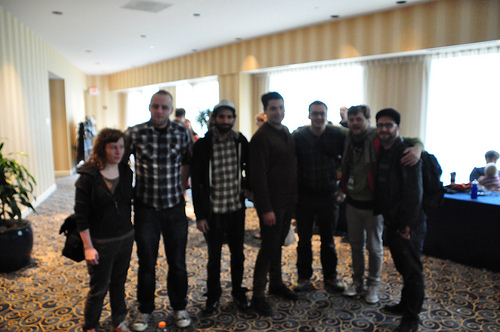
The fact that CGAC was coupled with a demoscene event is somewhat extraordinary. It is true that both the demoscene and CGAC or ‘glitchscene(s)’ focus on pushing boundaries of hardware and software, but that said, I (as an occasional contender within both scenes) could not think about two more parallel, yet conflicting worlds. The demoscene could be described as a ‘polymere’ culture (solid, low entropic and unmixable), whereas CGAC is more like an highly entropic gas-culture, moving fast and chaotically changing from form to form. When the two come together, it is like a cultural representation of a chemical emulsion; due to their different configuration-entropy, they just won’t (easily) mix.
But all substances are affected (oxidized) by the hands of time; there is always (a minimal) consequence at the margin. And this was not the first time these two cultures were exposed to each other either; Criticalartware had been present at Blockparty since 2007. Moreover, a culture can of course not be as strictly delineated as a chemical compound; it was thus clear that this year the two were reacting to each other.
While over the last couple of years the demoscene has been described in books, articles and thesis’, this particular kind of ‘fringe provocation’ is not what these researchers seem to focus on; they (exceptions apart) concentrate on the exclusivity of the scene and its basic or specific characteristics. The ‘assembly’ of these two cultures during Blockparty could therefore not only serve as a very special testing moment, but also widen and (re)contextualize the scope of the normally independent researches of these cultures. So what happened when the compounds of the chemicals were ‘mixed’ and what new insights do we get from this challenging alliance (if there is such a thing)?
The demoscene is often described as a bounded, delimitated and relatively conservative culture. Its artifacts are dispersed within well-defined, rarely challenged categories (for the contenders, there is the ‘wild card’ category). Moreover, the scene is a meritocracy – while the contenders (that refer to themselves with handles or pseudonyms) within the scene have roles and work in groups, the elite is ‘chosen’ by its aptitude.
The demoscene also serves a very specific aesthetics, as enumerated by Antti Silvast and Markku Reunanen this week on Rhizome (synced music and visuals, scrolling texts, 3d objects reflections, shiny materials, effects that move towards the viewer – tunnels and zooming – overlays of images and text, photo realistic drawing and adoption of popular culture are the norm). In the same article Silvast and Reunanen declare that: ‘Interestingly, even though we’re talking about technologically proficient young people, the demosceners are not among the first adopters of new platforms, as illustrated by numerous heated diskmag and online discussions. At first there is usually strong opposition against new platforms. One of the most popular arguments is that better computers make it too easy for anybody to create audiovisually impressive productions. Despite the first reactions, the demoscene eventually follows the mainstream of computing and adopts its ways after a transitional period of years.'[1]
More about this can be read at Rhizome’s week long coverage of the demoscene. Silvast and Reunanen’s statement might be most interesting when we move along to see what happened during the meeting of the two scenes.
Co-founded by jonCates, Blithe Riley, Jon Satrom, Ben Syverson and Christian Ryan in 2002, Criticalartware is a radically inclusive group that started as a media art history research and development lab. Since 2002 the group has shifted and transitioned. Criticalartware’s formation was deeply influenced by the Radical Software platform (publications and projects). Since then it has been an open platform for critical thinking about the use of technology in various cultures. Criticalartware applies media art histories to current technologies via Dirty New Media or digitalPunk approaches. Through tactics of interleaving and hyper threading it permeates into cultural categories of Software Studies, Glitch Art, Noise and New Media Art.
During the first phase of Criticalartware (from 2002 – 2007), the group was a collaborative of artist-programmers/hackers. It also functioned as a media art histories research and development lab. In this form, Criticalartware had become an internationally recognized and reviewed project and platform.
When this phase ended in 2007, jonCates, Tamas Kemenczy and Jake Elliott were the remaining active members of Criticalartware. During this time, Elliott and Kemenczy wanted to take the project in a new direction; into the demoscene. This direction has ultimately defined the second phase of Criticalartware; an artware demo crew, making work for and appearing annually at the Blockparty event and Notacon conference in Cleveland.
2010 marked the next important transition for the Criticalartware crew, when it started using the phrase ‘Critical Glitch Artware’- Category. Criticalartware now not only organizes itself around the demoscene but also around the concept of the glitch. While a glitch (not to be confused with glitch art) appears as an accident or the result of misencoding between different actors, CA’s Glitch-art category exploits this possibility in an metaphorical way. Criticalartware is now foregrounding these glitch art works (with an emphasis on the procedural/software works) that have been on a ‘pivotal axis’ of the crew for a long time.
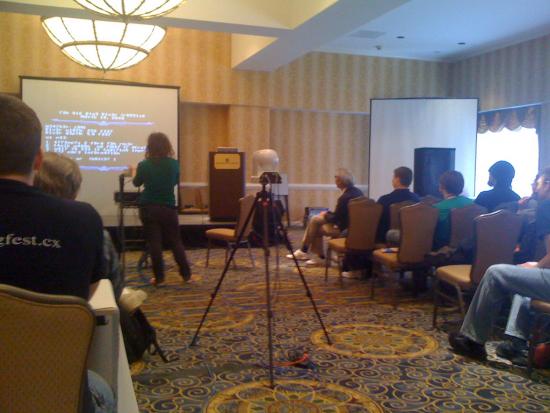
CGA, just like the demoscene, can be described as an open (plat)form for artistic activity/culture/way of life/counter culture/multimedia hacker culture and (unfortunately a bit of ) a gendered community. CA are about pointing out ideas or concepts within popular culture and incorporating (standardizing) these as machines or programs in a reflexive and critical self-aware manner.
CA can also be described as an investigating of standard structures and systems. They are often amongst early adopters of technology, in which they (politically) challenge and subvert categories, genres, interfaces and expectations. But the CGA – artists do not feel stuck in a particular technology, which makes it aesthetically, at least at first sight hard to pinpoint a common denominator.
There is not a real organization within this scene. The artists and theorists are scattered over the world, connected in fluid/loosely tied networks dispersed over many different platforms (Flickr, Vimeo, Yahoo groups, Youtube, NING, Blogger and Delicious).
Because of its bounded, intricate conservative qualities, the demoscene has been an easy target for outsiders to play ‘popular’ ironic pranks on, to misunderstand or misrepresent. A growing interest for the demoscene by outsiders has compelled jonCates and the Criticalartware crew to articulate their position towards the demoscene more extensively. In an interview with me, jonCates articulates Criticalartware’s points and contrasts these with problematic representations of the demoscene within two works by the BEIGE Collective (that in 2002 existed along side the Criticalartware crew in Chicago).
When the BEIGE collective went to the HOPE (Hackers on Planet Earth) Conference in 2002 they made a project called: TEMP IS #173083.844NUTS ON YOUR NECK or Hacker Fashion: A Photo Essay by Paul B.Davis + Cory Arcangel.
jonCates writes to me that ‘this problematic project characterizes or epitomizes a kind of artists as interlopers positionality that i + Criticalartware as a crew has always attempted to complicate. we do not want or understand ourselves as seeking out an ironic or sarcastically oppositional position in relation to the contexts that we choose to work in. we have not set out to ridicule the demoscene or otherwise make ridiculous our relations to the demoscene. in contrast, we set out to operate within a specific demoscene through multi-valiant forms of criticality, playfullness, enthusiasm, respect, interest, admiration, etc… this has also been in efforts to connect this specific demoscene to our experimental Noise & New Media Art scenes or what you Rosa referred to earlier as glitchscene…’
Another point of contention for jonCates is the Low Level All-Stars project by BEIGE (in this case, Cory Arcangel) + Radical Software Group (Alexander R. Galloway). this work is described as ‘Video Graffiti from the Commodore 64 Computer’ (2003) by Electronic Arts Intermix who sells/distributes this work as a video in the context of Video Art.
Low Level All-Stars has been shown at Deitch Projects in NYC in 2005 and circulated in the contemporary art world. jonCates writes to me saying the work seeks ‘to isolate + thereby establish cultural values for this ‘quasi-anthropological’ view of demos as found object + functioning as a tasteful ‘testament to a lost subculture.’ It is now being offered online as an educational purchase for $35 dollars.
However, as jonCates and Criticalartware work in the demoscene demonstrates, the demoscene subculture is not lost, nor over. jonCates moves on by writing that ‘the demoscene is a vibrant whirld wit a dynamic set of pasts + presents. this is another of which many (art) whirlds are possible. we seek to make those whirlds known to each others + ourselves out of respect, curiosity, investment, inclusiveness, criticality, playfullness, etc…’
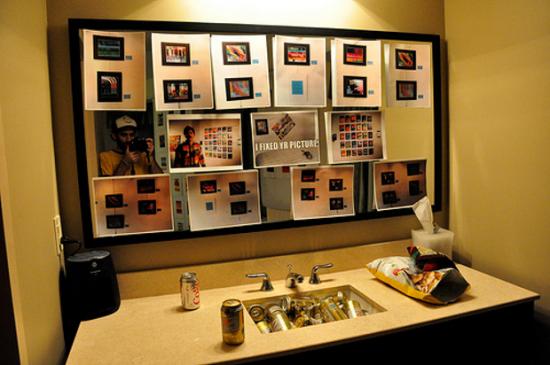
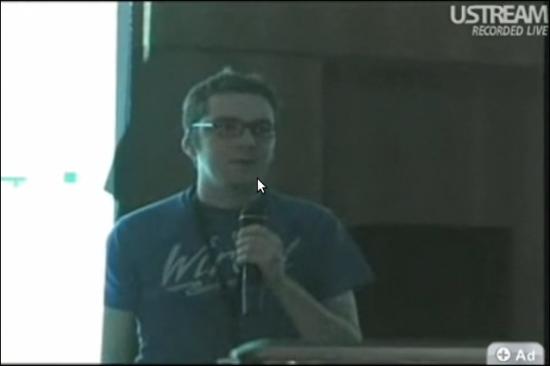
The Criticalartware crew has been taking part in Blockparty since 2007, when it won the last place in a demo competition and was disqualified. One year later, in 2008, through a number of efforts (including Jake Elliott’s presentation Dirty New Media: Art, Activism and Computer Counter Cultures at HOPE, the Hackers on Planet Earth conference in NYC in 2008). CA was able to mobilize and manifest the concept of the Artware category at Blockparty, a category which Blockparty itself retroactively recognized CA for winning.
In the same year (2009) CA organized a talk at Blockparty in which they revealed the “secret source codes” of the tool they used to develop the winning artware of the year before.
By 2010 CA wanted to expand the concept of Artware within the demoscene, which lead to the development of the ‘Critical Glitch Artware Category’ event. Within the CGAC Compo there where 115 subcategory winners, which showed some kind of glitch-critique towards systematic categorization of Artware. Jason Scott (the organizer of Blockparty) personally invited CGAC to pick 3 winners and present their wares at the official Blockparty prize ceremony. Besides these three winners, CGACs efforts got extra credits when Jon Satrom’s Velocanim_RBW also won the Wild card category compo.
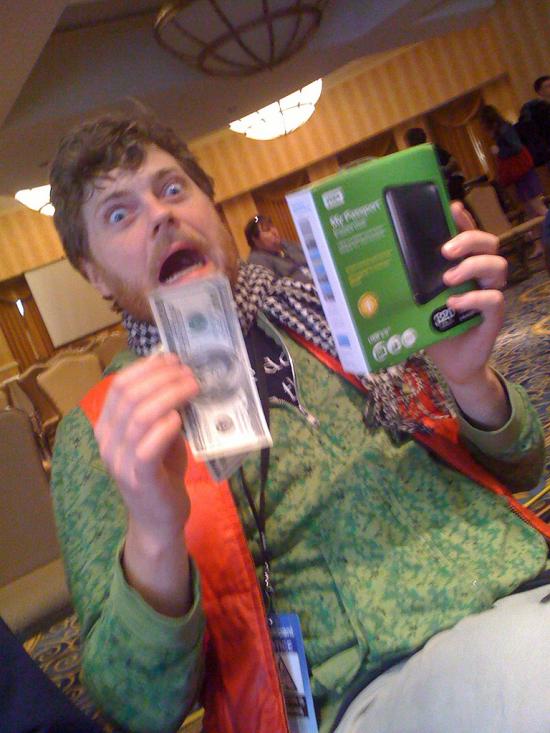
Therefore, not only did CA intentionally open up the Blockparty event to outsiders of the demoscene, it also provided a place for new media art and the glitchscene within the demoscene and got Blockparty to accept and invite the CA within their program. Thus, the outsiders (CA) moved towards the inside of the event, while the insiders got introduced to what happens outside of the demoscene (event), which led to conversations and insights into for instance bug collecting, curating and coding.
The Critical Glitch Artware Category has been accepted by, at least, the fringe of Blockparty 2010. Even though the category itself is not (yet) visible on the website, Satrom’s winning work Velocanim_RBW is. Moreover, CGAC was part of the official prize ceremony, streamed live on Ustream, the live Blockparty internet television stream. So how does CGAC redefine or reorganize the fringe between them and the demoscene and how does the demoscene redefine and reorganize the structure of CGAC?
For now, I think crystallized research into the aesthetics of the demoscene can also help describe the aesthetics within CGAC. Custom elements like rasters, grids, blocks, points, vectors, discoloration, fragmentation (or linearity), complexity and interlacing are all visually aesthetic results of formal file structures. However, the aesthetics of CGA do not limit themselves, nor should they be demarcated by just these formal characteristics of the exploited media technology.
Reading more about the demoscene aesthetics, I ran into a text written by Viznut, a theorist within the demoscene (who also wrote about ‘thinking outside of the box within the demoscene’). He separates two aesthetic practices within the scene: optimalism (an ‘oldschool’ attitude) which aims at pushing the boundaries in order to fit in ‘as much beauty as possible’ in as little code necessary, and reductivism (or ‘newschool’ attitude), which “idealizes the low complexity itself as a source of beauty.'[2]
He writes that “The reductivist approach does not lead to a similar pushing of boundaries as optimalism, and in many cases, strict boundaries aren’t even introduced. Regardless, a kind of pushing is possible — by exploring ever-simpler structures and their expressive power — but most reductivists don’t seem to be interested in this aspect”.
A slightly similar construction could be used for aesthetics within Glitch Art. Within the realm of glitch art we can separate works that (similar to optimalism) aim at pushing boundaries (not in terms of minimal quantity of code, but as a subversive, political way, or what I call Critical Media Aesthetics; aesthetics that criticize and bring the medium in a critical state) and minimalism (glitch works that just focus on the -low- complexity itself – that use supervisual aesthetics as a source of beauty). The latter approach seems to end in designed imperfections and the (popularized) use of glitch as a commodity or filter.[3]
Of course these two oppositions exist in reality on a more sliding scale. Debatebly and over simplified I would like to propose this scale as the Jodi – Mille Plateaux (old version) – Beflix – Alva Noto – Glitch Mob – Kanye West/Americas Next Top Model Credits continuum; A continuum that moves from procedural/conceptual glitch art following a critical media aesthetics to the aesthetics of designed or filter based imperfections.
This kind of continuum forces us to ask questions about the relationships between various formalisms, conceptual process-based approaches, dematerializations and materialist approaches, Software Studies, Glitch Studies and Criticalartware, that could also be of interest or help to future research into the demoscene. When I ask jonCates what other questions CGAC brings to the surface, he answers:
“when i asked Satrom to participate in the CRITICAL GLITCH ARTWARE CATEGORY event + explained the concept that Jake + i had developed to him he was immediately interested in talking about it as form of hacking a hacker conference, by creating a backdoor into the conference/demoscene/party/event. im also excited about this way of discussion the event + our reasonings + intentions, but i want to underscore that this effort is also undertaken out of respect for everyone involved, those from the demoscene, glitchscenes, hackers, computer enthusiasts, experimental New Media Artists, archivists, those who are working to preserve computer culture, Noise Artists + Musicians, etc… so while this may be a kind cultural hack/crack it is not done maliciously. we are playful in our approach (i.e. the pranksterism that Nick refers) but we are not merely court jesters in the kingdom of BLOCKPARTY. we have now, as of 2010, achieved complete integration into the event without ever asking for permission. perhaps that is digitalPunk. + mayhaps that is a reason for making so many categories +/or so many WINNERS! 🙂
…also, opening the category as we did (with a call for works [although under a very short deadline], an invitational in the form of spam-styled personal/New Media Art whirlds contacts + mass promotional email announcements of WINNERS! (in the style of the largest-scale international New Media Art festivals such as Ars Electronica, transmediale, etc…) opens a set of questions about inclusion.
…whois included? who self-selects? whois in glitchscenes? are Glitch Artists in the demoscene? etc… this opening also renders a view on a possible whirld, which was an important part of my intent in my selection of those who won the invitational aspect of the CRITICAL GLITCH ARTWARE CATEGORY. by drawing together (virtually, online + in person) these ppl, we render a whirld in which an international glitchscene exists, momentarily inside a demoscene, a specific timeplace + context.”
Lately the demoscene seems to get more and more attention from “outsiders”. Not only ‘pranksters’, artists and designers who are interested in an “old skool” aesthetic, but also researchers and developers that genuinely feel a connection or interest to a demoscene culture (I use ‘a’ because I think there still should be a debate about if there might be different demoscene cultures).
This development makes it possible to research a subculture normally described as ‘closed/bounded’ and to see where and how these different cultures are delineated. The tension between Blockparty/Notacon and Critical Glitch Artware Category is one that takes place on a fringe. They do not come together, but while it would be easy to just think that probably the CGAC sceners were just ignored (and maybe flamed) by the demosceners half of the time, some more interesting and important developments and insights also took place.
The CGAC-crew has over the years shown itself to be volatile, critical and unexpected, but it has also shown respect to the traditions of the demoscene and in doing so, earned a place within this culture (at least at Blockparty). This gave the CGAC-democrew not only the opportunity to put a foot in the backdoor of a normally closed system, but also to give some more insights into what they expose best: they confronted the contenders with their (self-imposed) structures and introduced them to (yet to be understood and accepted) new possibilities.
So what happens when a polymere is confronted with entropic gasses? I think the chemical compounds get the opportunity to measure the entropic elasticity of their dogmatic chains.
Also read:
Carlsson, Anders. Passionately fucking the scene: Skrju.
http://chipflip.wordpress.com/2010/05/20/passionately-fucking-the-scene-skrju/ Chipflip. May 20th, 2010.
Patrick Lichty, renowned conceptually-based artist, writer, curator and activist. He has exhibited internationally since 1990. Featured image: taken by Anne Helmond.
Introduction.
Patrick Lichty is an individual who seems to be like a non-stop engine. A hungry human being, engulfed in a prolific journey of constant exploration, whether it be making artworks, writing, activism, curating, collaborating, researching or teaching; he’s deeply involved and engaged in media arts culture. Since 1990, he has pursued art and writing that explores how we relate to one another through technology and how we relate to it. This includes art, media, and computer technology. “Media are one of the “glues” of civilization, and this glue is as fundamental in representing all aspects of society, culture, and interpersonal relations. I explore this through critical theory, conceptual New Media art, and performance/social intervention.”
Lichty also works in almost all forms of Digital 3D – Animation, VR, Fabrication, Physical Computing. Translating the work for display through video, animation, live installation, electronics, virtual reality, physical computing, robotics, digital fabrication and imaging. As well as realising virtual works into traditional forms such as plates for print, paintings, expanding the focus of his work in a broader context.
Lichty’s work, concepts and practice do not rest in one place, it crosses over into many areas of creative production. By getting his hands dirty with the medium of technology, with its relational aspects. The spirit of the work goes beyond singular catch phrases and one-liners, adding complexity and value which only media art and its ever widening scope can demonstrate.
It’s big art with big ideas, interwoven with micro levels of human emotion, asking questions about life and more. This two part interview aims to clarify some questions I have been wanting to ask Patrick Lichty for a while now, so hang on and lets see what happens…
Start of Interview:
Marc Garrett: You have been deeply engaged in the creation of net art, networked art, media art and related activities at various levels, whether it has involved you making it, writing about or curating it. What inspired you to choose which is, now unquestionably, one of the most contemporary and expansive forms of creativity, in the first place?
Patrick Lichty: This is a question that has come up repeatedly. “Why did you choose (what is now called) New Media, or the intersection between society, technology, and culture?” It is really a matter of examining my native culture, which has been that of technological culture. I was raised by an artist who gave me my first electronics set at the age of 8, and my first computer by the age of 17, while raising me on a steady diet of science fiction. I was a child of McLuhan; growing up in the electric networks on a diet of very hot media. However, I do also paint, and when I think it’s appropriate, I also do use traditional media. In short, I speak this culture because it’s my native language.
MG: To kick off this interview I thought it would serve our readers well to discuss your work from a perspective of themes. Over the years, exploration through your practice has crossed over into many different disciplines and fields. So lets begin with Psychogeography. To those who are unfamiliar with this practice, the most well defined and serious use of it was in 1955 by Guy Debord: “a whole toy box full of playful, inventive strategies for exploring cities … just about anything that takes pedestrians off their predictable paths and jolts them into a new awareness of the urban landscape.”
“Of all the affairs we participate in, with or without interest, the groping quest for a new way of life is the only thing that remains really exciting. Aesthetic and other disciplines have proved glaringly inadequate in this regard and merit the greatest indifference. We should therefore delineate some provisional terrains of observation, including the observation of certain processes of chance and predictability in the streets.” Introduction to a Critique of Urban Geography. Guy Debord
Patrick, one of your projects which springs to mind, is a work called SPRAWL “…an exploration of the suburban American landscape, examining the macrocosmic issues related to suburban expansion by considering the microcosmic issues of the experiences of a bellwether area of the US: Stark County, Ohio. In navigating the landscape you will view over thirty panoramic photographs of sites that are now forever changed by the area’s development as well as interviews on video and historical documents which create a map of the larger social landscape of the surrounding community.”
A complex and involved project. What inspired you to examine the ‘suburban American landscape’ in such a way, and how long did it take to complete?
PL: In talking about Debord’s definition, I’d like to talk about my own interpretation of the idea of Psychogeography. If you consider the word etymologically in contrast with Debord’s meaning, you can say that it should not be limited to the urban landscape, but the relationship of human interaction with any landscape. From this, we move out of the city to any relation between community and space, which is my interest, and I like to term as a practice of ‘land use interpretation’ to borrow Matt Coolidge’s (CLUI) term. All of my work in this range, from SPRAWL to the three projects in varying stages of completion (the Hulett Project, Ghosts of Adak, and SPRAWL 2011) come from a personal observation that expands to a macroscopic discourse through the larger exploration/research of the space.
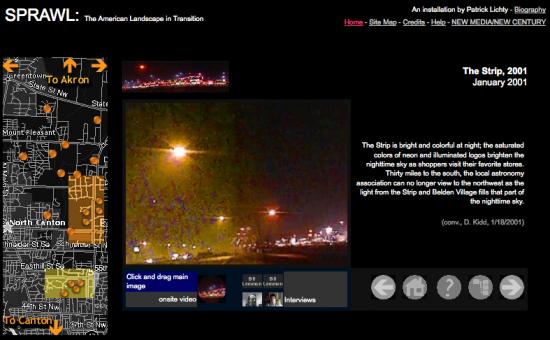
SPRAWL began as a 3-year personal investigation of my own distress about suburban sprawl in the late 1990’s near my home town, and linking this to the larger national conversation regarding sprawl at the time. For reference, I was born in nearby Akron, Ohio – the subject of Chrissie Hynde and The Pretenders song My City Was Gone, which describes the colonization of an industrial city and its countryside by sprawl and shopping malls, so if SPRAWL has a soundtrack, that would be it. I began SPRAWL in 1998, as a series of panoramic photographs of various sites near my home, with just a vague impression that they were a cohesive body of work. Also, the idea of nostalgia for the pastoral farmland of my younger days seemed far too simple to be satisfying, so I knew there was something to it. So, when the Smithsonian American Art Museum put out a call for works dealing with landscape online, I felt this was a fantastic place to really explore this idea in a larger context. Then they offered me the commission, the project went from a set of 32 panoramas to a hyperdocumentary in about three solid months of production, including travelling back to Ohio from Louisiana, interviewing, doing on-site footage, and performing historical research.
What I think is important about SPRAWL is that it’s ‘sensable research’, in that it managed to manifest the ideas I had about this problem, learning a lot more about community ecology, allowing the articulation of a microcosmic issue in macroscopic terms. In more personal terms, it allowed the development of my question of social issues related to my concern with the understanding that my perspective was only one of many, and from examining a multitude of perspectives, I could learn what the larger issues were, and create a discourse with a larger community.
MG: On your website, for the Ghosts of Adak there is a statement of yours, saying “My father and I have something in common. He was born in 1921 and spent 2-1/2 years in the North Pacific campaign on Adak Island in the Western Aleutian Islands in Alaska. I have heard about it since 1962. So I went there for 10 days. And I found him all over again.”
I also visited another site to find out about the community living there, and on this site called Alaska Tracks. Ned Rozell writes “Adak’s having a tough time, and the community of about 200 people in the mid-Aleutians has been struggling since the Navy pulled about 6,000 people out in 1997. It’s got a feel to it now like the Love Canal area of Niagra Falls had in the 1980’s, like everyone took off and left a few ghosts behind.”
How was your 10 days stay there and what did you learn?
Do you have a clear idea of what this project will become? Also, I noticed that it is part of an artist residency program at Eyebeam R&D Atelier NYC. How do you intend to present this work, in a space, on-line or something else?
PL: That’s a book in itself, and probably will be, which is part of your next question. First, why – My father is nearing 90, and for most of my life, he had gone on about this “place” that he had been for a period of time, and recounting endless stories about it. No place else had that sort of impact on him. Does not talk about Seattle, or San Francisco, or even Chicago (all places he had spent time) like that. I also think that as he is nearing 90, and in that he and I have a very strong bond (actually both Lodge brothers, if you can believe that), and I wanted to know about him in the deepest way possible, and probably in so doing, learn about myself and the site. But then, that fits the process.
The issue with Adak is that it is a tremendously complex place even before I overlay my own emotional architectonic. It was the site of the Northern Pacific campaign of the United States versus Japan during the Second World War, mainly as a diversion from Midway. I had made a deal with the CEO of the facility to exchange the photos for a room, a 40-something Niigata-born guy with petrochemical ties, whose father might have been my father’s enemy, and ideologically, probably was mine, but the personal nature of the trip put that on hold. There were a lot of external and internal conflicts that I had to navigate just to get there.

In short, Adak is currently the remains of the Adak Naval Base and surrounding facilities, which is basically a minor port, petrochemical storage facility, a fishery, and home of the westernmost airport linked to the Continental US, further west than Hawaii. If you rent a car, you rent one of the trucks a local offers, the gas comes from the tank farm, and the ‘hotel’ is a number of duplexes that the residents rent out to visitors. There is a General Store, a cafe at lunchtime, and the old VFW becomes the tavern for dinner, offering an entree or some microwaveable snacks along with a full bar. You sign a disclaimer to absolve the Corporation of any liability if you encounter black mold, fall into an old stairwell, sinkhole, run into an old unexploded shell, etc. I’m speaking a little darkly about this place, but it’s pretty rugged with radically changing weather, frequent earthquakes, and they’re still cleaning up the old artillery ranges.
On the other hand, it’s one of the most amazing places to be. It’s right at the edge of civilization, a volcanic arctic island withn no trees and some of the most amazing wildlife you’ve ever seen – eagles, otters, seals, birds. I can see why my father talked about it so much.
One other thing of note is that while doing the project, I’ve run into all sorts of people who have served, lived, or even been born there, as there was a 6,000-person family facility. On the plane from Minneapolis to Anchorage, I ran into an airline pilot who had just been on a caribou hunt there, and he gave me his GPS information and a lot of pictures. On another trip, I ran into a woman who was born there. It was unbelievable.
What did I learn? I learned about a history that few remember, I learned about my own history and how it affects me. I also learned about the local culture, its history, how Alaskan culture meshes with corporate interests to create a lot of the issues seen in mass media. There isn’t a lot of concern for the area from the locals, and actually the Military was doing a decent job with the cleanup. From a more personal level, I also came to understand that everything is transitory. Art, culture, society, all ephemeral in terms of a mountain. Human beings don’t matter very much to a volcano, but definitely the other way around.
When I was walking on the western (uninhabited) side of the island, I had napped on some tundra and realized I didn’t have my GPS or keys – all my keys. I knew where I slept, and I leave my keys in the car a lot. The worst that could happen was that I would have to walk 5 miles into town in a cold drizzle, get Jimbo the Constable to let me into my car and get the truck in the morning. In the end, I learned that if it isn’t a landmine, it’s not that big of a deal.
“Do you have a clear idea of what this project will become? Also, I noticed that it is part of an artist residency program at Eyebeam R&D Atelier NYC. How do you intend to present this work, in a space, on-line or something else?” This is really tough for me – no, I don’t have a clear idea yet because it’s so hard to frame. It probably needs to be a book, but it isn’t going to be done for a couple more years. I’d like it to be a hyperdocumentary like SPRAWL, but not in the same way. Also, I think it would make a great presentation, and the images are really beautiful. As I mention, it’s terribly hard to frame this project, and I think it should be allowed to be large.
MG: Let’s talk about a piece you created with The Yes Men. As many in the know, know – and of course those who have fallen foul to the Yes Men’s activist-pranks; they are legendary cultural saboteurs. They have impersonated World Trade Organization corporate spokespersons, including Dow Chemical Corporation, Bush administration spokesmen on TV, at various business conferences around the world. In order to demonstrate some of the mechanisms that keep bad people and ideas in power. Focusing attention on the dangers of economic policies that place the rights of capital before the needs of people and the environment. They have more recently become more known to a world-wide audience for The Yes Men, a movie.
Could you inform myself, and readers about the mock industrial video ReBurger and how it came about?
PL: Right. The animation work for The Yes Men is a strange beast, because it came from previous work for a group called RTMark, from which some of us came from to do Yes Men, which is well documented in the two movies. Again, the process for these animations, which I later edit into industrial videos is also an odd one. Usually, when there is an intervention (and I have sometimes appeared in person), Mike will give me a call and say something like, “Hey Patrick, we have this idea for this, for that company…” In this case, it was an idea for recycling feces for the Third World, and not much beyond that general concept. At first, I was thinking of translating dietary fiber to textile manufacture, creating a suit that would look like S**t, but shortly thereafter, brainstorming created the McDonald’s parody. I knew it was going to be shown at Plattburgh College, but beyond that, I didn’t have much context. So, that’s where my process in context with the larger presentation sort of diverges. Mike, Andy and Matt were developing the presentation, and I started in on the simple metaphor of eating shit. In short, I get some basic ideas together, and then produce the clips (not the full industrial video).
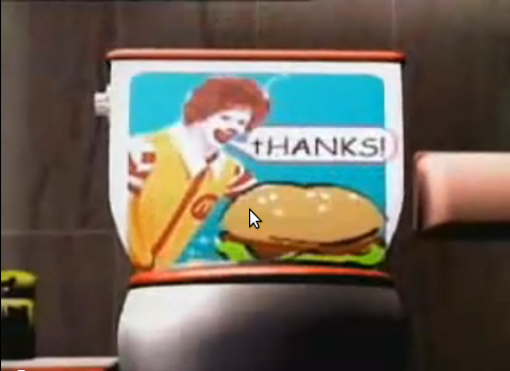
Beyond that basic joke, it’s really just exaggeration – the idea of an international infrastrucure for the collection of post-consumer waste, the branded toilet, and the special product names, like “McDung”. The scene that seems to get people is the one of the Ronald McDonald Colostomy Machine (the paste dispenser) as it creates the brown coil of reprocessed waste and then presses it into nice patties. For me, this is the use of pure literal metaphor, and maybe that’s why it works. Maybe it’s because it stands for a corporation that offers “choices” for healthy eating that few choose, and McDonalds willingly contributes to the obesity and illness of billions. In my opinion, ReBurger just tells the truth.
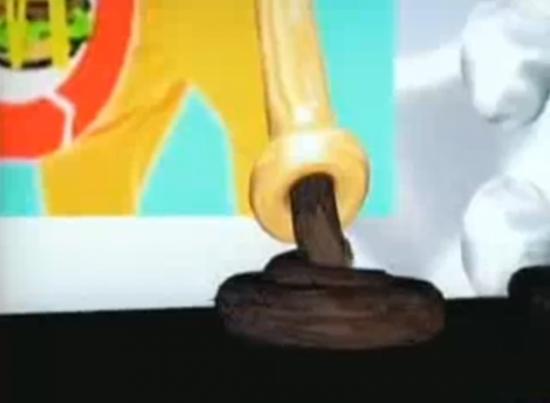
But the reason why people like the video is also a reason why it was a real problem for the sale of the movie at Sundance 2003. Although it was obvious fair use, many in the film industry were also buyers looking at the movie. Mike Bomnano told me that the legal departments of the movie companies were trying to determine the degree of risk of satiring McDonald’s, complete with branding. This was obviously Fair Use under US Copyright, but again, the possibility of an egregious law suit could have happened. In the end, McDonalds decided to ignore the piece, which was great, since I believe it’s one of the stronger Yes Men pieces.
MG: In the UK, June 1997, the infamous McLibel Trial (mcspotlight.org) came to an end. The case was between McDonald’s and a former postman and a gardener from London, Helen Steel and Dave Morris. It ran for two and a half years and became the longest ever English trial. “…Helen and Dave decided that they would stand up to the burger giants in court. They knew each other well from their involvement in community based campaigns in their local North London neighbourhood and felt that although the odds were stacked against them, people would rally round to ensure that McDonald’s wouldn’t succeed in silencing their critics.” The defendants were denied legal aid and their right to a jury, so the whole trial was heard by a single Judge, Mr Justice Bell.
“The verdict was devastating for McDonald’s. The judge ruled that they ‘exploit children’ with their advertising, produce ‘misleading’ advertising, are ‘culpably responsible’ for cruelty to animals, are ‘antipathetic’ to unionisation and pay their workers low wages. But Helen and Dave failed to prove all the points and so the Judge ruled that they HAD libelled McDonald’s and should pay 60,000 pounds damages. They refused and McDonald’s knew better than to pursue it.” Mcspotlight.
I can imagine that McDonald’s were considering their past experience, with cases such as the McLibel Trial. “The legal controversy continued. The McLibel 2 took the British Government to the European Court of Human Rights to defend the public’s right to criticise multinationals, claiming UK libel laws are oppressive and unfair that they were denied a fair trial. The court ruled in favour of Helen and Dave: the case had breached their rights to freedom of expression and a fair trial.”
For your project 8 Bits or Less, in 2002, you wrote a brief statement which I am assuming must be about your own condition, saying “An artist who has become blind (whether physically or ideologically) has resorted to viewing his world through the prosthetic devices that constitute his sense, like cell phones, and wristcams. The result is a distorted landscape that considers Situationist theory, surveillance culture, identity, and alien abduction.” Can I begin by asking why this statement came about and then what part of the project you feel communicates or is expressesed most successfully?
PL: First on the matter of ReBurger, I think that the smarter entities know not to react, but that isn’t always the case. Perhaps the ones who have been burned, now have a smarter PR team.

8 Bits or Less is a series I did that was influenced by several things. For many years, I had felt that as technological artists we are slaves to “innovation”, which is merely an exciting word to stand in for the commercial upgrade path in software and hardware. This set of videos addresses my dissatisfaction with the notion of verisimilitude in regard to techological art, or the “big ticket” piece. Ever since the late 1990’s my response has been to either get by with just enough aesthetic polish to make the work believable/legible, or to willingly embrace a low rez/grayscale time. The lo-fi grayscale is not the same as 8-Bit, which has 256 colors and refers to early personal computing and video games. Perhaps it is closer to my passion for Slow Scan television (a 1970’s video modem technology in which a frame is transmited every 7 seconds) or my position of eschewing resolution and color depth as a form of intransigent aesthetics. In addition, the fact that the frame rate is at most 3 frames per second, and was shot with a Casio Wristcam at one frame every 1.5 seconds was also my homage to Muybridge, mainly in terms of the grayscale and serial qualities of the video. Beyond that, and the fact that each video consists of about 900 frames, all hand edited, perhaps 8 Bits or less is more about my politics about the technological industry and personal differences with New Media and technolust.
On the personal side, 8 Bits or Less is an allusive fable having to do with the fact that I have been blind a couple times in my life, but this blindness can translate to the fact that for a period of time I felt that I had immersed myself in my studio for long enough, that I saw the world primarily from my screen. Therefore, although I had been visually imparied for part of my life, much of which has been fixed by having cataract removal in 1999, I still felt that there was a metaphorical blindness caused by society’s use of mobile devices, the existential distorions of 24-hour cable networks and the Internet. Therefore, the series (if you listen very closely) incorporates a mix of postmodern theory and hyperbolic statements about aliens, obscure jokes about bits and nybbles, surveillance culture and the abjection of low fidelity.
What I think is successful about it is that it holds together at all, or that it engages the viewer without necessarily relying on leading edge technological conceits, but perhaps using the wristcam aethetic is a conceit in itself. Antoher aspect that I have enjoyed about it after five or six years is that it is a really hallucinogenic series of pieces. But then, I think this is the point that Gibson made about cyberspace that has been expanded on by the Baudrillardian mediascape and the Internet – the consensual mass hallucination (facilitated by mass communications).
———
Watch 8 Bits or Less series. Images link to videos online.

A wristful of bits. Found on DVlog.
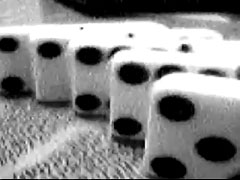
8 bits or less. Found on DVlog.
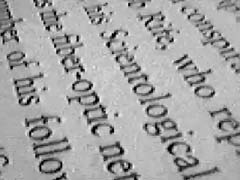
http://www.dvblog.org/movies/04_2007/lichty8bit/closevision.mov
Close vision. Found on DVlog.
Big thanks to DVblog for 8 Bits or Less images & video links.
http://dvblog.org/
Marc Garrett: You are an artist who works solo and with others in various ways. A large body of your work consists of performances, interventions and sound recordings. I want to begin this interview by asking, why you decided to form ‘The NeoFuturist Collective‘, and what was the main mission or purpose behind such a collective?
Joseph Young: The NeoFuturist Collective was born as a convenient way to house a piece of work I was making called ReAwakening of a City. The idea had started as part of a practice-based PhD at SMARTlab UEL, but as soon I got funding for the project from the Arts Council, I realised I didn’t want to spend the next four years writing about it…
I invited a group of artists to join me in making a collaborative piece of work from a seemingly simple premise – the transformation of urban noise, inspired by futurist artist Luigi Russolo’s Art of Noises manifesto. Russolo had created a series of “noise networks” or symphonies for his mechanical intonarumori (noise makers) back in 1914, and in so doing he had influenced the entire course of 20th century music.
Despite his contemporary resonance, little is generally known about Russolo’s work, as all of his instruments were destroyed in the intervening two world wars. Of the scores he wrote, only the first 7 bars remain of Awakening of a City, and that only because it was reprinted in the art magazine Lacerba. Apart from the fragment of written score there are letters, reviews, photographs and other forms of documentation which have led researchers and artists over the years to try and recreate his noise making instruments.
Our project is rather different – we use the remaining 7 bars as the starting point for a new piece of work, ReAwakening of a City, engaging with all forms of visual and aural urban noise that we spend so much time trying to block out. Traffic noise, junk emails, health and safety warnings, advertising and street furniture. The form is performative, visual and mediated as well as musical, using all available means at the disposal of the 21st century artist.
By engaging with my artist-collaborators’ practices, I commission work that responds to this central idea and then set up an appropriate curatorial context for extending that individual response into a collective noise network.
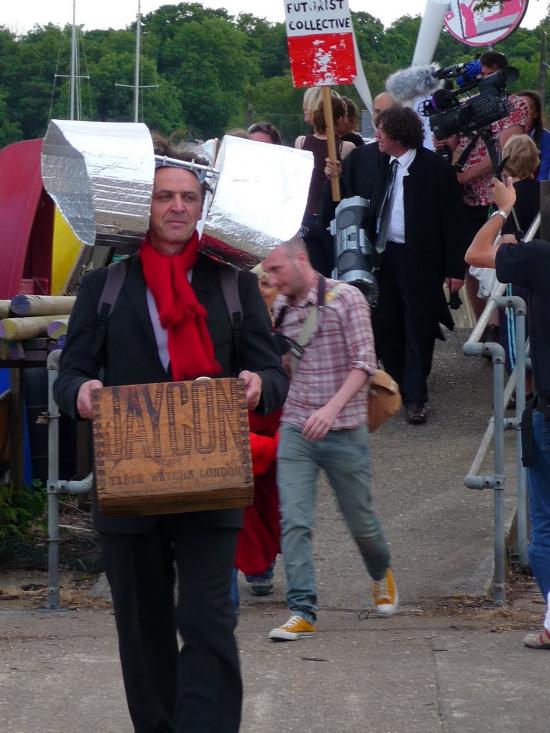
MG: Where did these ReAwakening of a City events happen, and what kind of response did you receive when these performance, interventions took place? How important was it to connect with others – every day people, whilst engaging in the process of expressing these real-life experiments?
JY: The first ReAwakening took place in Brighton in Feb 2008. We started off the project by declaiming the NeoFuturist manifesto (written by Rowena Easton) in Jubilee Square, with a bunch of workmen and their drills providing a fabulously appropriate accompaniment to the text which celebrates Urban NOISE. (The manifesto can be downloaded from www.neofuturist.org). The crowd then followed us onto the Arts Council offices where we laid a wreath on their steps in support of all the companies that had been recently cut – we were ourselves in receipt of Arts Council funding at the time. A classic case of biting the hand that feeds you. Our activities provoked mild amusement and little controversy however, as the good citizens of Brighton & Hove are used to seeing “crazy” artists peddle their wares in public.
A couple of months later we had our first performances of work-in-progress at The Basement, Brighton. The reaction here was far more hostile and interesting, with some audience members questioning our politics in the Q&A session afterwards, accusing us of proto- fascism. Actually the level of debate was thrilling, as we really touched people’s buttons and ended in a deep discussion about the impact of the Futurists and their relevance to the current political climate. This question surfaced again a few of months later in an online interview with The Thing Is… magazine.
We were fortunate after that to be invited to make a piece of work on Wall Street in New York for the psychogeographic festival, Conflux. Our proposal was to make a walking performance that explored the everyday experience of living and working in the Wall Street district and how this might inform our understanding of the impact that this small area of real estate has on the rest of the planet. We arrived on September 11th 2008 to be met by 9/11 conspiracy theorists on street corners, and proceeded to spend several days mapping the area through sound recordings, text and video in preparation for a dawn performance on 14th September – a ReAwakening as the city awakes. The effect was dramatic and unexpected, as my declaration of the NeoFuturist manifesto outside 1 Wall Street brought about the collapse of Lehmann Brothers that weekend and the subsequent domino effect on the global economic system. Sorry world!
Our next major intervention was more low key, but no less dramatic as we were commissioned by Fuse Medway festival to engage with and inspire the village community of Upnor. Our mission was to get the people to take to the streets in a protest/celebration march. We worked with the community over a number of months, holding public workshops and meetings, networking furiously in the local pub (one of four!) and it soon became clear that the general apathy towards the arts, and outsiders in general, meant that if the public were not going to come to us, then we would have to go to them. So we took to the streets and made work in public which enraged some, who questioned where our funding had come from, but delighted others and built a momentum towards our final performance.
A Call to Arms (as the piece was finally called) took place in June last year and was a very successful example, I think, of how one can make “community art” challenging as well as accessible. See http://neofuturist.blogspot.com for full documentation and a film of the performance.
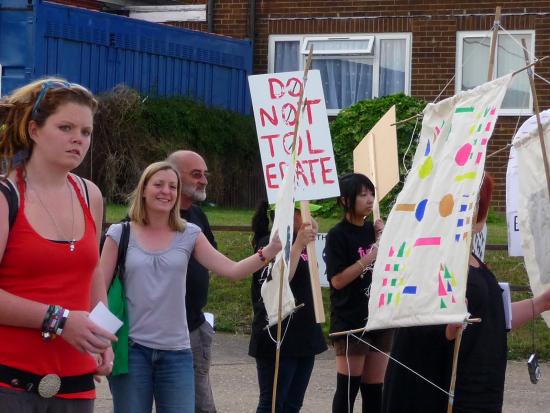
Other pieces of work, include shouting at the Futurist paintings with a megaphone, as part of the Tate Modern Futurist retrospective last summer. An experience as liberating as it was faithful to the original spirit of futurism, causing equal anger and delight amongst an unsuspecting public. I was also invited as a panellist to take part in a public debate along with other luminaries from the art world, on the subject of “Is the Avant Garde Passe?” organised by The Institute of Ideas in London. Here the public paid to witness a lively and informed panel discussion around the relevance of contemporary art, proving, it seems to me, that there is a real appetite for intelligent, politically driven commentary and debate.
A group of artists drawn from the fields of visual, performance, video and sound art will attempt to transform the everyday language of urban sounds and visual junk (such as spam emails and billboard advertising) into a true multi-media experience to do just that; asking us to question our assumptions about what is beautiful in a modern world of information overload.
MG: Your comments that contemporary art is in need of intelligent, politically driven commentary and debate rings true. In respect of my own art context(s). Thinking of the many amazing self-organised, networked communities, of which there are many, on-line and in physical space; there has been a massive shift of art creating, moving independently, yet in parallel to the ‘official’ and hegemonic examples accepted or considered contemporary at the moment. Of course, if we think about what contemporary means itself, it means existing, occurring, or living at the same time. The relationship between institutions and art which is actively critical and more challenging than easier processed art such as Brit Art, how they represent contemporary art.
Considering the history and knowledge we have regarding the original Futurist movement, and its close connections with fascism. For instance, what is less known is that, the Futurist movement did not only consist of fascists, but within it there were also socialists, anarchists, leftist and anti-Fascist supporters. Consisting of interesting individuals such as Georges Sorel, who explored his own views and intellectual thinking, right across the political spectrum. Georges Sorel “…was a voluntarist Marxism: he rejected those Marxists who believed in inevitable and evolutionary change, emphasising instead the importance of will and preferring direct action. These approaches included general strikes, boycotts, and constant disruption of capitalism with the goal being to achieve worker control over the means of production.” http://en.wikipedia.org/wiki/Georges_Sorel
I can see a direct link from Sorel’s activist approach and The NeoFuturist Collective’s ReAwakening events and performances. Of course, there are some other pretty good contemporary art activists out there at the moment, who also incorporate performance as part of their creative process; such as ‘The Office of Community Sousveillance’. “This work rests between legality and illegality. By posing as security officers, ‘PCSO Watch’ imaginatively play at the borders of what is typically deemed right and wrong, real and unreal, pushing their expression in the form of political enactments and direct action. This is a paradigm shift, not particularly interested in the art critic’s perspective.” http://www.furtherfield.org/displayreview.php?review_id=338
“Futurism has produced several reactions, including the literary genre of cyberpunk — in which technology was often treated with a critical eye — whilst artists who came to prominence during the first flush of the Internet, such as Stelarc and Mariko Mori, produce work which comments on futurist ideals.” The legacy of Futurism. http://en.wikipedia.org/wiki/Futurism#The_legacy_of_Futurism
With the understanding that there have been various influences, mutations and re-appropriations from the Fururist movement, I am wondering what elements you feel or think are still important to reclaim, reshape and reintroduce into a contemporary world, both in respect of the art arena and in relation to our everyday environments?
JY: What interests me in relation to the Milan Futurists is, first of all, the misperception, as you have pointed out, that futurism was primarily a fascist movement. My understanding is that Marinetti was the only artist to have that association, having been invited to serve on the Central Fascist Party Council after the First World War. He resigned not long after as soon as the Catholic Church was also invited to sit on the Council – Marinetti being an avowed atheist. This is not to excuse the entire movement of this problematic association, but it does put it in context. It also recognises that a spirit of optimism and a belief in technological solutions to the world’s problems, that futurism embodied, also has its’ darker side. And it is with this knowledge that I choose to engage with (neo)futurist ideas in the 21st century, as it seems to me, that in a world seemingly on the verge of collapse, that a spirit of positivity renewal is both urgent and necessary, and also the ultimate political gesture.
You mention various artist collectives that have appropriated the futurist legacy in this way, and to that I would add Ultra-Red who, incidentally, published a short sound piece of mine, recorded on Wall Street during the crash of 2008, as part of Fifteen Sounds of the War on the Poor vol.3.
In order to engage with the state of the planet, artists can no longer cling to romantic, utopian notions of nature/beauty in opposition to man/technology. This dichotomy seems to represent more about human self-loathing than it does about a workable solution to global warming/terrorism/the energy crisis/reform of global capitalism, etc. Moreover it leads us towards a new “medievalism” (ban air travel, ban cars, buy local) that is all too prevalent in ecological pressure groups. In this argument, man has brought us to the edge of destruction, therefore we must drastically scale back all of our wealth-producing activities. As if the (post)modern world could be wished away in either Luddite vision of the future or more worryingly in the ideology of The Zeitgeist Movement, whose apocalyptic vision of a radical eco-future involves tearing down our cities and rebuilding them.
This thinking is also represented in the work of acoustic ecologist and renowned nature recordist, Bernie Krause in his article, Anatomy of the Soundscape: New Perspectives, Journal of the Audio Engineering Society, Jan/Feb 2008 Vol. 56 Number 1/2, Pg 73-80 (2008), in which he dissects the soundscape (a term first coined by R Murray Schafer in Soundscape: The Tuning of the World) into 3 separate strata:
“GEOPHONY is framed as natural sounds emanating from non-biological sources in a given habitat.acoustic variations. BIOPHONY By far the most complex and laden with information, this unique feature of the soundscape is comprised of all of the biological sources of sound from microscopic to megafauna that transpire over time within a particular territory. ANTHROPHONY, defined as all of the human-generated sounds that occur in a given environment: physiological (talking, grunting, body sounds), electromechanical, controlled sound (music, theatre, etc.), and inci- dental (walking, clothes rustling, etc.).”
In this breathtaking philosophical leap, Krause removes the human from the natural environment and pits him/her in opposition to it. In creating a separate category for human sound activities outside of the biophony (i.e. the sounds of all other species on the planet), he is both over-stating human control and dominance over the environment and also denying us a role in the Gaia hypothesis – one of the green movement’s central texts, that views the Earth (and all of its inhabitants) as a single organism.
I am certainly not refuting or seeking to contradict many of the arguments regarding human sound activities and stress levels, posited by the World Soundscape Project, of which Krause is a prominent member, but it is worrying that so many eco-activists see humanity as a problem and not as a solution. And this is where Futurism and its antecedents/mutations can offer a way forward…
If, as I believe, we can find beauty within the drone (our drone), then the clamour of urban noise, both visual and aural, can be transformed in our perceptions into something of interest and value, rather a thing to be blocked out or ignored. If we can stand in a busy place such as Oxford Circus in the centre of London and open our ears to the sonic detail that is contained within the omnipresent drone of human activity, then we can begin to understand that activity as a creative as well as a destructive force. We can then harness and use this energy to power and revitalise the human spirit.
So, for me, the Art of Noises manifesto is the central and critical text in beginning to shape a new understanding of the contemporary sound and land-scape. If we can find a way of reframing urban noise as a meditative experience, as I recently did in my residency with Blast Theory, then we are part of the way to ReAwakening our cities as places of hope and optimism. To do this, I made a number of immersive binaural recordings of the area around 20 Wellington Road, where Blast Theory are based on the industrial outskirts of Brighton, and mediated these as iPod listening experiences in a temporary installation space that I set up for the event. When I came to retrieve participants from the room (they went in 4 at a time) they had invariably made themselves comfortable and been totally immersed in the sounds of the local traffic. They often described their experiences as “relaxing” and “enjoyable”, and how many times can you say that of the experience of standing beside a busy, urban, traffic-filled road?
So that is my mission for ReAwakening of a City; to take Russolo’s lead from the surviving 7 bars of his score to Awakening of a City (1914) and reframe and rework the paradigm of the celebration of urban noise to (re)awaken of all of the senses through a heightened perceptual shift in one of them – that of hearing; the neglected sensory cousin in our predominately visual culture. My ultimate ambition being to create a large-scale performance event for the 100th anniversary celebrations in 2014, in collaboration with like-minded artists from around the globe.
Decode: Digital Design Sensations
The Victoria and Albert museum, London
8 December 2009 – 11 April 2010
Decode: Digital Design Sensations at the Victoria and Albert Museum (V&A) brings the state of the art in art computing to a venerable cultural institution. Everything from the posters and banners around town to the hoardings on the entrance to the gallery containing the show makes it clear that Decode is a serious cultural event. It’s a spectacle, a dark space alongside the well-lit galleries of the V&A, drawing you in with points of light and distant sounds. The crowds are reassuring for the popularity of art computing yet disconcerting for the experience of the art at times.
Don’t forget to ask for a catalogue as you hand over your ticket on the way in. The sponsor’s foreword should raise a smile to anyone familiar with the software industry, but the introductory essay (which only occasionally becomes the latest casualty of the confusion that the word “open” shows), the details of works in the show and the interviews with Golan Levin and Daniel Rozin are all very informative. The catalogue also draws attention to Karsten Schmidt’s specially commissioned graphic identity for the show, which can be downloaded and modified as Free Software.
The show is divided into three sections. Generative art, data visualisation, and interactive multimedia (or, as the catalogue puts it – Code, Network and Interactivity).

The generative artworks suffer in comparison to the other pieces by being mostly small-scale screen based pieces. However appealing the images are on the screen (and they are) they cannot compete with the projections and three dimensional installations of the other sections. With the exception of an interactive version of the video to Radiohead’s House of Cards by James Frost and Aaron Koblin, the work does not refer to the human figure or to the viewer, another feature of many of the most popular pieces in the other sections. And apart from Matt Pyke’s typographic totem pole, my other favourite piece of the section, the work is calm. Beautiful, but calm. It would reward prolonged contemplation in a quieter environment and might benefit from presentation on a larger scale to better bring out its aesthetic qualities. But this is not that environment, and that presentation is not given to the work here.
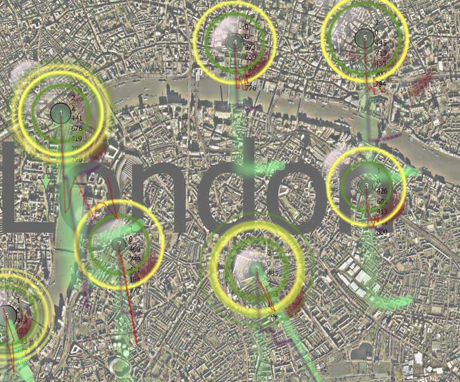
The data visualisation section has more projections and custom hardware, and also has more human interest. The emotion of We Feel Fine by Jonathan Harris and Sep Kamvar, the surveillance state expose of Stanza’s Sensity, CCTV assemblages, Make-Out, the porn-inspired kissing figures of Rafael Lozano-Hemmer and the social data visualizations of Social Collider by Sascha Pohflepp & Karsten Schmidt are sometimes less visually sophisticated than some of the generative pieces, but address current social and technological developments more directly. The world wide web is twenty years old, it has drawn in the mass media and media feeds from the real world, and many of its users produce and encounter gigabytes of data over time. Representing and exploring that technological and cultural environment is something that art can do and that art is particulalry well placed to do given the importance of the aesthetics of interfacing and visualisation to the contemporary web.

The interactive multimedia section contained the real crowd pleasers of the show, although some of the pieces had “out of order” notices on them when I visited. Yoke’s virtual reality Dandelion Clock controlled by a hairdryer, Ross Phillips’s Videogrid, a physically interactive group portrait and Daniel Rozin’s Weave Mirror, a cybernetic sculpture-cum-display-screen. They all give their audience an aesthetic experience that briefly changes their relationship to the world, and in some cases shows them themselves in that new relationship. Interactive multimedia installation is clearly due a resurgence.
The V&A have presented Decode as a design show. I was struck by this framing of the work when I visited the show, and most of the people I have spoken to about the show since have commented on it as well. Many of the participants are graphic designers or work in design as well as art and education, but much of the work would be poorly served by being regarded as design rather than as art. It is not advertising, or presentation of anything other than itself for the most part. Where the work is information design, the information has been chosen by the designer. That said the art computing MA I attended as a student had to be called a “design” course to get funding, so possibly this is a constant. And the V&A have done a great job of presenting the work and letting it speak for itself to the visiting crowds.
This isn’t quite Cybernetic Serendipity 2.0. It excludes the conceptually and performatively, rougher edges of contemporary art computing. But these exclusions are largely practical; there is no livecoding and there are no email or self-contained web browser-based works. Some of the work is strikingly but subtly political in its representation of current social and political trends such as surveillance, online pornography and the death of privacy.
The V&A have done the conventional artworld and the general public a great service by presenting Decode. The show contains enough big and up-and-coming names in art computing and digital design to provide a convincing if necessarily incomplete survey of the contemporary scene. Decode also serves an important role for artists and students with an interest in or a stake in art computing by focussing attention on what others have achieved that can be built on.
Decode shows the achievements of the personal computing and web eras of art computing becoming established with and recognized by the broader arts establishment. The danger is that the story will finish triumphally here. Processing has become the new Shockwave, and particle systems and shape grammars are not enough in themselves for long without an accompanying progressive and deeper deeper engagement with the aesthetics and history of art, technology, wider society, or all three. Art computing is not immune to technical and aethetic conservatism. To avoid this I think that it needs to intensify, to become more like itself; to become more beautiful, to tackle larger datasets, to become more interactive. In other words, it needs to build on the achievements gathered together and presented here.
http://www.vam.ac.uk/exhibitions/future_exhibs/Decode/
The text of this review is licenced under the Creative Commons BY-SA 3.0 Licence.
Image: SMartCAMP logo, all images courtesy of SMartCAMP
Part of New York’s Art Week, SMartCAMP, or social media art camp, took place on March 5th and 6th, at the Roger Smith Hotel in New York, a slightly unusual kind of place in that it’s a hotel with its own production company. That company’s artistic director, Matt Semler, who is also the director of The LAB Gallery, became interested in the ways Roger Smith marketers Adam Wallace and Brian Simpson were using platforms like Facebook and Twitter to build an online community. According to Semler, his curiosity “ultimately led to more questions than answers and we found ourselves wanting to bring the leaders in the social media (SM) art world together to talk about their process, goals and best practices. Once we came up with the name SMartCAMP we were pretty much off and running.” Conference organizer Julia Kaganskiy of New York’s Arts, Culture, and Technology Meet Up curated SMartCAMP’s program and a former actor, Danika Druttman, handled communications for the event.
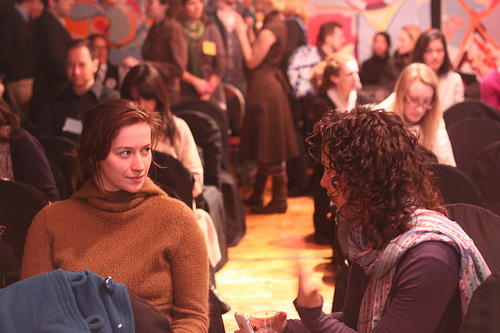
In other words, from the beginning SMartCAMP was about people, people who post, blog, tag, add, and tweet, but above all, people who meet and link up through quirky, often unpredictable, circumstances to pursue a shared idea. According to the speakers in SMartCAMP’s program, this is the kind of easy serendipity that gives social networks their authenticity and value. While these qualities can’t quite be summoned, they can be encouraged and directed. For artists and administrators, the question is how to sustain these connections to build audience and patron loyalty. Whether you like the idea of artists taking on their own distribution, or whether you find it somehow uncomfortable, social media is influential and growing. As more than one person pointed out, social networking has surpassed pornography as the number one activity on the web.
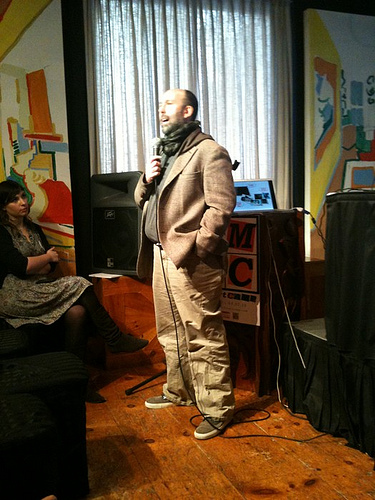
Mark Schiller’s keynote opened the Saturday session. Well-known in the New York arts community, Schiller is the founder of The Wooster Collective, a public arts site that documents street art from around the world. Like many successful online projects, Wooster Collective began accidentally. Out walking his dog in his downtown neighborhood, Schiller began photographing street art, which he then posted online, forwarding the link to friends, and asking for their reactions. Soon his web page was managing hundreds of photos, receiving thousands of hits per day, and turning artists into online celebrities. Two Wooster Collective discoveries that have gone viral are Josh Harris, famous for his subway grate inflatable dog, and Jan Vorman, an artist who uses Lego bricks to patch crumbling city walls. Today, after eight years of posts, The Wooster Collective is the online authority on street art. Schiller receives a self-sustaining five hundred emails a day from artists who have done work, or have seen work, and would like to contribute. Wooster Collective also has a YouTube channel and a Twitter feed.
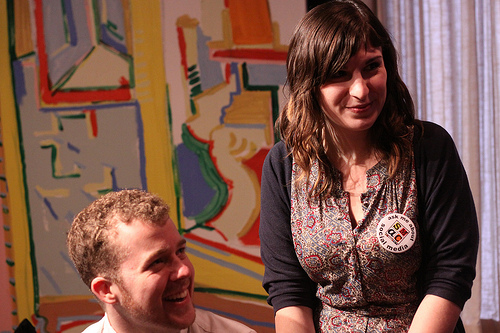
In many ways Wooster’s success seems unpredictable and non-reproducible, a fad, some kind of dumb luck. Yet, in retrospect, Schiller is able to point out specific qualities that made the site popular. First, there was page rank. Since no one was writing about street art in any other media, Wooster Collective’s art tags quickly went to the top of the search engine indexes. This kind of self-reinforcing rank allowed Schiller’s blog to get more traffic and, consequently, to pull more traffic from user searches. Second, ninety percent of the content on The Wooster Collective was original, making Schiller’s blog a feeder for other arts pages, increasing its incoming links and, again, boosting its reputation and its rank. Third, there are no ads at all on the Wooster site per se, mostly, Schiller says, because ads would be distracting both for him and his followers. Free from ads, Wooster Collective has no traffic stats to maintain, meaning Schiller is free to indulge himself in what his readers like best, Wooster’s own weird personality. On most days the site wavers slightly between media outlet and community bulletin board.
However, as important as his community may be, Schiller explained that Wooster readers are actually heavily restricted. The community is largely passive. Readers can email, but they can’t comment, upload, or see who else is online. Although some of site is user generated content, sites built on user content are notoriously second-hand and boring, so reader contributions are very heavily curated. The result is a blog that remains personal and interesting to all. Schiller also says audience building on the Wooster site has always been secondary to his main mission of sharing a passion for street art. According to Schiller, that passion is what works online and the effort to express it means a willingness to try anything. After all, Schiller reasons, “if you don’t like it, you can always stop. If a projects takes more than ten minutes to finish, stop. If it’s not fun, stop. If it’s not inspiring, stop.” Finding podcasts “not fun”, The Wooster Collective recently quit making them. They quit making mobile apps too. Schiller suspects that it is the resulting cheerfulness, lack of strain, exuberance, or even silliness, that connects an audience to a blog, a pursuit, or to an artist.
For Etsy, an online site where artists sell their work directly, community came first, web presence second. Anda Corrie, manager of Etsy’s Twitter feed, explains that Etsy was started at a time when the DIY arts culture was strong and growing, but artists still had few outlets for what they made. Etsy was one of the first sites to give them that outlet and, for a small commission, the site benefited greatly from its fortunate timing. Still, there is a balance between artist and audience that sustains Etsy and makes it work. In addition to responding to community needs, Corrie notes that the governance of sites like Etsy should be as transparent as possible. She reminds media managers rushing to reach out to remember to build a way for their readers and followers to reach in. Etsy uses a community council model. Councils change monthly, giving suggestions for improvements to the site and its forums. This is a time consuming model to attempt but, like Schiller, Corrie feels media planners who go through the motions without really getting involved are unlikely to succeed.
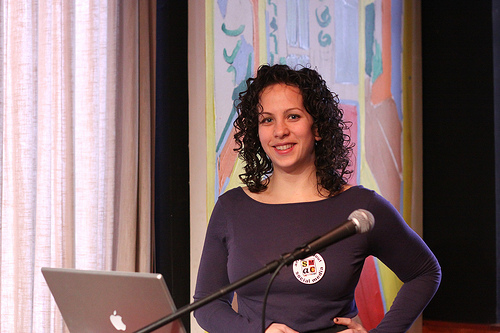
Michelle Shildkret, who represented Cake Group would say that you can’t fake what you are online, just as you can’t hire someone to “make you go viral”. She advises artists to slow down, figure out who to reach out to, where they are online, what they do when they’re online, and how someone might get their attention. When you can answer those questions, you’re ready to approach a social media plan. Shildkret also believes that a small, engaged community may be better than thousands and thousands of disinterested friends. Choose to introduce yourself and your work to places you like, make a difference there first, then advance slowly. John Birdsong of Panman Productions says artists often need to open up in exchange for popular attention. Birdsong endorses the strategy of a behind the scenes look at a studio or art process by posting “making of” videos to UStream or YouTube. These sentiments were echoed by others. Natasha Wescoat, a writer for EBSQ, the self-represented artist’s blog, became obsessed with eBay auctions as a community college student. Wescoat noticed that what honestly attracted her to an artist’s online profile was not necessarily the work. As an audience member, she also wanted personality, a connection, and some sense that there was a real person behind the presentation. Where Schiller describes a community that grows out of a shared passion, Wescoat sees community as a group centered on personality. Like Schiller, she encourages artists to try all ideas, continue with what feels right, and allow a web identity to evolve over time. For example, Wescoat describes her own online identity as an arc with three phases: experimentation, where she tried different approaches to making and selling work; narcissism, where she spent a good deal of time showing how the work was made; and establishment, where the size of her online audience is large enough to attract commissions from corporations and collectors.
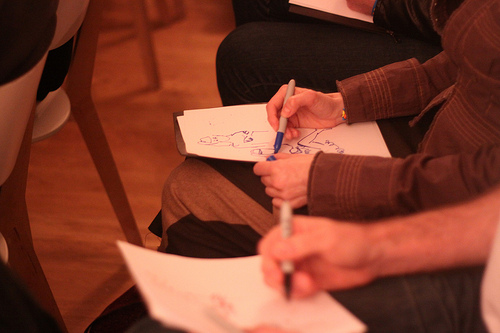
Sharpie sketch queen and self-described “art school drop out” Molly Crabapple credits her web personality as fundamental to a full-time practice that draws commissions from the New York Times and Marvel Comics. Founder of Dr. Sketchy’s Anti-Art School, Crabapple introduced her online persona by compulsively posting to LiveJournal. Today, her favorite platform is Twitter and her media tool of choice is the one hundred and forty character tweet. Crabapple likes Twitter’s immediacy and tweets to get illustration suggestions from her followers, to find emergency crash spaces, and to “manifest” anything. She advises underrepresented artists to do whatever it takes to build a following online: friend friends of friends, promise to perform humiliating stunts for your followers, tweet about everything you do, reward your one hundredth or one thousandth follower with some kind of gift, a sketch or drawing, for instance. When the earthquake struck Haiti, Crabapple tweeted for drawing suggestions, drew those suggestions live online, then auctioned those drawings off in a benefit for Doctors without Borders. Yancey Strickler who co-founded the microfunding platform Kickstarter goes a step further. Kickstarter allows artists to post projects online and request small funding pledges from their followers. These pledges remain virtual until the project pledges reach full funding. At that point, sponsors pay up, the project is funded, and Kickstarter receives five percent of the amount raised. But pledge money is not always a reflection of your project pitch, Strickler points out, saying that what succeeds online is a good narrative and a connection with the audience that feels authentic. According to Strickler, people on Kickstarter are only somewhat concerned with the quality or originality of the work in front of them. More often, their decision to contribute to an artist’s goal proceeds along the lines of questions like “Do I like this person?” or “Could I be friends with this person?”.
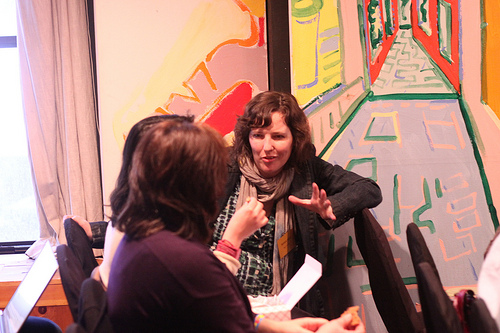
If all this sounds a bit disingenuous or self-serving, remember that social media connects artists and audiences directly and that this connection now has its own considerations. There are some dangers in its manipulation, but the benefits need to be recognized. Adam Smith of Dance Theater Workshop’s and the New York branch of the Neo-Futurists uses blogging and community choreography as forms of outreach. While there are no hard numbers for increases in audience through the blog, DTW’s paid audience has gone from sixty to eighty percent of the house. Working on getting the tools right isn’t necessarily a negative and will probably take some work. Dancer Lisa Niedermeyer says: “You can’t just be clever, you have to be smart, and that none of this has been around long enough for any of us to be wise (yet). That any one experiment can be clever, and with speed and easy access can go live, but it takes being smart for it to be sustainable.”
Niedermeyer works on Virtual Pillow, the tech initiative of Jacob’s Pillow Dance. In some ways Niedermeyer considers the company’s online presence a fourth stage: “A global, interactive space serving a virtual community that might not ever be able to physically visit us in the Berkshires of Massachusetts, but highly value our archives, performances, professional school, creative development residency programs, etc.”
A second part of Virtual Pillow’s mission is to bring the work of the company, including its history, to a wider audience via social media, streaming sites, or any other online platform. Niedermeyer attended SMartCAMP for the chance to hear other institutions and artists discuss what worked and what did not. She says the conference gave her more perspective on the strategies available to Virtual Pillow: “I felt that the conference speakers and participants were really talking about the big picture, big ideas. Gravity Rail, for example, with their passion to explode open and transform eCommerce models for artists.”
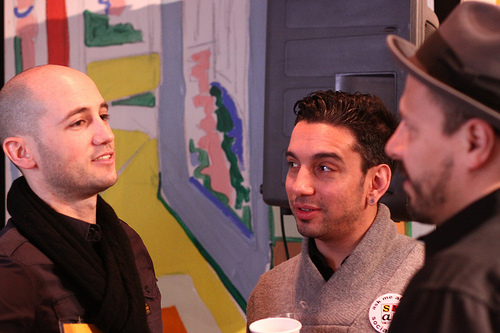
Performers are not alone in the need to link up. According to Nancy Proctor, the museum is a distributed network whether curators accept that idea or not, and agile use of social media is essential to responsive curation. Proctor heads New Media at the Smithsonian American Art Museum, a museum which now gets more visitors online than in person. Are those online visitors any less real? Should their visit be any less satisfying? Should their use of the museum be any less respected? Noting that desktop activities are increasingly moving to the mobile web, Proctor urges curators to meet visitors where they are through sms, tweets, and mobile applications.
Examples of another kind of user centered curation came from Titus Bicknell, founder of pinkink, who believes audiences and their questions now lie at the center of any program strategy. Bicknell’s examples of user centered curation included a podcast that asks visitors to enter a space, look at the art, and record any questions they might have. In this curation model, socially aware programmers ask audiences what they would like to know, rather than telling audiences what it is believed they should know. Allegra Burnette, Creative Director of Digital Media at MoMA, pointed out excellence in web presence like the Indianapolis Museum of Art’s fine arts blog ArtBabble, but added that MoMA uses Twitter feeds specifically to talk about current exhibitions at home and elsewhere. MOMA also offers podcasts on iTunesU where, Burnette says, downloads have increased about ten times this year. More and more, curation extends beyond the exhibit to the conversation about that exhibition, a conversation that defines your institution on the social web through bookmarking, favoriting, collecting, sharing, recommending, and searching. Like the Wooster Collective’s Schiller, Burnett advises media managers to avoid blatant marketing and to discuss events of interest to readers whether those events are part of a home exhibition or are occurring elsewhere.

Even in competition with Arts Week, SMartCAMP sold out. In addition to a long list of good speakers, there was a great deal of conversation and connection going on across the seats, in the halls, throughout the lobby and meeting rooms, and at the bar. Absolutely no one was asked to turn off a cell phone. Executive producer Matt Semler says: “We trended on Twitter both days and ended up with 120,000 individual views on UStream. The audience was very nicely mixed. While we don’t have any specific data on demographics my impression was that the room was evenly split between art executives and artists.”
In April, Semler and Roger Smith Arts will present a cello performance by Peter Gregson from within a Morgan O’Hara installation inside The LAB gallery space in New York. As Gregson plays, O’Hara will perform one of her “Live Transmissions” of Peter’s performance. The event will be streamed live over UStream and, as with all LAB performances, will be viewable from the street as well.
Featured image: F.A.T. Lab (Free Art and Technology Lab) were found causing trouble at the Transmediale.10 this year.
An interesting outsider project at Transmediale.10 this year, was F.A.T. Lab (Free Art and Technology Lab). A collective of artists, engineers, scientists, lawyers, musicians and trouble-makers who have been working together for two years, on the intersections of Pop culture and Open source. Their stapline describes them as “An organization who is dedicated to enriching the public domain through the research and development of creative technologies and media”. Beware, they love using the word ‘Fuck’. A lot! Which means they are cool, and some you grown ups may feel slightly unnerved by their over generous outpouring of flippant explitives, but the kids out there just love it!
You can read an explanation of their work in the about section on their website, and view a video presenting some of their ideas and works. With a simple rap base with nasty yellow and pink colors, it could be considered as a joke. Perhaps, to some degree it is, but at another level they are playing around with social contexts of the Internet culture’s, presumptions and acceptance of things. Through an omnipresent ludic approach they reuse what is given to us all with a contemporary pop attitude – showing us the many contradictions from these given systems. Proposing other possibilities in order to loosen and to free things up from the copyright laws and prescribed rules of both big companies and clumsy governments.
One of their projects called Public Domain Donor, consists of D.I.Y stickers saying “In the event of death please donate all intellectual property to the public domain”. They write “Why let all of your ideas die with you? Current Copyright law prevents anyone from building upon your creativity for 70 years after your death. Live on in collaboration with others. Make an intellectual property donation. By donating your IP into the public domain you will “promote the progress of science and useful arts” (U.S. Constitution). Ensure that your creativity will live on after you are gone, make a donation today.”Simple and humurous.

Yet, behind their process of cultural detournment exists a reference to earlier net art critique, by Critical Art Ensemble who way back in 1995 said “Each one of us has files that rest at the state’s fingertips. Education files, medical files, employment files, financial files, communication files, travel files, and for some, criminal files. Each strand in the trajectory of each person’s life is recorded and maintained. The total collection of records on an individual is his or her data body -a state-and-corporate-controlled doppelganger. What is most unfortunate about this development is that the data body not only claims to have ontological privilege, but actually has it. What your data body says about you is more real than what you say about yourself. The data body is the body by which you are judged in society, and the body which dictates your status in the world. What we are witnessing at this point in time is the triumph of representation over being. The electronic file has conquered self-aware consciousness.” The Mythology of Terrorism on the Net. Critical Art Ensemble Summer, 95
Also as stimulating, is the idea Graffiti Markup Language, an XML file type specifically designed for archiving graffiti tags, and easily reproducing them.
For Transmediale.10 they presented a project called Fuck google, one of their more involved works, appropriating the image of Haus der Kultur der Welt, the futuristic bulding hosting Transmediale, formerly known as the Kongresshalle conference hall, a gift from the United States, designed in 1957 by the American architect Hugh Stubbins Jr. as a part of the Interbau exhibition. John F. Kennedy spoke there during his June 1963 visit to West Berlin. Fuckgoogle focuses on reminding us all how this big company has become omnipresent in our digital lives, refering to the risk that too much data is owned and is going to be owned more and more, just by Google alone. It exists as a collection of browser add-ons, open source software, theoretical musings and direct actions.
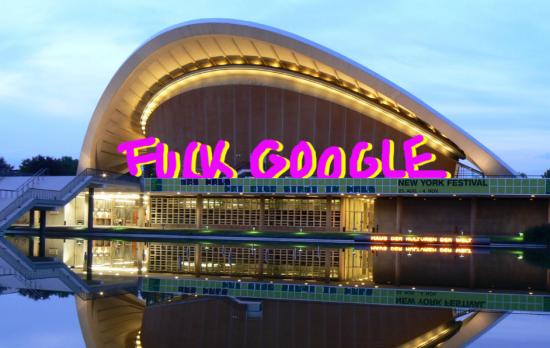
Not necessarily trying to be a definitive solution against the big G in any sense of the word, but more a reminder, a provocative virus to diffuse. So we have a graffiti firefox skin, fuck google pins, The F.A.T Pad or some plugins to reclaim your public individual space on your browser. Everything is D.I.Y and opensource, so you can easily replicate it. The approach can be find with FuckFlickr a free image gallery script offering everyone who visits a Flicker-like image gallery.

The F.A.T. Lab is an example of technological sabotage. Of course, it’s not a new thing in respect of the hacker community: using the instrument, medium directly, in order to change perceived assumptions of our reality. What is quite new is F.A.T. Lab’s blatant exploitation of everyday Pop culture and its language. The hacker counterculture has always had it’s own way of communication, built in the late 80’s and 90’s. These days, more and more people use the computer, not just hackers. Using Pop culture in order to communicate one’s message could be one possible way to escape the duality culture/counterculture. On the other hand, F.A.T. Lab could be creating a fresh paradigm which allows others who would not normally appreciate hacker culture or even media art culture, filling a space beyond art culture which could be considered as too refined.
Marcello & Gaia: Can you describe who you are and how do you connect each other?
Evan Roth from F.A.T. Lab: We are a group of friends. There’s not any formal application process or open call, many come from typical art organizations. It started out as a group of friends and then slowly, more friends joined. We also made more friends, collaborators on line. Here at Transmediale.10, it’s actually our first chance to meet face to face and some of us have not met before. There are two things that mainly characterize us. On one side, there is the open source culture and advertisement free culture, but also the idea that this all should be fun. Art and political activism doesn’t have to be a boring, the interface of it all, can be accessible to more people. We try to push this candy coding, get the those audiences who are using youtube videos, that is our primary audience. We like it when art organizations pay attention to us but really our main audience is at the borders of things, using different networks, commercial networks out there, happening outside of the gallery.
M&G: If we look at the projects you are showing here there is a kind of aesthetic in common, the colours are really interesting, the pink and the yellow remind us early 90’s spam. Is that aesthetic a primary decision, is the style you choose to define you, or has it just happened in the progress of your work.
E: I answer that in two. There is a thing from open source development culture that is ‘release early and release often’, we try to apply this model to the media production. We try to release ‘early and often’. If you are on the fence where you should release something or not and it is not quite ready, just push out the door, because it is better to have it in the public counter system than not. So the aesthetic of the website is in part probably pushing out the door rather taking care of the nuances or the color it is. We just try to get this thing published quickly. Someone could be sitting on their brilliant idea and waiting for years to release, waiting for some details and then you find that no one really cares about this in the end. But there is also an aesthetic interest in common, that comes from this ‘dirty style’. There is an artist friend, Cory Arcangel who is one of my favorites, and he describes the dirty style as ‘either you take little interest in design so it becomes so un-aesthetic or you over-work it to a point that the work itself becomes something too trivial’. We don’t have meetings about how the website is going or what it looks like.
M&G: Don’t you think that this “dirty style” is somehow hiding the real content or the message? The use of ‘dirty style’ is obviously an answer of the hyper sensibilization, concern of the form but at the same time this makes your work splitting in between the no-attention of form and pushes content in the corner.
E: The way our websites look matter’s less and less now, because people don’t go to websites for content anymore. Most of the traffic in the websites do not even see the pink and the yellow, design. There is some kind of form/function relationship going on. We are interested in rolling up this web 2.0 idea a little bit, and that’s what this installation here is about at Transmediale. The early 90’s aesthetic was with people hand coding html and making tables, not downloading a WordPress thing. In that sense, there is a sort of connection to the DIY, rolling back to the way of 1.0 – where the files are hosted in your own server and not google or yahoo.
M&G: Isn’t it more interesting to try and critique in a more constructive way, creating something else, not just another google appropriation but other kind of net platform for a community? Could that be one of the important challenges for artists now?
E: Open source is a big movement and free culture is even bigger and so we know that there are people out there hacking in this way right now, but we are not programmers, there are programmers taking part but these are not our skills. Our place in this movement is in the media side. We do have programmers in our group but we feel more like media makers. We make these videos and they are kind of funny and taking something from the pop/culture, twisting them, possibly people have a look and pass them around. But there are messages in them. And the messages are trying to reveal the money and the branding business that google is making and saying it is not cool, and being involved in an alternative open source culture looks better. We also have a development tool like fuck flicker and flv player where you can have your own videos up like you tube.
M&G: Why are you are supposed to win this year’s Transmediale? You stood up on the stage during the award claiming the award for yourselves!
E: Oh no, we don’t think we are supposed to win. Do you know Kanye West? This is a USA story, we joked about Kanye a little bit. We’re always trying to pay attention to what is going on in pop culture and surf a little bit. Kanye was notorious for interrupting a ceremony whenever he lost, grabbing the mic. As we were for this fuck google project – last night, the winner was a youtube related project, and google is a sponsor. The message we tried to get across last night, was a reference to this, and we are gonna have an official press release on it soon. But I think that for Transmediale, our project was an anomolie, showing this fuckgoogle in contrast to accepting web 2.0, which is actually a range of projects. We were surprised to be invited, who know’s what for? But we think that it was a very wise decision, and we are really happy to be here.
On their website you can get a clear impression of their feelings towards Google “So, what is so “fuck-worthy†about Mother-google? It is the fact that a corporate entity, even one as beloved and competent as Google, is in control of such a large stake in the digital network and public utility upon which we have all grown so reliant. And, that as a publicly traded company, it doesn’t have to answer to anyone but its largest shareholders, despite the fact that its decisions effect the lives and private information of millions of people. Few even question or raise a voice in opposition to the Google-ification of the Internet.”
There were more than 1,500 submissions for the Transmediale.10 awards, nine art projects were nominated and F.A.T. Lab was a runner up amongst them. Showing contemporary, activist art within a larger more incorporated festival is to be commended, it is not an easy thing to do. And we all know how easy it is to criticize rather than make something ‘real’ and positive happen. F.A.T. Lab are a tangible byproduct of a culture, caught in the trappiings of Hyperreal situations, a confused world losing itself even further into a perpetual state of denial. Pop culture and celebrity related banalities are constantly distracting our gaze. It is an interface which can only handle life via mediated proxy. F.A.T. Lab know’s this, and have adapted themselves to literally scrap with it on their own terms. Their role and place in the world is to get out there on the front line and go places where the common people reside. They want to be on the main stage battling it out, whilst challenging the interface presented to us all – making it their playground.
You can also read Marcello Lussana and Gaia Novati’s article about this year’s Transmediale.10 here…